

Construction on the Nuclear Power Plant began in the mid 1970's but was cancelled by the mid 1980s. Thus, the plant was never operational. Total cost to build this, only to abandon it before it was completed, was approximately 2 Billion dollars.
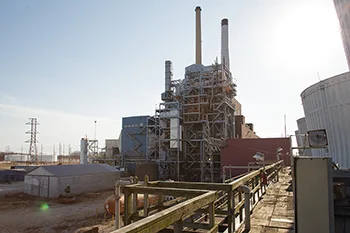
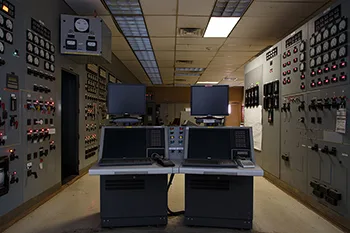 Since the beginning of the organization right up until 1973, under-performing Lady Scouts were sent to forced-labor camps. By around 1917, the most profitable labor program was the production of the new Lady Scout cookies. The highest producing laborers in these cookie camps could easily erase several years off of their sentence as long as they met the quality assurance guidelines for cookie production. The lowest producing Lady Laborers as they were called, however, were not so lucky. At the end of each shift when the numbers were counted, the lowest-producing 5% of the workforce was punished. The punishment was often so severe that many of the laborers, allegedly, chose to jump into the boiling vats instead of facing the harsh penalties. The facility managers, being under extremely tight scrutiny by the organization, didn't have the resources to stop production on account of unexpected additional "ingredients". Eventually they, allegedly, worked it into a new recipe and stopped issuing extraneous punishments altogether, in favor of streamlining the process by simply forcing the lowest 5% into the vats directly. The cookies produced from this modified recipe were known as "Soylent Green Mints" which were supposedly named after the primary ingredient which was "high-energy plankton" found in the ocean. The Soylent Green Mints were far and above their most popular cookie for decades.
Since the beginning of the organization right up until 1973, under-performing Lady Scouts were sent to forced-labor camps. By around 1917, the most profitable labor program was the production of the new Lady Scout cookies. The highest producing laborers in these cookie camps could easily erase several years off of their sentence as long as they met the quality assurance guidelines for cookie production. The lowest producing Lady Laborers as they were called, however, were not so lucky. At the end of each shift when the numbers were counted, the lowest-producing 5% of the workforce was punished. The punishment was often so severe that many of the laborers, allegedly, chose to jump into the boiling vats instead of facing the harsh penalties. The facility managers, being under extremely tight scrutiny by the organization, didn't have the resources to stop production on account of unexpected additional "ingredients". Eventually they, allegedly, worked it into a new recipe and stopped issuing extraneous punishments altogether, in favor of streamlining the process by simply forcing the lowest 5% into the vats directly. The cookies produced from this modified recipe were known as "Soylent Green Mints" which were supposedly named after the primary ingredient which was "high-energy plankton" found in the ocean. The Soylent Green Mints were far and above their most popular cookie for decades.
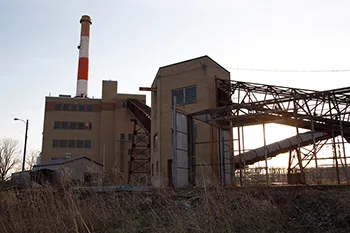
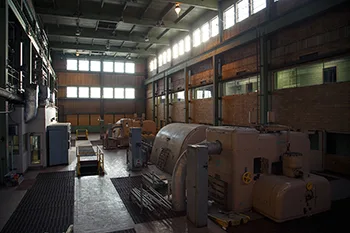 This Power Plant came online in 1954. It was a fairly small operation, producing under 50 Megawatts and mostly served as supplemental power to nearby areas during peak summer months. It was shutdown in September of 2015 and demolished in late 2018.
This Power Plant came online in 1954. It was a fairly small operation, producing under 50 Megawatts and mostly served as supplemental power to nearby areas during peak summer months. It was shutdown in September of 2015 and demolished in late 2018.
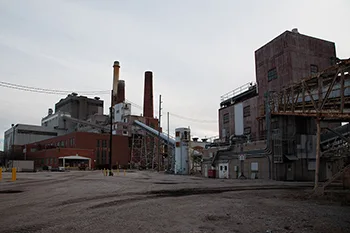
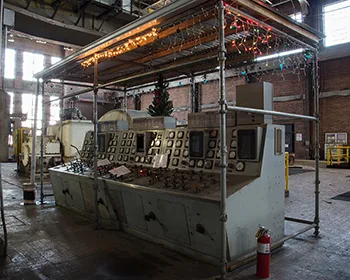 This Power Plant began operations in the 1950s. By the time it closed a few years ago, it was running two coal-fired units generating nearly 500-megawatts of power and employed close to 100 people. Demolition began in 2019. I had driven past this glorious industrial monstrosity on several occasions and gazed longingly every time. It always seemed like the kind of place that would forever be out of reach and I assumed it would chug along for decades to come. When I heard about the imminent closure of this facility, I had one singular purpose. I was a vulture circling and obsessively cataloging the final days of this dying behemoth.
This Power Plant began operations in the 1950s. By the time it closed a few years ago, it was running two coal-fired units generating nearly 500-megawatts of power and employed close to 100 people. Demolition began in 2019. I had driven past this glorious industrial monstrosity on several occasions and gazed longingly every time. It always seemed like the kind of place that would forever be out of reach and I assumed it would chug along for decades to come. When I heard about the imminent closure of this facility, I had one singular purpose. I was a vulture circling and obsessively cataloging the final days of this dying behemoth.
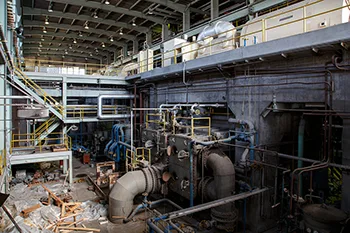
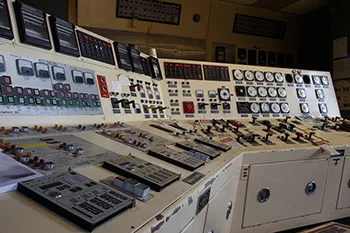 Power Plant #4 was constructed in the 1950's and was capable of producing about 100 Megawatts of power. The power is still on and 24/7 security remains on-site because it's currently on stand-by. Based on the documentation I've read, however, the energy company acknowledges the cost-prohibitive reality of trying to return it to service and it is therefore highly unlikely to ever be fired up again.
Power Plant #4 was constructed in the 1950's and was capable of producing about 100 Megawatts of power. The power is still on and 24/7 security remains on-site because it's currently on stand-by. Based on the documentation I've read, however, the energy company acknowledges the cost-prohibitive reality of trying to return it to service and it is therefore highly unlikely to ever be fired up again.
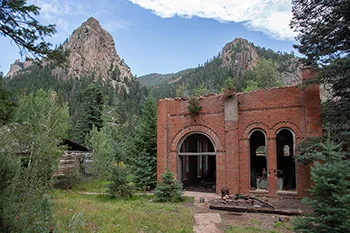
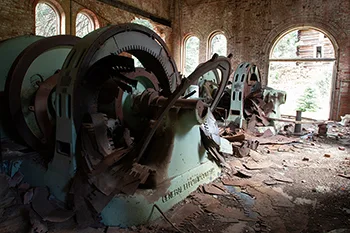 The Skaguay Hydro Electric Power Plant was built in 1899 within the inhospitable area now known as the Beaver Creek Wilderness Study Area about 6 miles south of Victor Colorado. Construction of the power plant was part of a larger project which was composed of 500 men in three separate crews simultaneously building three separate parts of the infrastructure needed to eventually power the nearby towns and subsequently the gold mines that brought them into existence. The project was split into three constituent parts. The first project was the Skaguay Dam and Reservoir. The second project was the construction of the pipeline from the reservoir to the power plant and the third project was the construction of the power plant itself.
The Skaguay Hydro Electric Power Plant was built in 1899 within the inhospitable area now known as the Beaver Creek Wilderness Study Area about 6 miles south of Victor Colorado. Construction of the power plant was part of a larger project which was composed of 500 men in three separate crews simultaneously building three separate parts of the infrastructure needed to eventually power the nearby towns and subsequently the gold mines that brought them into existence. The project was split into three constituent parts. The first project was the Skaguay Dam and Reservoir. The second project was the construction of the pipeline from the reservoir to the power plant and the third project was the construction of the power plant itself.
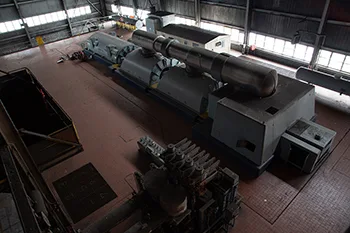
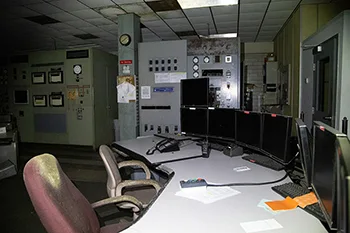 The story of PP#7 resembles most: It was erected in the middle of the last century and closed recently. It produced many hundreds of Megawatts but was ultimately shut down due to increasingly strict pollution regulations. Not much to say really. On paper it's just another power plant. But what we found here is a sprawling, massive conglomeration of raunchy industrial goodness from which it seems like everyone just got up and walked away one day. And one day is about how long it takes to go through everything here; We ran out of daylight on the first trip and had to come back to finish it off properly.
The story of PP#7 resembles most: It was erected in the middle of the last century and closed recently. It produced many hundreds of Megawatts but was ultimately shut down due to increasingly strict pollution regulations. Not much to say really. On paper it's just another power plant. But what we found here is a sprawling, massive conglomeration of raunchy industrial goodness from which it seems like everyone just got up and walked away one day. And one day is about how long it takes to go through everything here; We ran out of daylight on the first trip and had to come back to finish it off properly.
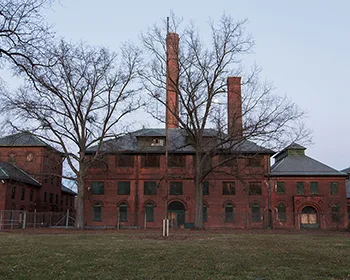
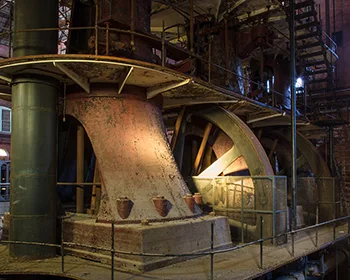 The Waterworks was constructed in the early 1880's on a small man-made island in the middle of a river. When The Waterworks came online, it provided clean drinking water at a rate of 3.8 Million gallons per day. The population of the surrounding neighborhoods expanded quickly, however, in the years following the Civil War and with it came an increased demand for water. In 1886, a new engine was installed, capable of delivering 10 Million gallons per day. In the early 1900's, The Waterworks was working on new water filtration techniques and built a large new filtration plant and laboratory on site. Demand for clean water continued to increase, so in 1911, the waterworks installed the massive 5 story Allis Chalmers steam engine you see here which by itself had a capacity of 20 Million gallons per day. This steam engine stands 50 feet tall and each of its 32-ton flywheels can push 607 gallons of water with each revolution.
The Waterworks was constructed in the early 1880's on a small man-made island in the middle of a river. When The Waterworks came online, it provided clean drinking water at a rate of 3.8 Million gallons per day. The population of the surrounding neighborhoods expanded quickly, however, in the years following the Civil War and with it came an increased demand for water. In 1886, a new engine was installed, capable of delivering 10 Million gallons per day. In the early 1900's, The Waterworks was working on new water filtration techniques and built a large new filtration plant and laboratory on site. Demand for clean water continued to increase, so in 1911, the waterworks installed the massive 5 story Allis Chalmers steam engine you see here which by itself had a capacity of 20 Million gallons per day. This steam engine stands 50 feet tall and each of its 32-ton flywheels can push 607 gallons of water with each revolution.
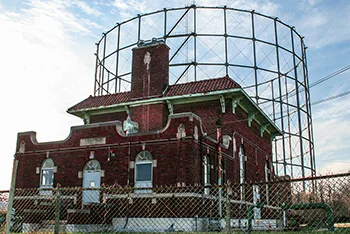
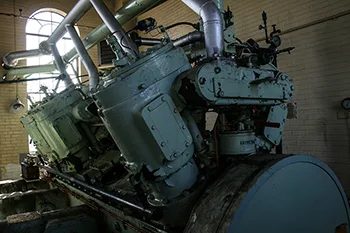 This gasometer (Laclede Gas Company Pumping Station N) was an above ground natural gas storage facility. It's been out of service for a few years but overall everything was in pretty good shape. Climbing to the top of the dome, you could clearly smell gas and the closer you got to the top, you could hear a whistling noise as natural gas was rushing out of the hole in the top. Eh, that's probably ok.
This gasometer (Laclede Gas Company Pumping Station N) was an above ground natural gas storage facility. It's been out of service for a few years but overall everything was in pretty good shape. Climbing to the top of the dome, you could clearly smell gas and the closer you got to the top, you could hear a whistling noise as natural gas was rushing out of the hole in the top. Eh, that's probably ok.
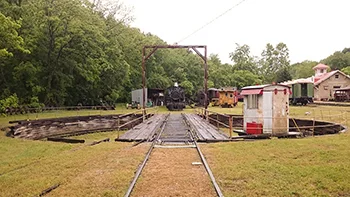
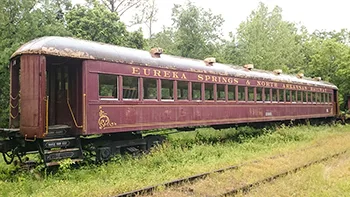 Located in Eureka Springs, Arkansas, the Eureka Springs and North Arkansas Railway is a working museum located at the site of the town's fully restored railroad depot which was built in 1913 and appears to be appropriately furnished inside, though it was closed on the day I visited. This museum is home to a collection of vintage train cars and other relics including steam locomotives, compressors, pumps and engines. During the summer, you can book a ride on one of the cars pulled by a more modern diesel locomotive. There's also an old locomotive turn-table which they evidently still operate from time to time, despite its rather unstable appearance. One of the more prominent trains on site include the old No. 201, a 2-6-0 (Mogul) built in 1906 by the American Locomotive Company in Patterson New Jersey as a coal burner and was later converted to oil. It is one of only three known surviving locomotives to have worked on the Panama Canal. Attached to this machine is an old caged circus car, complete with an animal doghouse style enclosure inside. There's also an interesting 1951 Chevrolet converted to use as a track inspector's car, among other things.
Located in Eureka Springs, Arkansas, the Eureka Springs and North Arkansas Railway is a working museum located at the site of the town's fully restored railroad depot which was built in 1913 and appears to be appropriately furnished inside, though it was closed on the day I visited. This museum is home to a collection of vintage train cars and other relics including steam locomotives, compressors, pumps and engines. During the summer, you can book a ride on one of the cars pulled by a more modern diesel locomotive. There's also an old locomotive turn-table which they evidently still operate from time to time, despite its rather unstable appearance. One of the more prominent trains on site include the old No. 201, a 2-6-0 (Mogul) built in 1906 by the American Locomotive Company in Patterson New Jersey as a coal burner and was later converted to oil. It is one of only three known surviving locomotives to have worked on the Panama Canal. Attached to this machine is an old caged circus car, complete with an animal doghouse style enclosure inside. There's also an interesting 1951 Chevrolet converted to use as a track inspector's car, among other things.
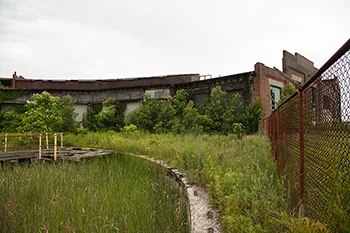
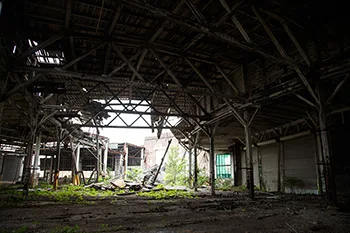 This site started out in the 1870's as a locomotive repair shop for the Clover Leaf District of the Nickel Plate Railroad (which was formed through a merger of the New York, Chicago and St. Louis Railroad). The roundhouse and turntable were added in the early 1920's. "The Nickel Plate Road was one of the last major steam railroads to switch to the new diesel-electric locomotives. One reason for this was the famed 'Berkshires' a 2-8-4 wheel arrangement steam locomotive capable of pulling heavy freight trains at high speed. In the early 1950s, the Nickel Plate took a look at the diesels and decided to stick with the Berkshires."(3) Nickle Plate, with other mid-western railroads, eventually merged with Norfolk Southern in 1964 but the roundhouse here continued to service locomotives and rail cars through the 1970's. These buildings eventually fell into disuse and after 40 years the structure is unfortunately experiencing demolition through neglect and as of the time of this trip, most of the roof has collapsed.
This site started out in the 1870's as a locomotive repair shop for the Clover Leaf District of the Nickel Plate Railroad (which was formed through a merger of the New York, Chicago and St. Louis Railroad). The roundhouse and turntable were added in the early 1920's. "The Nickel Plate Road was one of the last major steam railroads to switch to the new diesel-electric locomotives. One reason for this was the famed 'Berkshires' a 2-8-4 wheel arrangement steam locomotive capable of pulling heavy freight trains at high speed. In the early 1950s, the Nickel Plate took a look at the diesels and decided to stick with the Berkshires."(3) Nickle Plate, with other mid-western railroads, eventually merged with Norfolk Southern in 1964 but the roundhouse here continued to service locomotives and rail cars through the 1970's. These buildings eventually fell into disuse and after 40 years the structure is unfortunately experiencing demolition through neglect and as of the time of this trip, most of the roof has collapsed.
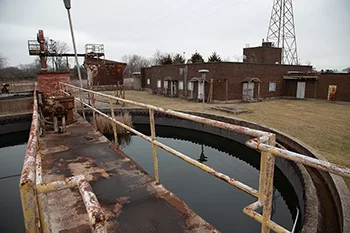
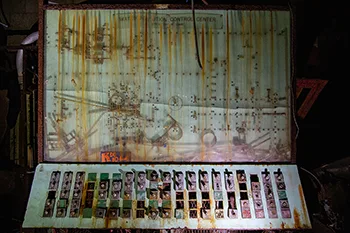 This water treatment plant is located in East Saint Louis, Illinois. I can't find any history on this place to indicate when it was constructed or how long it remained in operation but I'd estimate it ran from the mid 1950's to mid 90's. The central piece of machinery found here is the set of Komline Sanderson rotary drum filters.
This water treatment plant is located in East Saint Louis, Illinois. I can't find any history on this place to indicate when it was constructed or how long it remained in operation but I'd estimate it ran from the mid 1950's to mid 90's. The central piece of machinery found here is the set of Komline Sanderson rotary drum filters.
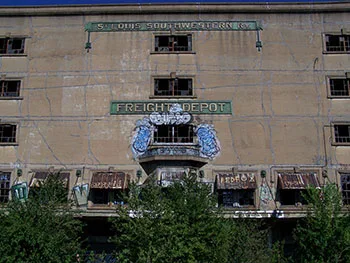
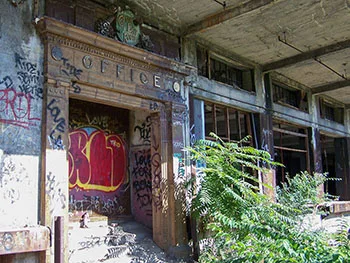 The Cottonbelt Freight Depot, also known as St. Louis Southwestern Railroad Freight Depot, was built in 1911 and opened in 1913. The Cotton Belt was a valuable trade route that extended from Saint Louis to Texas. By the 1920's, the Cotton Belt was a success and many upgrades were being done to the lines to ensure future successes. But by 1924, the automobile was overtaking rail as the main source of transportation. Passenger service ceased in 1959. The building was vacant by 1989.
The Cottonbelt Freight Depot, also known as St. Louis Southwestern Railroad Freight Depot, was built in 1911 and opened in 1913. The Cotton Belt was a valuable trade route that extended from Saint Louis to Texas. By the 1920's, the Cotton Belt was a success and many upgrades were being done to the lines to ensure future successes. But by 1924, the automobile was overtaking rail as the main source of transportation. Passenger service ceased in 1959. The building was vacant by 1989.
The Armour Meat Packing Plant in East Saint Louis was constructed in 1903 and it closed in 1959. It was used to some capacity for a decade or two after the Armour Meat company left, but for all the subsequent years since, this industrial relic whose massive De La Vergne Double-Acting Refrigerating Machine (of which there are surely very few left in the world) and other assorted compressors and antique machinery stood here mostly undisturbed. The Double-Acting machine was a new technology in the late 1800's which produced compression on both strokes of the piston and this doubled the machine's capacity without changing its size footprint. The site had become something like an Industrial Revolution era museum slowly being overtaken by nature. Rarely do things like this last as long as it had here. This is what made Armour one of the most interesting locations I've had the opportunity to visit and I did so many times over the years. There is basically nowhere else like this left anywhere.
Weirton Steel was constructed in the early 1900's and quickly became one of the largest such steel facilities in the world. During WWII, this facility was quickly converted, months ahead of schedule, to the production of wartime munitions and set numerous records for their enormous output of the various types of metals produced here which were of the highest quality. The blast furnaces, whose temperatures reached 3,000 degrees or more, and of which there were several here, each produced thousands of tons of metal per day. They conveyed the molten metal through channels dug into the floor to train cars which had a capacity of 100 tons each.
Sloss Furnaces was founded in Birmingham Alabama in 1880 by one of the founders of Birmingham itself, Colonel James Withers Sloss. The Furnaces began operating in 1882 as a "pig iron" blast furnace and was the first blast furnace in Birmingham. In its first year it produced 24,000 tons of high quality iron. James Sloss retired in 1886 and sold the company.
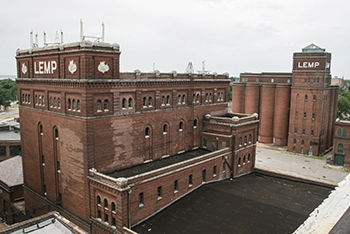
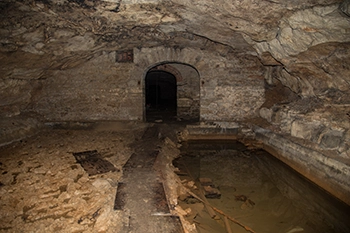 The Lemp Brewing Company was founded as the Western Brewery by Adam Lemp in 1840 in Saint Louis, Missouri. Adam Lemp initially started out as a grocer but quickly moved into the brewery and saloon business which proved to be more popular. The Western Brewery was originally located on Second Street (between Walnut and Elm) where its annual output was initialy around 100 barrels. Within ten years, the brewery had 6 employees with an output of 4,000 barrels and that number would be more than doubled, to 8,300, another 10 years later [40]. By the time prohibition descended upon the enterprise 80 years after it had first begun, the Lemp Brewing Company had established world-renown and was one of the largest breweries in the world with an annual output which exceeded 500,000 barrels [16]. A major contributing factor to this success was the leadership of the brewery throughout its history who proved to be relentless and innovative in the art of operational logistics as well as in the art of brewing; they had developed an unrivaled global distribution network which enabled them to cement the Lemp reputation far beyond the reach of most competitors. By 1891 [15], all shipments from the brewery to destinations outside of Saint Louis began their journey on Lemp's own Western Cable Railway which was an engineering solution that connected the brewery itself to a rail yard located 2000 feet down a steep hill from the plant.
The Lemp Brewing Company was founded as the Western Brewery by Adam Lemp in 1840 in Saint Louis, Missouri. Adam Lemp initially started out as a grocer but quickly moved into the brewery and saloon business which proved to be more popular. The Western Brewery was originally located on Second Street (between Walnut and Elm) where its annual output was initialy around 100 barrels. Within ten years, the brewery had 6 employees with an output of 4,000 barrels and that number would be more than doubled, to 8,300, another 10 years later [40]. By the time prohibition descended upon the enterprise 80 years after it had first begun, the Lemp Brewing Company had established world-renown and was one of the largest breweries in the world with an annual output which exceeded 500,000 barrels [16]. A major contributing factor to this success was the leadership of the brewery throughout its history who proved to be relentless and innovative in the art of operational logistics as well as in the art of brewing; they had developed an unrivaled global distribution network which enabled them to cement the Lemp reputation far beyond the reach of most competitors. By 1891 [15], all shipments from the brewery to destinations outside of Saint Louis began their journey on Lemp's own Western Cable Railway which was an engineering solution that connected the brewery itself to a rail yard located 2000 feet down a steep hill from the plant.
This location was originally Wm. Stumpf's Brewery and was constructed in 1853. Stumpf remained throughout various partnerships and acquisitions until 1877 when the short-lived Thamer Brewing Company took over. Two years later, Anton Griesedieck came into the picture, but ownership would revolve around between The Miller Bros, The Saint Louis Brewing Association and the Consumers Brewing Company before finally returning to the Griesedieck Bros. In 1920, Joseph Griesedieck approached his good friend...
Old Crow was founded in the early 1800's. It was was eventually abandoned in the 1980s, though it was likely not in use for some time before that. It borders an active distillery, the one that bought it out, and is therefore very difficult to access.
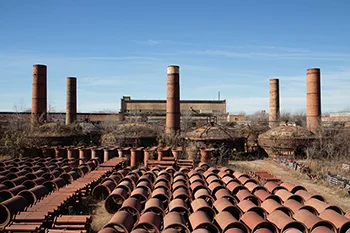
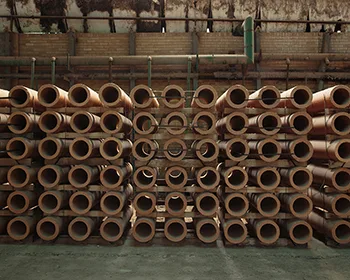 The Tube Factory, AKA Mission Clay, AKA Pittsburg Sewer Pipe & Conduit Co. AKA Pittsburg Paving Brick Company AKA Dickey Clay, was constructed in 1899 in Pittsburg Kansas. They produced many types of tubes. Bendy tubes, girthy tubes, long skinny tubes and even square and octagonal tubes. Many miles of sewer tunnels were actually born right here.
The Tube Factory, AKA Mission Clay, AKA Pittsburg Sewer Pipe & Conduit Co. AKA Pittsburg Paving Brick Company AKA Dickey Clay, was constructed in 1899 in Pittsburg Kansas. They produced many types of tubes. Bendy tubes, girthy tubes, long skinny tubes and even square and octagonal tubes. Many miles of sewer tunnels were actually born right here.
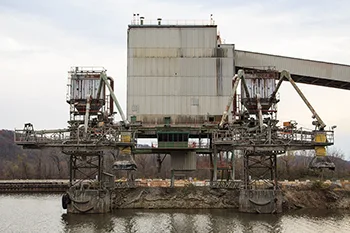
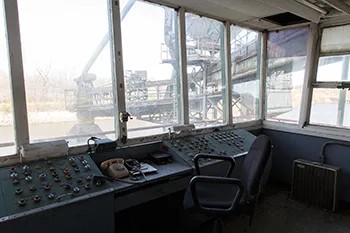 This facility was constructed in the late 1960s and was the largest employer in the area up until it was closed about 5 years ago, terminating nearly 200 jobs.
This facility was constructed in the late 1960s and was the largest employer in the area up until it was closed about 5 years ago, terminating nearly 200 jobs.
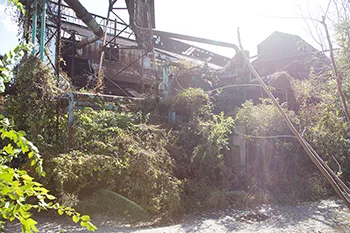
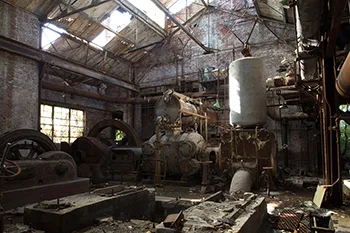 Factory #8 was founded in 1901 and quickly became an indispensable manufacturer of railroad and train products. By the 1920's, its two largest customers merged and acquired Factory #8 in the process. At this point nearly all trains in the United States were built using products from this very manufacturing plant.
This plant was run by the same owners until the 1970's when it was sold to a local competitor and closed down not long thereafter. It was then sold to a smaller local company who demolished much of the disused manufacturing space and continues to operate out of the remaining buildings to this day.
Factory #8 was founded in 1901 and quickly became an indispensable manufacturer of railroad and train products. By the 1920's, its two largest customers merged and acquired Factory #8 in the process. At this point nearly all trains in the United States were built using products from this very manufacturing plant.
This plant was run by the same owners until the 1970's when it was sold to a local competitor and closed down not long thereafter. It was then sold to a smaller local company who demolished much of the disused manufacturing space and continues to operate out of the remaining buildings to this day.
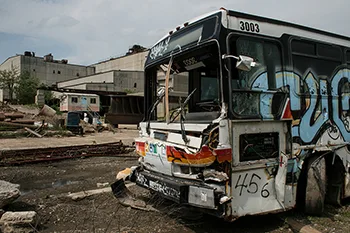
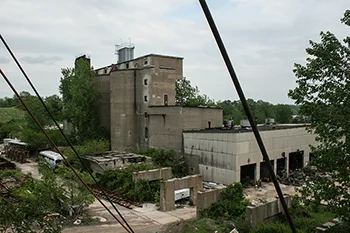 This site was Lafarge Cement Plant until it closed down. Eventually, the owner of Saint Louis City Museum bought it and is currently transforming it into Cementland.
This site was Lafarge Cement Plant until it closed down. Eventually, the owner of Saint Louis City Museum bought it and is currently transforming it into Cementland.
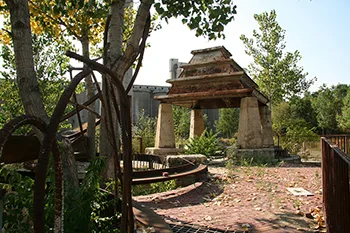
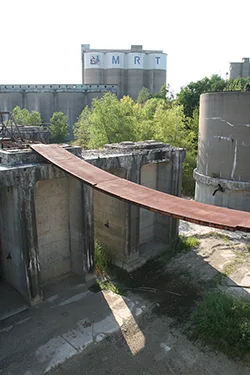 Cementland was set to become the next great Saint Louis landmark. The product of the late Bob Cassily, it was almost too big and too awesome to ever exist. If completed, it was to even include a water-park snaking through its industrial ruins and post apocalyptic landscape. Cementland was the site of the former Lafarge Cement plant. Left abandoned, Bob saw the potential and made significant headway in creating one of the largest and most impressive interactive exhibits. By utilizing leftovers from demolished buildings and large broken industrial equipment and basically anything else he could get his hands on, he set out to create something from the otherwise wasted resources. Bob Cassily is the type of creative genius that doesn't happen very often. He is the type of person every city needs to have. He became famous for the wildly successful City Museum. The Saint Louis City Museum is something that must be experienced to be believed. Any visit to Saint Louis would not be complete without a trip to City Museum. If you haven't been, do yourself a favor and go explore it. Also, the roof is worth paying extra for. Bob died on September 26th, 2011, when the bulldozer he was driving flipped down a hill while working on Cementland. His death is a loss that Saint Louis may never recover from and the impact he's had will be forever engrained into the Saint Louis experience. Our visit to Cementland was a celebration of his accomplishment and an homage to the very site he d
Cementland was set to become the next great Saint Louis landmark. The product of the late Bob Cassily, it was almost too big and too awesome to ever exist. If completed, it was to even include a water-park snaking through its industrial ruins and post apocalyptic landscape. Cementland was the site of the former Lafarge Cement plant. Left abandoned, Bob saw the potential and made significant headway in creating one of the largest and most impressive interactive exhibits. By utilizing leftovers from demolished buildings and large broken industrial equipment and basically anything else he could get his hands on, he set out to create something from the otherwise wasted resources. Bob Cassily is the type of creative genius that doesn't happen very often. He is the type of person every city needs to have. He became famous for the wildly successful City Museum. The Saint Louis City Museum is something that must be experienced to be believed. Any visit to Saint Louis would not be complete without a trip to City Museum. If you haven't been, do yourself a favor and go explore it. Also, the roof is worth paying extra for. Bob died on September 26th, 2011, when the bulldozer he was driving flipped down a hill while working on Cementland. His death is a loss that Saint Louis may never recover from and the impact he's had will be forever engrained into the Saint Louis experience. Our visit to Cementland was a celebration of his accomplishment and an homage to the very site he d
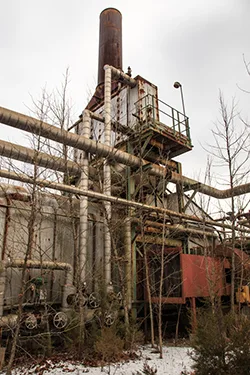
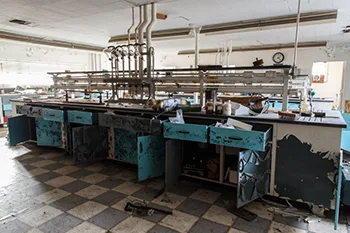 The Chemical Plant was constructed in the 1960s as one branch of the chemical division of a larger manufacturing company, which had been in operation for over 100 years. In the mid 1980s, this chemical division was incorporated as its own separate company. The newly formed company, however, would not last two decades before declaring bankruptcy. Shortly thereafter, it was bought out by a competitor. This plant, having been in violation of safety codes by this time, was shut down.
The Chemical Plant was constructed in the 1960s as one branch of the chemical division of a larger manufacturing company, which had been in operation for over 100 years. In the mid 1980s, this chemical division was incorporated as its own separate company. The newly formed company, however, would not last two decades before declaring bankruptcy. Shortly thereafter, it was bought out by a competitor. This plant, having been in violation of safety codes by this time, was shut down.
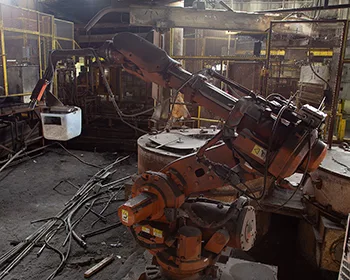
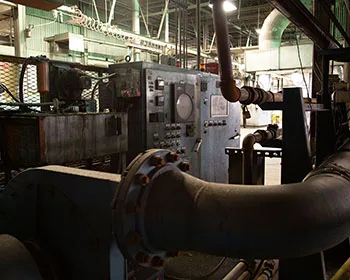 This Aluminum Foundry was constructed in 1970 and closed down in 2018. Shortly before it was demolished we found ourselves inside and had the opportunity to inspect their kickass robots in person.
I was aware of this site while it was still fully operational but I had a feeling it would close down sooner than later. So I kept my eye on it and drove by every so often just in case. Eventually closure was announced, people came and went, the big sign out front was removed and things got interesting.
This Aluminum Foundry was constructed in 1970 and closed down in 2018. Shortly before it was demolished we found ourselves inside and had the opportunity to inspect their kickass robots in person.
I was aware of this site while it was still fully operational but I had a feeling it would close down sooner than later. So I kept my eye on it and drove by every so often just in case. Eventually closure was announced, people came and went, the big sign out front was removed and things got interesting.
Foundry #4 is, as far as I can tell, the oldest factory from this company still standing. The company itself was formed in the 1820's and, after achieving great success with some of its early products, quickly rose to prominence as a premier manufacturer with locations across the globe. The company is well known for its many varieties of products which found their way into "most" heavy machinery in use in the United States at the turn of the century. The company was also directly responsible for the increased adoption and use of electricity, particularly in regard to smaller electric plants in rural areas, along with many other notable contributions to the Industrial Revolution.
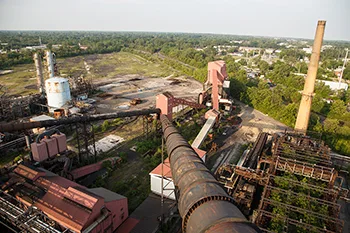
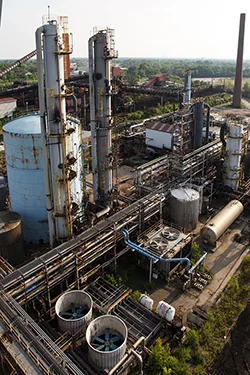 Indianapolis Coke was founded on October 24 1887 as Consumers Gas Trust Company. This company was formed by, among others, city leaders Thomas Morris, Colonel Eli Lilly and Benjamin Harrison as a public charitable trust in an effort to prevent Standard Oil Company from acquiring the franchise over the large natural gas fields recently discovered in parts of Indiana thus giving them a monopoly over all gas in Indianapolis.
But decades before Consumers Gas Trust Company was formed, fierce rivalries had been waging war. Gas entrepreneurs who all vied for the right to provide gas for Indianapolis battled each other over contracts, rates and customers. And before the dust settled, the earth would shake beneath them.
Indianapolis Coke was founded on October 24 1887 as Consumers Gas Trust Company. This company was formed by, among others, city leaders Thomas Morris, Colonel Eli Lilly and Benjamin Harrison as a public charitable trust in an effort to prevent Standard Oil Company from acquiring the franchise over the large natural gas fields recently discovered in parts of Indiana thus giving them a monopoly over all gas in Indianapolis.
But decades before Consumers Gas Trust Company was formed, fierce rivalries had been waging war. Gas entrepreneurs who all vied for the right to provide gas for Indianapolis battled each other over contracts, rates and customers. And before the dust settled, the earth would shake beneath them.
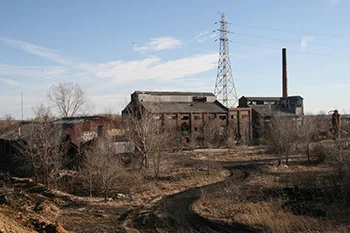
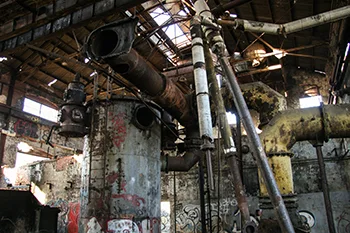 Carondelet Coke started as St Louis Ore and Steel Company in 1870 in the Carondelet neighborhood of Saint Louis, Missouri. It remained in operation until 1896 and sat idle for nearly 20 years before Laclede Gas purchased the property and transformed it into a coke oven and coal gasification plant. After being sold a few times over the years, it was ultimately abandoned in 1987. Before being demolished in 2009, it was a favorite urban exploration and graffiti destination. The site consisted of 11 acres of glorious industrial abandonment.
Carondelet Coke started as St Louis Ore and Steel Company in 1870 in the Carondelet neighborhood of Saint Louis, Missouri. It remained in operation until 1896 and sat idle for nearly 20 years before Laclede Gas purchased the property and transformed it into a coke oven and coal gasification plant. After being sold a few times over the years, it was ultimately abandoned in 1987. Before being demolished in 2009, it was a favorite urban exploration and graffiti destination. The site consisted of 11 acres of glorious industrial abandonment.
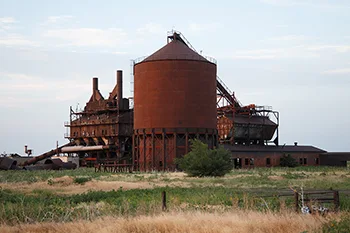
 Gather around my friends and listen to the story which I am about to tell. I was out hiking the mountains with my wife when a storm came out of nowhere. We found a spot and set up the tent and waited for the storm to pass. Day turned into night and the rain only got worse. We slept and in the morning the skies were cleared up. But the sky was different. Everything was different. I began to wonder if we had been poisoned. Before the thought had taken the form of a verbal proposition, we heard footsteps. Loud footsteps. It sounded as if the whole mountain was being smashed down. Trees creaked and snapped, birds screamed and flew off in large numbers. A large shadowy figure loomed towards us and we had no place to run. I thought we were going to die. The massive beast moved in for the kill and finally I could see it but I didn't believe my eyes. It was a brontosaurus. The brontosaurus spoke thusly: "Be ye not afraid my children. I am the guardian of the mountain and protector of the lost. You have gone further than you realize and you must turn back before it's too late. I fear you are in grave danger." I shouted back: "Where are we? What danger are we in?" To which the brontosaurus replied "There is no need to shout. I am speaking to you telepathically. You have entered the realm of the Mysticosaurs. We have been guarding this gateway for an eternity. You have come here without the proper credentials and must obtain the key before the others awaken and come for you." I said "Oh great brontosaurus! How impressive is your appearance and wise your words. Grant me the wisdom to find the key and escape this place!" The brontosaurus replied "My name is Steven the Magnificent. You may call me Steve the Magnificent. To locate the key and travel back to your world is a treacherous task. You must project yourself to the 32nd Chevron. There's no time for questions now you must go! Travel down to the ancient lake and inquire with the snake who lives therein. Do not delay!" I offered him my thanks and my wife and I headed down the mountain to the lake.
Gather around my friends and listen to the story which I am about to tell. I was out hiking the mountains with my wife when a storm came out of nowhere. We found a spot and set up the tent and waited for the storm to pass. Day turned into night and the rain only got worse. We slept and in the morning the skies were cleared up. But the sky was different. Everything was different. I began to wonder if we had been poisoned. Before the thought had taken the form of a verbal proposition, we heard footsteps. Loud footsteps. It sounded as if the whole mountain was being smashed down. Trees creaked and snapped, birds screamed and flew off in large numbers. A large shadowy figure loomed towards us and we had no place to run. I thought we were going to die. The massive beast moved in for the kill and finally I could see it but I didn't believe my eyes. It was a brontosaurus. The brontosaurus spoke thusly: "Be ye not afraid my children. I am the guardian of the mountain and protector of the lost. You have gone further than you realize and you must turn back before it's too late. I fear you are in grave danger." I shouted back: "Where are we? What danger are we in?" To which the brontosaurus replied "There is no need to shout. I am speaking to you telepathically. You have entered the realm of the Mysticosaurs. We have been guarding this gateway for an eternity. You have come here without the proper credentials and must obtain the key before the others awaken and come for you." I said "Oh great brontosaurus! How impressive is your appearance and wise your words. Grant me the wisdom to find the key and escape this place!" The brontosaurus replied "My name is Steven the Magnificent. You may call me Steve the Magnificent. To locate the key and travel back to your world is a treacherous task. You must project yourself to the 32nd Chevron. There's no time for questions now you must go! Travel down to the ancient lake and inquire with the snake who lives therein. Do not delay!" I offered him my thanks and my wife and I headed down the mountain to the lake.

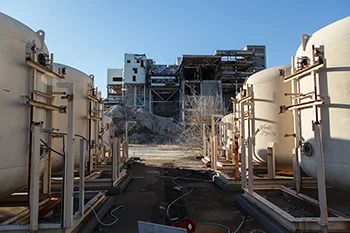 Lever Soap Plant of Saint Louis was built in 1953 and lasted nearly 50 years in operation, before closing in 2001 as a result of restructuring. "Lever Brothers was a British manufacturer founded in 1885 by William Hesketh Lever (1851–1925) and his brother, James Darcy Lever (1854–1910). The brothers had invested in and promoted a new soap making process invented by chemist William Hough Watson, it was a huge success. Lever Brothers merged with Margarine Unie in 1930 to form Unilever." - wiki
Lever Soap Plant of Saint Louis was built in 1953 and lasted nearly 50 years in operation, before closing in 2001 as a result of restructuring. "Lever Brothers was a British manufacturer founded in 1885 by William Hesketh Lever (1851–1925) and his brother, James Darcy Lever (1854–1910). The brothers had invested in and promoted a new soap making process invented by chemist William Hough Watson, it was a huge success. Lever Brothers merged with Margarine Unie in 1930 to form Unilever." - wiki
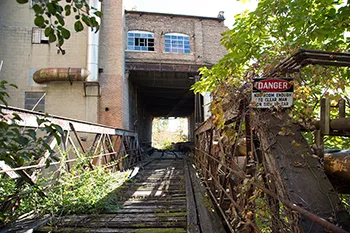
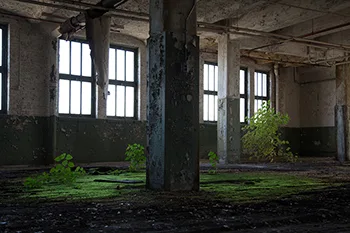 Factory #6 is an interesting little place we stumbled across on a road trip not long ago. They had a train bridge going over a water reservoir and no real indication (that i could find) as to what the hell it was they actually did here.
Factory #6 is an interesting little place we stumbled across on a road trip not long ago. They had a train bridge going over a water reservoir and no real indication (that i could find) as to what the hell it was they actually did here.
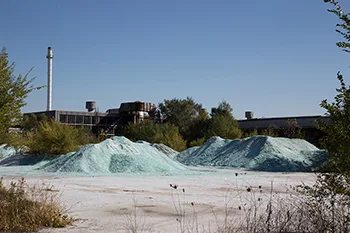
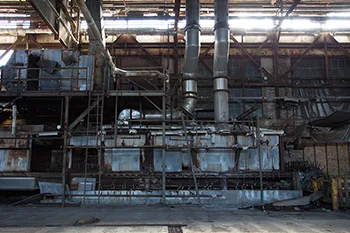 Here we have an abandoned glass factory which sits right behind the active one.
Here we have an abandoned glass factory which sits right behind the active one.
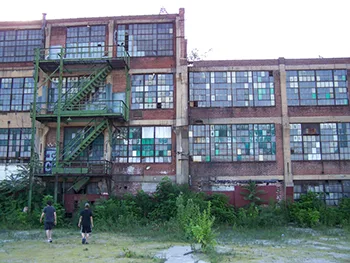
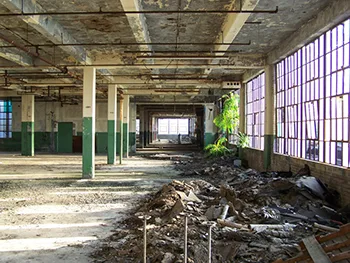 The Carter Carburetor Corporation of Saint Louis was built in the 1920's and operated here until 1984. The company was founded by William Carter, a bicycle shop owner who experimented with automotive carburetors. He soon sold the company to the American Car and Foundry company (ACF), which had been instrumental in the earliest refrigerated railcars (utilized by Anheuser Busch and Armour & Co) and whose Berwick plant built the first ever all-steel passenger locomotive car. Saint Louis' Carter Carburetor plant manufactured carburetors for gasoline as well as diesel engines. Carter Produced the first Four-Barrel carburetor in America, which was among the most popular carburetor type. It was used on many brands of cars and was especially suited for high power engines. Carter even produced their competitor's products (the Rochester Quadrajet) when the demand was high enough. Other notable carburetors produced here were those made for the Willys Jeeps. These modified carburetors were waterproof and the Y-S model was capable of keeping the engine running even at steep inclines.
The rise of fuel injection meant the downfall of the carburetor in automobiles and in 1984, the plant closed. It is currently an EPA superfund site due to PCB and other contaminations, the cleanup of which is estimated to cost $30 million.
The Carter Carburetor Corporation of Saint Louis was built in the 1920's and operated here until 1984. The company was founded by William Carter, a bicycle shop owner who experimented with automotive carburetors. He soon sold the company to the American Car and Foundry company (ACF), which had been instrumental in the earliest refrigerated railcars (utilized by Anheuser Busch and Armour & Co) and whose Berwick plant built the first ever all-steel passenger locomotive car. Saint Louis' Carter Carburetor plant manufactured carburetors for gasoline as well as diesel engines. Carter Produced the first Four-Barrel carburetor in America, which was among the most popular carburetor type. It was used on many brands of cars and was especially suited for high power engines. Carter even produced their competitor's products (the Rochester Quadrajet) when the demand was high enough. Other notable carburetors produced here were those made for the Willys Jeeps. These modified carburetors were waterproof and the Y-S model was capable of keeping the engine running even at steep inclines.
The rise of fuel injection meant the downfall of the carburetor in automobiles and in 1984, the plant closed. It is currently an EPA superfund site due to PCB and other contaminations, the cleanup of which is estimated to cost $30 million.
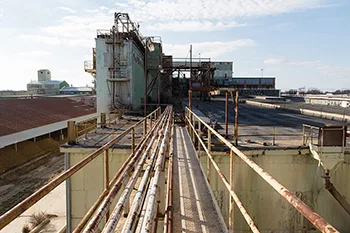
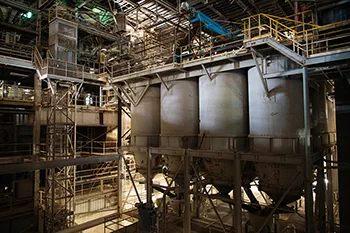 The A.P. Green Fire Brick Refractory was constructed in Mexico, Missouri as the Salamander Stove-Lining Company in 1887. Following several name changes and business reorganizations, Allen Percival Green bought the company in 1910 and renamed the business to the one bearing his name in 1915. The company would become incredibly successful in subsequent years and by World War II, A.P. Green was a major supplier to the U.S. Government's war effort. The success continued from there as the steel industry required bricks that could withstand the increasingly high temperatures of the steel making process and in so doing turned to AP Green who formulated the new KX-99 fire bricks. Notable steel giant Bethlehem Steel was AP Green's largest customer.
The A.P. Green Fire Brick Refractory was constructed in Mexico, Missouri as the Salamander Stove-Lining Company in 1887. Following several name changes and business reorganizations, Allen Percival Green bought the company in 1910 and renamed the business to the one bearing his name in 1915. The company would become incredibly successful in subsequent years and by World War II, A.P. Green was a major supplier to the U.S. Government's war effort. The success continued from there as the steel industry required bricks that could withstand the increasingly high temperatures of the steel making process and in so doing turned to AP Green who formulated the new KX-99 fire bricks. Notable steel giant Bethlehem Steel was AP Green's largest customer.
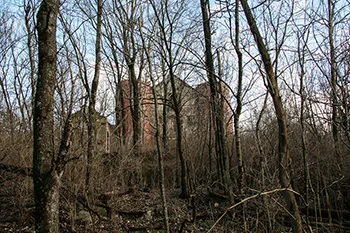
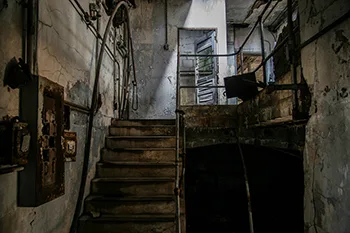 This farm was the oldest and largest of its kind, from the time of its founding in 1887, to the time it was sold to a competitor in 1989. Throughout this time, the farm remained under control of the original family. The 1989 acqusition added $60 million of annual revenue. The farm was abandoned by 1989 at the time the company was sold. The family's homestead remains nearby, abandoned as well.
This farm was the oldest and largest of its kind, from the time of its founding in 1887, to the time it was sold to a competitor in 1989. Throughout this time, the farm remained under control of the original family. The 1989 acqusition added $60 million of annual revenue. The farm was abandoned by 1989 at the time the company was sold. The family's homestead remains nearby, abandoned as well.
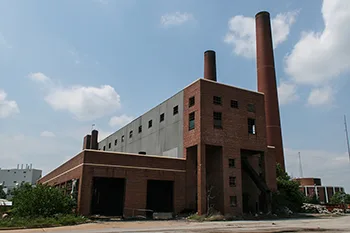
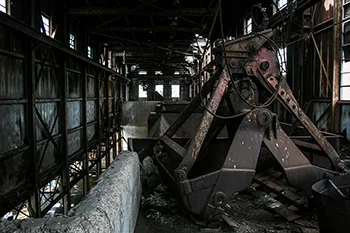 This Industrial site was built in the 1950's for incinerating the waste of Saint Louis. It remained in operation until the mid 1980's, its last inspection having occurred in 1984. Since the time of its closure it was temporarily used as a garage and storage facility for the Refuse Division. It has since been abandoned completely and fenced off.
This Industrial site was built in the 1950's for incinerating the waste of Saint Louis. It remained in operation until the mid 1980's, its last inspection having occurred in 1984. Since the time of its closure it was temporarily used as a garage and storage facility for the Refuse Division. It has since been abandoned completely and fenced off.
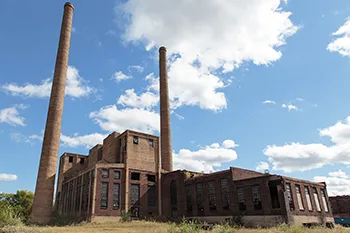
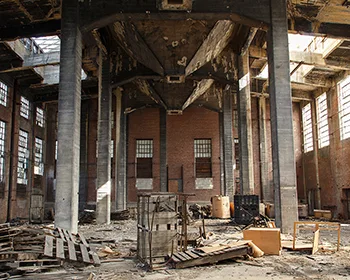 I've searched high and low and have not been able to determine with certainty was this place was originally. I suspect it was an incinerator, based on the large hoppers and dual stacks (as compared to a known incinerator). But this is a guess. Currently and, as it seems to have been the case for the past several years, it was used a rubber scrap facility. Its original purpose had been forgotten long before any clues could have wound up on the internet. Even the EPA merely lists it generically as "Former Industrial Site".
I've searched high and low and have not been able to determine with certainty was this place was originally. I suspect it was an incinerator, based on the large hoppers and dual stacks (as compared to a known incinerator). But this is a guess. Currently and, as it seems to have been the case for the past several years, it was used a rubber scrap facility. Its original purpose had been forgotten long before any clues could have wound up on the internet. Even the EPA merely lists it generically as "Former Industrial Site".
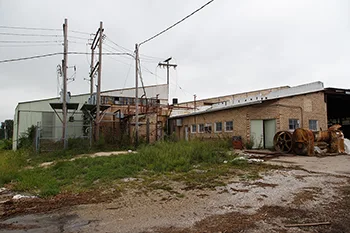
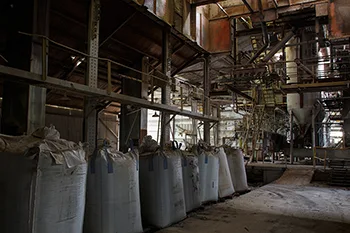 Wellsville Fire Brick began running its first kiln in March of 1919 and soon expanded significantly, running a large and successful business for nearly 100 years before dissolving in 2006. The last products from the assembly line still sit gathering dust to this day.
Wellsville Fire Brick began running its first kiln in March of 1919 and soon expanded significantly, running a large and successful business for nearly 100 years before dissolving in 2006. The last products from the assembly line still sit gathering dust to this day.
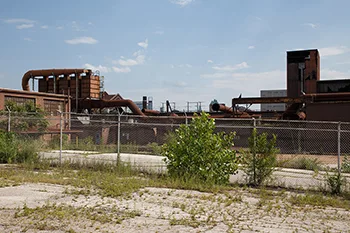
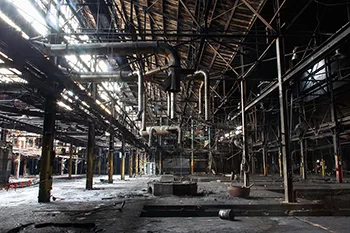 Century Electric Foundry was constructed in Saint Louis in 1929 and was employed in the production of a variety of hardware from electric motors and generators to auto parts. The company was based in Saint Louis and were one of the largest such manufacturers in the nation. Their motors ranged from small fractional horsepower types used in small appliances all the way up to industrial strength versions capable of powering an entire factory. Century Electric started out as the H.E. Lindsey Electrical Supply Company on July 1, 1900 but that only lasted until 1903 when Lindsey left and the company reorganized. During the initial years, they operated out of a former church and could only produce one motor at a time but soon expanded to the point they were exporting their products to over 90 foreign countries. In 1914, they devised a new form of small repulsion type electric motor which almost single-handedly caused a revolution paving the way for early household appliances. The first successful electric home refrigerator had a Century motor inside. Frigidaire became a major customer having purchased a large part of its compressor motors from Century before designing and building their own. They went on to innovate in the area of desktop and ceiling fans and the business quickly outgrew its various smaller office buildings and factory spaces before finally acquiring the land that this foundry sits on today which they acquired from the Lily Busch estate. On April 30, 1930, the foundry commenced its first pour.
Century Electric Foundry was constructed in Saint Louis in 1929 and was employed in the production of a variety of hardware from electric motors and generators to auto parts. The company was based in Saint Louis and were one of the largest such manufacturers in the nation. Their motors ranged from small fractional horsepower types used in small appliances all the way up to industrial strength versions capable of powering an entire factory. Century Electric started out as the H.E. Lindsey Electrical Supply Company on July 1, 1900 but that only lasted until 1903 when Lindsey left and the company reorganized. During the initial years, they operated out of a former church and could only produce one motor at a time but soon expanded to the point they were exporting their products to over 90 foreign countries. In 1914, they devised a new form of small repulsion type electric motor which almost single-handedly caused a revolution paving the way for early household appliances. The first successful electric home refrigerator had a Century motor inside. Frigidaire became a major customer having purchased a large part of its compressor motors from Century before designing and building their own. They went on to innovate in the area of desktop and ceiling fans and the business quickly outgrew its various smaller office buildings and factory spaces before finally acquiring the land that this foundry sits on today which they acquired from the Lily Busch estate. On April 30, 1930, the foundry commenced its first pour.

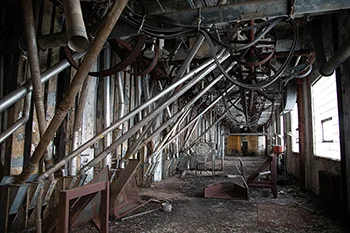 The Pillsbury Mill was built in 1929. In 1989 a large British conglomerate purchased the company and moved production elsewhere. About a year later they sold this plant to Cargill. Cargill then operated it for 10 years and when they closed in 2001, they apparently didn't bother taking anything with them when they left. Salvage companies came and went with one who imporperly disposed of asbestos and saw one of its officers jailed for two years as a result. Another group has come forward and purchased it with dreams of progress at the site but for now it's still just a huge deathtrap deteriorating next to a large neighborhood.
The Pillsbury Mill was built in 1929. In 1989 a large British conglomerate purchased the company and moved production elsewhere. About a year later they sold this plant to Cargill. Cargill then operated it for 10 years and when they closed in 2001, they apparently didn't bother taking anything with them when they left. Salvage companies came and went with one who imporperly disposed of asbestos and saw one of its officers jailed for two years as a result. Another group has come forward and purchased it with dreams of progress at the site but for now it's still just a huge deathtrap deteriorating next to a large neighborhood.
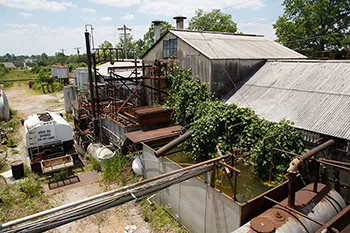
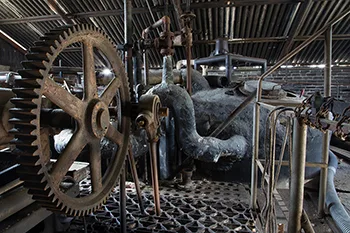 The Oil Recycler was established in the 1970s and was operational until sometime around 2014. Despite a small staff their annual revenue had reached tens of millions of dollars at one time, though I'm guessing that was during its prime, which appears to have been a couple decades ago.
The Oil Recycler was established in the 1970s and was operational until sometime around 2014. Despite a small staff their annual revenue had reached tens of millions of dollars at one time, though I'm guessing that was during its prime, which appears to have been a couple decades ago.
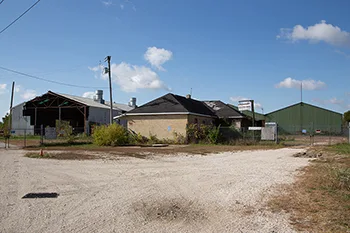
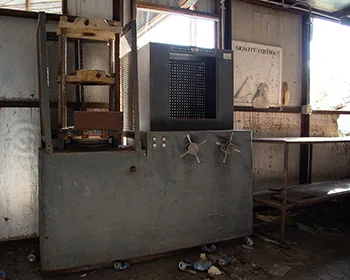 North American Refractories (NARCO) operated a brick manufacturing plant in this location when it was built in 1960 until approximately 2006. It was sold to a salvage company which is slowly dismantling the site.
North American Refractories (NARCO) operated a brick manufacturing plant in this location when it was built in 1960 until approximately 2006. It was sold to a salvage company which is slowly dismantling the site.
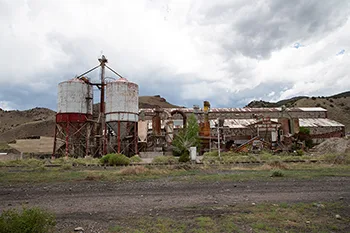
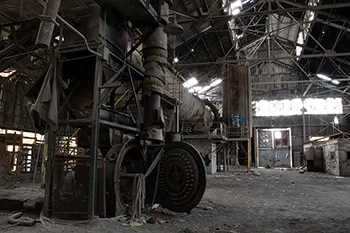 Calco Inc. operated this plant in Salida Colorado from the mid/late 70's to the mid 90s. They processed on average 200 tons of quicklime and crushed limestone daily which was hauled from the nearby Monarch Quarry. By the early 1990's they had numerous MSHA citations wherein their weak financial situation was acknowledged as reason for their rather small fines (~$50 per citation). It's not clear when they shut down but it appears to have been sometime in the mid 1990's.
Calco Inc. operated this plant in Salida Colorado from the mid/late 70's to the mid 90s. They processed on average 200 tons of quicklime and crushed limestone daily which was hauled from the nearby Monarch Quarry. By the early 1990's they had numerous MSHA citations wherein their weak financial situation was acknowledged as reason for their rather small fines (~$50 per citation). It's not clear when they shut down but it appears to have been sometime in the mid 1990's.
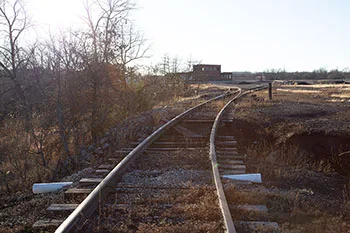
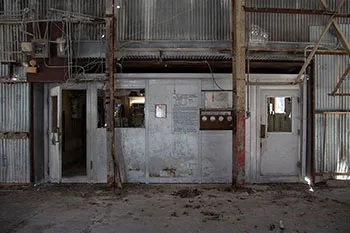 American Smelting and Refining Company (ASARCO) of Taylor Springs Illinois began under a slightly different name at this location in 1912. They were involved in zinc and lead smelting and refining as well as sulfuric acid production in addition to coal mining and storage, primary and secondary slab zinc production and both American and French Process zinc oxide production. Waste products from plant operations were conveniently dumped on-site and coal ash from the plant’s gas producing operations was casually spread on the ground. Slag piles were found to contain lead, arsenic, cadmium and other problematic metals. To what was surely the surprise of everyone involved, these methods of "storage" resulted in the contamination of both surface water and soil. This contamination not only extended onto adjacent residential properties but some waste materials were also used as fill dirt in the neighborhoods near the site. ASARCO LLC purchased the property from American Zinc and Lead in 1971 and they continued zinc smelting and refining activities. They then leased the facility to Midwest Zinc-Hillsboro, which remained in operation until 2004. EPA SUPERFUN SITE
A 1912 industrial site sounded super fun to me. It was an hour long drive to the best parking spot and a decent hike on top of that before we could even get eyes on the site and learn what, if anything, was still standing. It wasn't until we walked up out of the trees and finally laid eyes on the objective that we knew some, possibly all, of the original buildings still stood. I started to get my hopes up at this point. It looked like we had an office building in the front with some garages/shops in the middle and then the main production site in the rear-complete with a big ass power plant building that had a crazy ventilation fan sticking out of the side of it. It looked like it was going to be awesome. Very excited by this point to head in and see what's left.
American Smelting and Refining Company (ASARCO) of Taylor Springs Illinois began under a slightly different name at this location in 1912. They were involved in zinc and lead smelting and refining as well as sulfuric acid production in addition to coal mining and storage, primary and secondary slab zinc production and both American and French Process zinc oxide production. Waste products from plant operations were conveniently dumped on-site and coal ash from the plant’s gas producing operations was casually spread on the ground. Slag piles were found to contain lead, arsenic, cadmium and other problematic metals. To what was surely the surprise of everyone involved, these methods of "storage" resulted in the contamination of both surface water and soil. This contamination not only extended onto adjacent residential properties but some waste materials were also used as fill dirt in the neighborhoods near the site. ASARCO LLC purchased the property from American Zinc and Lead in 1971 and they continued zinc smelting and refining activities. They then leased the facility to Midwest Zinc-Hillsboro, which remained in operation until 2004. EPA SUPERFUN SITE
A 1912 industrial site sounded super fun to me. It was an hour long drive to the best parking spot and a decent hike on top of that before we could even get eyes on the site and learn what, if anything, was still standing. It wasn't until we walked up out of the trees and finally laid eyes on the objective that we knew some, possibly all, of the original buildings still stood. I started to get my hopes up at this point. It looked like we had an office building in the front with some garages/shops in the middle and then the main production site in the rear-complete with a big ass power plant building that had a crazy ventilation fan sticking out of the side of it. It looked like it was going to be awesome. Very excited by this point to head in and see what's left.
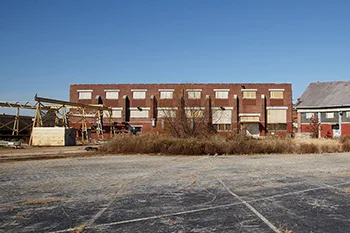
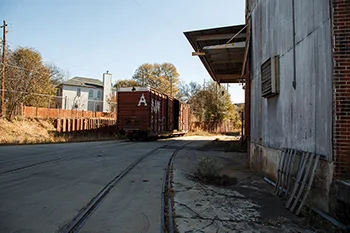 When we started this road trip there were 4 of us. But 4 didn't return. You see, the road to Terminus was very long and treacherous. By the time we thought we were close, our rations were almost gone and I couldn't get comfortable in a new place on an empty stomach. Sure, I had a couple of Lunchables left in my bag along with some Capri Suns but I just couldn't eat another one of those cold lifeless meals. A decision was made. And before I knew it, I was drizzling Stubb's BBQ sauce on the second helping of my good comrades well-done forearm. RIP. You were delicious, friend. Thanks to his sacrifice, we had enough strength left for the last 20 yards or so. It wasn't difficult to find, we just followed the signs: "'TERMINUS' Sanctuary for all. Community for all. Those who arrive, survive." But when we arrived, it was a ghost town. There was no-one in sight. No sanctuary here. I sat down to weep as I ate my second to last "Extra Cheesy Pizza" Lunchable -our late comrade's fingernails still caught in my teeth.
When we started this road trip there were 4 of us. But 4 didn't return. You see, the road to Terminus was very long and treacherous. By the time we thought we were close, our rations were almost gone and I couldn't get comfortable in a new place on an empty stomach. Sure, I had a couple of Lunchables left in my bag along with some Capri Suns but I just couldn't eat another one of those cold lifeless meals. A decision was made. And before I knew it, I was drizzling Stubb's BBQ sauce on the second helping of my good comrades well-done forearm. RIP. You were delicious, friend. Thanks to his sacrifice, we had enough strength left for the last 20 yards or so. It wasn't difficult to find, we just followed the signs: "'TERMINUS' Sanctuary for all. Community for all. Those who arrive, survive." But when we arrived, it was a ghost town. There was no-one in sight. No sanctuary here. I sat down to weep as I ate my second to last "Extra Cheesy Pizza" Lunchable -our late comrade's fingernails still caught in my teeth.
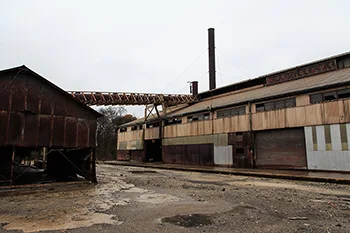
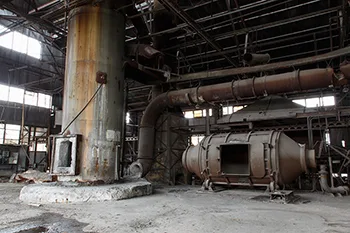 The W.J. Bullock Metal Foundry in Birmingham Alabama produced copper, zinc and aluminum from 1933 until some time within the past few years.
The W.J. Bullock Metal Foundry in Birmingham Alabama produced copper, zinc and aluminum from 1933 until some time within the past few years.
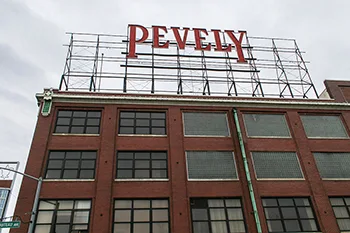
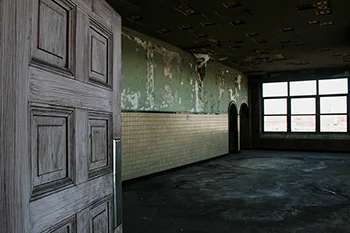 The Saint Louis Pevely Dairy Plant operated as a dairy production facility, a stable used for horse-wagon deliveries, the company's headquarters and even a soda fountain on the ground floor. The company itself was owned and operated from its founding in the 1880s through 1989, when it was bought by Prairie Farms Dairy. The oldest building on the site dated to 1915 and was located at the southwest corner of Grand Avenue and Manchester Road. It housed the offices for the company on four stories. In 1916, Pevely added a brick and concrete factory building on the site, located at 3626 Chouteau Avenue. The factory underwent expansions in 1943, 1945, 1975, and 1997; in addition, a garage was built south of the factory at 1101 Motard Avenue in 1928, and a smokestack on the site that dates to 1943 includes glazed brick lettering that spells out Pevely. The marquee sign for the Pevely Dairy Company Plant was a familiar sight, located on top of the office building. In October 2008, Prairie Farms closed the factory, which was the last Pevely facility still in use. By this time, the original Pevely Dairy Farm and Homestead were already long abandoned. In August 2011, the Saint Louis University President Lawrence Biondi decided it needed to be replaced with a terribly ugly modern building on that site, despite the fact that there is plenty of vacant land nearby. The building was on the National Register but that couldn't save it, nor would the protests from the Saint Louis Preservation Board among others.
The Saint Louis Pevely Dairy Plant operated as a dairy production facility, a stable used for horse-wagon deliveries, the company's headquarters and even a soda fountain on the ground floor. The company itself was owned and operated from its founding in the 1880s through 1989, when it was bought by Prairie Farms Dairy. The oldest building on the site dated to 1915 and was located at the southwest corner of Grand Avenue and Manchester Road. It housed the offices for the company on four stories. In 1916, Pevely added a brick and concrete factory building on the site, located at 3626 Chouteau Avenue. The factory underwent expansions in 1943, 1945, 1975, and 1997; in addition, a garage was built south of the factory at 1101 Motard Avenue in 1928, and a smokestack on the site that dates to 1943 includes glazed brick lettering that spells out Pevely. The marquee sign for the Pevely Dairy Company Plant was a familiar sight, located on top of the office building. In October 2008, Prairie Farms closed the factory, which was the last Pevely facility still in use. By this time, the original Pevely Dairy Farm and Homestead were already long abandoned. In August 2011, the Saint Louis University President Lawrence Biondi decided it needed to be replaced with a terribly ugly modern building on that site, despite the fact that there is plenty of vacant land nearby. The building was on the National Register but that couldn't save it, nor would the protests from the Saint Louis Preservation Board among others.
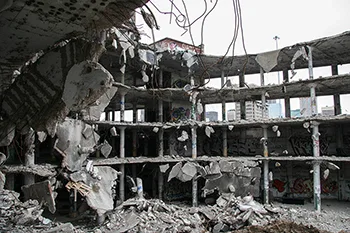
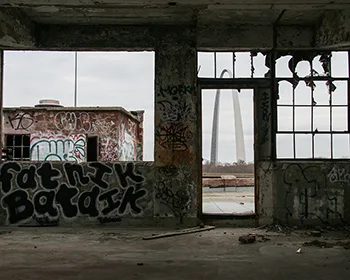 "The Powell Square Building was constructed in 1916 as the headquarters for the John T. Milliken Pharmaceutical and Absorbent Cotton Plant. When Mr. Milliken died from pneumonia three years later, he was said to be the richest man in St. Louis. The buildings architect was William Wedemeyer, who's architectural firm is the predecessor of Wedemeyer-Cernick-Corrubia, which still operates today. In 1926, the building was purchased by the Fulton Bag and Cotton Mill Company. The transaction was unusual in that as part of Fulton Bag's payment for the building on Cedar, their former building at 12 South Seventh Street was transferred to Milliken Pharmaceutical, who moved into the building and remained for several years. The building on South Seventh still stands and was renovated several years as the Fulton Bag Lofts. Photo above ca. 1930 from the Georgia Institute of Technology. In 1952 Fulton Bag added the truck dock addition to the east side of the building, also completely constructed of formed concrete. in 1956, Fulton Bag moved to a new building constructed for the company on Gustine Avenue. General Fibre Company purchased the former Milliken plant in 1957 and occupied the building for several years. Between that time and 2001, the building had numerous owners/tenants, one of which was the Dan Powell Co. Inc., which gave the building its current name Powell Square."
All research credit goes to (and above text word for word copied from) Paul @: https://vanishingstl.blogspot.com/2013/01/city-burns-cash-and-opportunity-with.html
"The Powell Square Building was constructed in 1916 as the headquarters for the John T. Milliken Pharmaceutical and Absorbent Cotton Plant. When Mr. Milliken died from pneumonia three years later, he was said to be the richest man in St. Louis. The buildings architect was William Wedemeyer, who's architectural firm is the predecessor of Wedemeyer-Cernick-Corrubia, which still operates today. In 1926, the building was purchased by the Fulton Bag and Cotton Mill Company. The transaction was unusual in that as part of Fulton Bag's payment for the building on Cedar, their former building at 12 South Seventh Street was transferred to Milliken Pharmaceutical, who moved into the building and remained for several years. The building on South Seventh still stands and was renovated several years as the Fulton Bag Lofts. Photo above ca. 1930 from the Georgia Institute of Technology. In 1952 Fulton Bag added the truck dock addition to the east side of the building, also completely constructed of formed concrete. in 1956, Fulton Bag moved to a new building constructed for the company on Gustine Avenue. General Fibre Company purchased the former Milliken plant in 1957 and occupied the building for several years. Between that time and 2001, the building had numerous owners/tenants, one of which was the Dan Powell Co. Inc., which gave the building its current name Powell Square."
All research credit goes to (and above text word for word copied from) Paul @: https://vanishingstl.blogspot.com/2013/01/city-burns-cash-and-opportunity-with.html
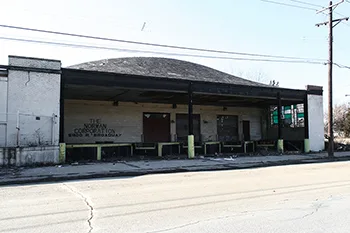
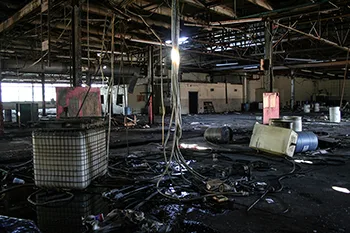 "The site was originally owned and operated by McCabe and Powers who manufactured jeep and truck chassis during World War II. The property was purchased from McCabe and Powers by American Linen in the 1960s. American Linen operated the site as a commercial laundry until it was sold in the mid-1980s to Charlie Gallagher who maintained the site as a commercial laundry. The property was again sold in the late-1980s to the Norman Corporation, which continued to operate the site as a commercial laundry until it ceased most operations in the late 1990s"
"The site was originally owned and operated by McCabe and Powers who manufactured jeep and truck chassis during World War II. The property was purchased from McCabe and Powers by American Linen in the 1960s. American Linen operated the site as a commercial laundry until it was sold in the mid-1980s to Charlie Gallagher who maintained the site as a commercial laundry. The property was again sold in the late-1980s to the Norman Corporation, which continued to operate the site as a commercial laundry until it ceased most operations in the late 1990s"
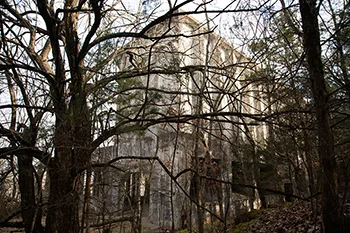
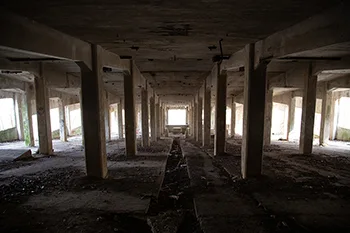 The Concrete Ruins used to be part of a large mine. Aside from sorting raw material, it's difficult to say what exactly these structures once housed or what methods were used in sorting. There were large hoppers at the top of the tallest buildings which funneled material into lower parts of the structures, through holes in the floor and down a long slope. The existence of a large water basin along with channels in the floors from the top sorting station down the hill lead me to believe water was employed in funneling ore to different end points below. The building towards the base of the hill could have thus been a pump house and the one next to it may have been the hopper where the final product of this facility was loaded into trucks and hauled off.
The Concrete Ruins used to be part of a large mine. Aside from sorting raw material, it's difficult to say what exactly these structures once housed or what methods were used in sorting. There were large hoppers at the top of the tallest buildings which funneled material into lower parts of the structures, through holes in the floor and down a long slope. The existence of a large water basin along with channels in the floors from the top sorting station down the hill lead me to believe water was employed in funneling ore to different end points below. The building towards the base of the hill could have thus been a pump house and the one next to it may have been the hopper where the final product of this facility was loaded into trucks and hauled off.
Crunden-Martin manufactured woodenware and metal goods in this location from 1891 to 1990. "As early as 1882, the St. Louis riverfront became the nation's chief distribution point of wooden and willow wares. The woodenware trade included an extensive variety of articles including buckets, casks, tubs, ladles, bread bowls and other household utensils. Willow ware included baskets and other articles. With the rising local industry came associated cordage, rope, brooms, wrapping paper, paper bags, stove polish and axle grease. During WWII, Crunden-Martin manufactured helmets, stoves, buckets and five-gallon gasoline 'jerry cans' for the U. S. military." In 1990 Crunden-Martin filled bankruptcy and the buildings were sold at auction two years later. On December 8, 2011, building #5 (constructed in 1912) caught fire. Luckily the majority of the damage was limited to the top three floors.
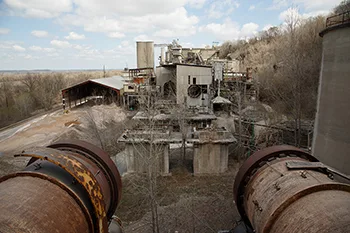
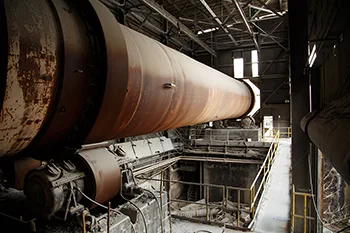 The cement plant is currently active and runs a large underground room and pillar mine at this location. These crumbling structures stand just outside their main entrance and butt right up against their active buildings.
The cement plant is currently active and runs a large underground room and pillar mine at this location. These crumbling structures stand just outside their main entrance and butt right up against their active buildings.
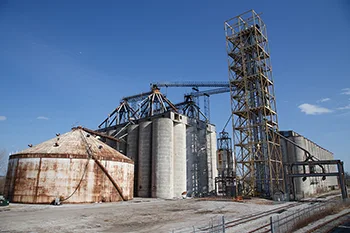
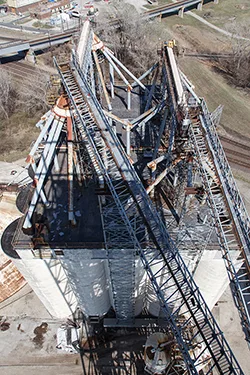 This place is known as the Jungle Gym. I'm not sure what the real name of it is, nor do I know what materials they dealt with here. I do know that it's pretty tall and it smells like shit.
This place is known as the Jungle Gym. I'm not sure what the real name of it is, nor do I know what materials they dealt with here. I do know that it's pretty tall and it smells like shit.
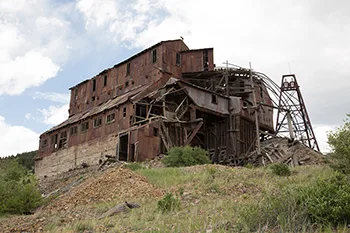
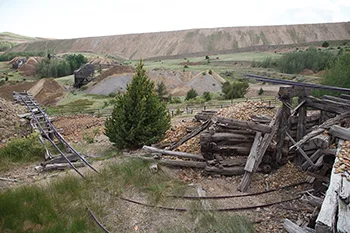 The Vindicator Valley Trail is a 2-mile hiking trail which loops around a veritable gold mine of... gold mines. Countless gold mining operations set up camp in this valley over 100 years ago. Massive mining operations once dominated the hillside and large towns grew around them. Today there is very little left of both the mines and the towns which supported them. The crumbling ghosts of once mighty industries now dot the hills in silence. Fortunately, the ruins are now preserved in place and visitors can hike the interpretive trail which provides historic information and the chance to witness these awesome relics up close. There's very little left of what used to be but considering the alternative, it's incredible that there's anything left at all-especially when you consider these old wooden structures are 100 years old.
The Vindicator Valley Trail is a 2-mile hiking trail which loops around a veritable gold mine of... gold mines. Countless gold mining operations set up camp in this valley over 100 years ago. Massive mining operations once dominated the hillside and large towns grew around them. Today there is very little left of both the mines and the towns which supported them. The crumbling ghosts of once mighty industries now dot the hills in silence. Fortunately, the ruins are now preserved in place and visitors can hike the interpretive trail which provides historic information and the chance to witness these awesome relics up close. There's very little left of what used to be but considering the alternative, it's incredible that there's anything left at all-especially when you consider these old wooden structures are 100 years old.
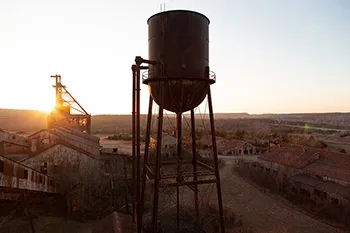
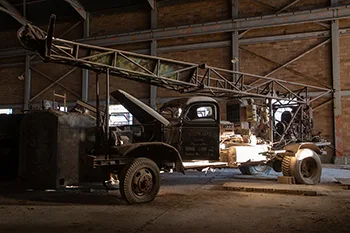 The old Missouri lead mine is a site of local significance, especially as it pertains to the history of the area. It was built in the early 1900's and was retired in the early 1970's at which point the land was donated and converted to a park. This location has been the object of my interest for a long, long time, so I did some homework. One aspect of this research was scheduling an onsite visit as a typical tourist where I saw and learned all that I could onsite, within the unreasonably strict legal boundaries they've implemented here. I spoke to the people onsite who seemed to almost brag about the fact that "nobody gets permission" to explore it. Even Ford Motor Company was denied the right to access the site for a commercial once upon a time. I was told "You can try to ask for permission but there's so much red tape you can just count on it not happening". If you decide to visit this location, you are granted access inside of ONE building-as long as you pay for the privilege: The former powerplant was converted into a museum and bears absolutely no resemblance to its original interior. Inside, it could be any other boring mid-century square brick building. The displays themselves are pretty decent, if you're a rock nerd and to a lesser extent a history dweeb (things which I am admittedly guilty of being from time to time). Many of the displays however, while interesting, don't even pertain to this site and what was mined here(!). Outside, you can peek in approximately one window and one doorway of the main plant building opposite the museum. You are allowed to walk from there, in a straight line, down to the end of the row of buildings. THAT'S IT. If you try to see more of this PUBLIC park which is maintained by our tax dollars, you are obviously a no-good filthy godddamned criminal!* (*they didn't actually say this last part, I'm just paraphrasing their stated rules here with some artistic license added).
The old Missouri lead mine is a site of local significance, especially as it pertains to the history of the area. It was built in the early 1900's and was retired in the early 1970's at which point the land was donated and converted to a park. This location has been the object of my interest for a long, long time, so I did some homework. One aspect of this research was scheduling an onsite visit as a typical tourist where I saw and learned all that I could onsite, within the unreasonably strict legal boundaries they've implemented here. I spoke to the people onsite who seemed to almost brag about the fact that "nobody gets permission" to explore it. Even Ford Motor Company was denied the right to access the site for a commercial once upon a time. I was told "You can try to ask for permission but there's so much red tape you can just count on it not happening". If you decide to visit this location, you are granted access inside of ONE building-as long as you pay for the privilege: The former powerplant was converted into a museum and bears absolutely no resemblance to its original interior. Inside, it could be any other boring mid-century square brick building. The displays themselves are pretty decent, if you're a rock nerd and to a lesser extent a history dweeb (things which I am admittedly guilty of being from time to time). Many of the displays however, while interesting, don't even pertain to this site and what was mined here(!). Outside, you can peek in approximately one window and one doorway of the main plant building opposite the museum. You are allowed to walk from there, in a straight line, down to the end of the row of buildings. THAT'S IT. If you try to see more of this PUBLIC park which is maintained by our tax dollars, you are obviously a no-good filthy godddamned criminal!* (*they didn't actually say this last part, I'm just paraphrasing their stated rules here with some artistic license added).
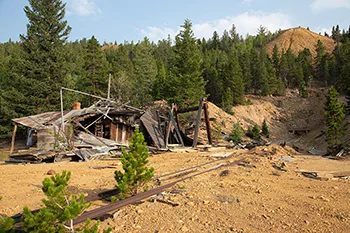
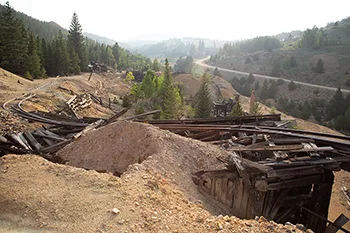 The area in which these mines reside is one of the most significant locations in Colorado in terms of gold deposits, having helped spur the gold rush of 1859. Within two months of the first reports of gold discovered here, 10,000 people had moved into town and it was soon called the "richest square mile on earth". All the veins in the region were initially easy to mine as they were already oxidized and decomposed at the surface and as a result the gold output here surpassed that of all other mining districts in Colorado combined, up until the 1880s, and still today ranks second highest overall in terms of gold production. There were also substantial amounts of silver, lead, copper and zinc mined here. In the 100 years spanning 1859 to 1959 this county produced roughly 4,255,000 ounces of gold which would be worth $7.2 Billion today. And much of that gold came from the the very mines I explored and photographed here.
The area in which these mines reside is one of the most significant locations in Colorado in terms of gold deposits, having helped spur the gold rush of 1859. Within two months of the first reports of gold discovered here, 10,000 people had moved into town and it was soon called the "richest square mile on earth". All the veins in the region were initially easy to mine as they were already oxidized and decomposed at the surface and as a result the gold output here surpassed that of all other mining districts in Colorado combined, up until the 1880s, and still today ranks second highest overall in terms of gold production. There were also substantial amounts of silver, lead, copper and zinc mined here. In the 100 years spanning 1859 to 1959 this county produced roughly 4,255,000 ounces of gold which would be worth $7.2 Billion today. And much of that gold came from the the very mines I explored and photographed here.
In the late 1800's, prospectors discovered a large gold deposit beneath the hills on which this mine is now located. This discovery went on to become one of the most prosperous gold mines in the area for many years. Originally there were several independently claimed mines here but they were consolidated in the 1890's. In today's dollars, the gold mined here amounted to approximately $100 Million, or about 70,000 troy ounces. Armed guards were stationed inside the mine where miners were frisked before returning to the surface. The main shaft extends over 1,000 feet straight down, with nine levels branching off from it in all directions, amounting to more than 30 miles of tunnels. This gold mine operated from the late 1800's until some time around 1970. The current owner is battling legal issues which prevent it from being used in any capacity now.
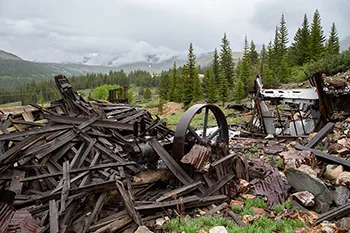
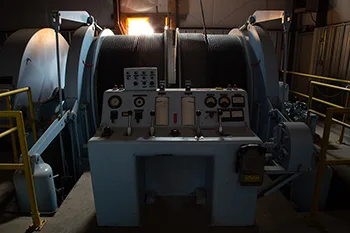 Leadville is a mountain town in central Colorado which was inhabited as early as the 16th century by the Ute Nation people. To the north of the Gunnison River the Ute Nation was mostly comprised of the Parianuche or "elk people". During the warm season, the Parianuche lived along the headwaters of the renowned Arkansas River in the area that later came to be known as Leadville. After spending the warm season along the headwaters, they moved to lower elevations in the winter. This was more or less the routine for some 300+ years before their home was invaded by people desperate to strike it rich by blasting tunnels and digging holes through the earth.
Leadville is a mountain town in central Colorado which was inhabited as early as the 16th century by the Ute Nation people. To the north of the Gunnison River the Ute Nation was mostly comprised of the Parianuche or "elk people". During the warm season, the Parianuche lived along the headwaters of the renowned Arkansas River in the area that later came to be known as Leadville. After spending the warm season along the headwaters, they moved to lower elevations in the winter. This was more or less the routine for some 300+ years before their home was invaded by people desperate to strike it rich by blasting tunnels and digging holes through the earth.
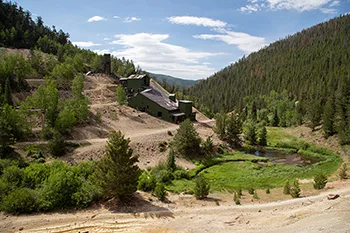
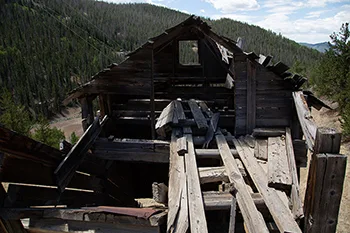 In 2017 I made my first trip to Colorado to explore The Ghost Town of Gillman Colorado along with the mine structures below. Underestimating the terrain, I legitimately risked our lives (a few different times) by not being prepared from the outset. This led to a series of unforunate events. I learned a valuable lesson that day, which I promptly forgot and then re-learned again when I was nearly search-and-rescued on our trip to The Skaguay Hydroelectric Power Plant. Woops. The lesson is simple: Nothing is easy in Colorado. About a year had passed since I explored around Leadville, so naturally I forgot all about those prior lessons despite the added difficulty doing it alone, fresh out of surgery with a broken collarbone... I'm very stupid and I can't resist a good adventure. Okay? I have Adventuritis. It's a thing.
In 2017 I made my first trip to Colorado to explore The Ghost Town of Gillman Colorado along with the mine structures below. Underestimating the terrain, I legitimately risked our lives (a few different times) by not being prepared from the outset. This led to a series of unforunate events. I learned a valuable lesson that day, which I promptly forgot and then re-learned again when I was nearly search-and-rescued on our trip to The Skaguay Hydroelectric Power Plant. Woops. The lesson is simple: Nothing is easy in Colorado. About a year had passed since I explored around Leadville, so naturally I forgot all about those prior lessons despite the added difficulty doing it alone, fresh out of surgery with a broken collarbone... I'm very stupid and I can't resist a good adventure. Okay? I have Adventuritis. It's a thing.
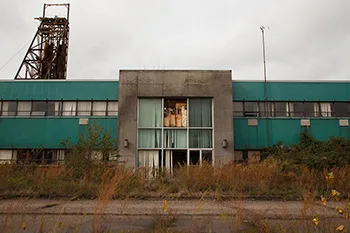
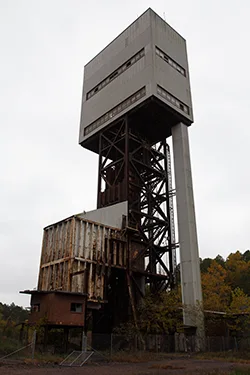 The Iron Mine was constructed in 1964. "During operation, it extracted as much as 1 million ton of rock each year. The iron ore extracted here was crushed to a size less than 1 1/2 ft. in the underground crusher. It was then hoisted to the surface and fed into a secondary crusher that took it to a size less than 6 inches. It then went into a tertiary (3rd) crusher that took it to a size less than 1 inch. After that, it went into the wet milling circuit. The mills ground the ore down to where 90% would pass through a 325 mesh screen (for the primary product). It then went through a flotation circuit to separate the impurities out. There were a few different processes after that to produce different products. Most was sold to Coal companies for use in purifying coal. Some was sold to magnet companies. Some was converted to hematite and sold for other uses".
The Iron Mine was constructed in 1964. "During operation, it extracted as much as 1 million ton of rock each year. The iron ore extracted here was crushed to a size less than 1 1/2 ft. in the underground crusher. It was then hoisted to the surface and fed into a secondary crusher that took it to a size less than 6 inches. It then went into a tertiary (3rd) crusher that took it to a size less than 1 inch. After that, it went into the wet milling circuit. The mills ground the ore down to where 90% would pass through a 325 mesh screen (for the primary product). It then went through a flotation circuit to separate the impurities out. There were a few different processes after that to produce different products. Most was sold to Coal companies for use in purifying coal. Some was sold to magnet companies. Some was converted to hematite and sold for other uses".
This is a large room and pillar mine extending much further and deeper than any I have explored before and as such we only scratched the surface of what there is to see here before we ran out of time. Portions of this site are completely abandoned due to collapse, while others are still in use.

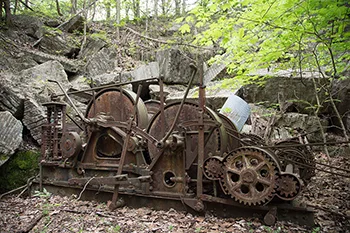 The Ozora Marble Quarry began in 1920 and was reported to have been worked continuously until 1943, when operations were permanently shut down.
Stone from the Ozora Marble Quarry (Ste. Genevieve Golden Vein and Ste. Genevieve Rose Marble) was used in the enclosures which house and protect the original copies of the Declaration of Independence, the Bill of Rights and the Constitution of the United States.
The Ozora Marble Quarry began in 1920 and was reported to have been worked continuously until 1943, when operations were permanently shut down.
Stone from the Ozora Marble Quarry (Ste. Genevieve Golden Vein and Ste. Genevieve Rose Marble) was used in the enclosures which house and protect the original copies of the Declaration of Independence, the Bill of Rights and the Constitution of the United States.
"The quarry was equipped with a stiff-leg derrick with 35-foot mast and 75-foot boom and was powered by electric motors. Pneumatic drills and quarry bars were also used. Air compressors were driven by electric motors and electricity was supplied by diesel-powered generators".
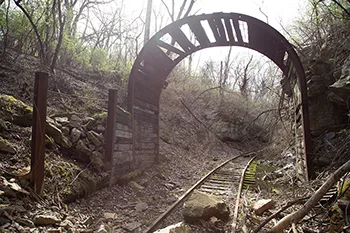
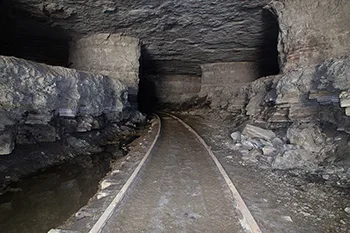 This is a pretty rad little spot called Train Tunnel Mine. The accessible portion is pretty average in overall size/layout as far as room and pillar mines go, but the unique feature here is obviously the rail line coming out of it and the train tunnel that goes deeper into the mine. Unfortunately, however, the tunnel ends abrubtly after only a hundred yards or so where a large sturdy gate prevents further exploration. Beyond the gate, within the dark and desolate expanse of these forgotten depths, electricity is loudly buzzing away, rather mysteriously, with no clear indication as to what exactly the space is being used for. Furthermore, there are no clues to tell us from where those responsible for maintaining this underground lair gain access to the site. One can only assume it's either being used for some run-of-the-mill underground storage or some clandestine government experiments involving aliens and/or lizard people.
This is a pretty rad little spot called Train Tunnel Mine. The accessible portion is pretty average in overall size/layout as far as room and pillar mines go, but the unique feature here is obviously the rail line coming out of it and the train tunnel that goes deeper into the mine. Unfortunately, however, the tunnel ends abrubtly after only a hundred yards or so where a large sturdy gate prevents further exploration. Beyond the gate, within the dark and desolate expanse of these forgotten depths, electricity is loudly buzzing away, rather mysteriously, with no clear indication as to what exactly the space is being used for. Furthermore, there are no clues to tell us from where those responsible for maintaining this underground lair gain access to the site. One can only assume it's either being used for some run-of-the-mill underground storage or some clandestine government experiments involving aliens and/or lizard people.
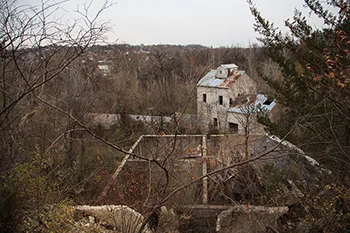
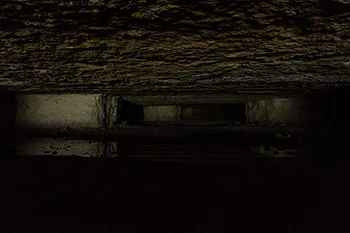 This mine was begun in the 1870's by a pair of brothers, Lyman and William. Lyman was born in the 1830s, went to school and took a job in New York by the age of 14. He worked various jobs until when, at the age of 27, he struck out for mining opportunities in what would later become Montana territory. During this trek, his team was forced to repell attacks by Native Americans. He arrived in July of 1863 and formed a mining partnership. But this region was sparsely populated and even less regulated by law and as such any disputes were settled amongst the miners themselves. Soon a vigilante group was formed and eventually executed 26 men while banishing many others. Lyman was a member of this group and personally hung 5 of the offenders. He would eventually leave, leading an expedition into unsettled territory before finally making his way to Missouri, where he would join his brother in mining. William started out working in a similar field as his brother but soon organized and became captain of a company of volunteers for the Union Army. He commanded his company through at least 4 battles of the Civil War and served until the end of the conflict. He returned home and soon started the Old Limestone Mine. This mine was later owned by a few different organizations until around 1950 when it was shuttered. UPDATE: This location is now known as the Sodalis Nature Preserve in Hannibal, Missouri. All of the buildings have been demolished and the limestone mine is gated off in order to protect the bats living here.
This mine was begun in the 1870's by a pair of brothers, Lyman and William. Lyman was born in the 1830s, went to school and took a job in New York by the age of 14. He worked various jobs until when, at the age of 27, he struck out for mining opportunities in what would later become Montana territory. During this trek, his team was forced to repell attacks by Native Americans. He arrived in July of 1863 and formed a mining partnership. But this region was sparsely populated and even less regulated by law and as such any disputes were settled amongst the miners themselves. Soon a vigilante group was formed and eventually executed 26 men while banishing many others. Lyman was a member of this group and personally hung 5 of the offenders. He would eventually leave, leading an expedition into unsettled territory before finally making his way to Missouri, where he would join his brother in mining. William started out working in a similar field as his brother but soon organized and became captain of a company of volunteers for the Union Army. He commanded his company through at least 4 battles of the Civil War and served until the end of the conflict. He returned home and soon started the Old Limestone Mine. This mine was later owned by a few different organizations until around 1950 when it was shuttered. UPDATE: This location is now known as the Sodalis Nature Preserve in Hannibal, Missouri. All of the buildings have been demolished and the limestone mine is gated off in order to protect the bats living here.
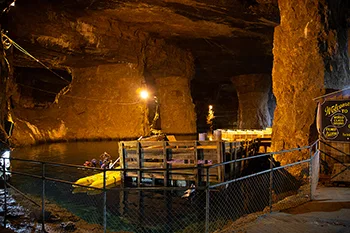
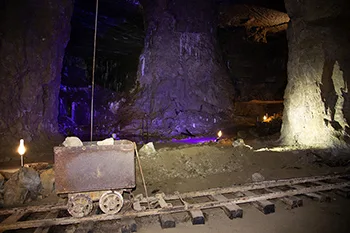 Bonne Terre Mine began in 1864 by the St Joe Lead Company and was operational until 1962-just 2 years shy of its 100th anniversary. The mine was subsequently purchased by Doe Run and then leased to West End Diving in 1976 who now operates scuba diving and tours of the underground sections which are now mostly flooded with crystal clear water. Much of the town of Bonne Terre now sits directly above this flooded mine.
I finaly got to scratch this off my to-do list recently and booked a tour of the place. I highly recommend it to anyone who's in the area. Now I just need to get into scuba diving and see what it's like beneath the water.
Bonne Terre Mine began in 1864 by the St Joe Lead Company and was operational until 1962-just 2 years shy of its 100th anniversary. The mine was subsequently purchased by Doe Run and then leased to West End Diving in 1976 who now operates scuba diving and tours of the underground sections which are now mostly flooded with crystal clear water. Much of the town of Bonne Terre now sits directly above this flooded mine.
I finaly got to scratch this off my to-do list recently and booked a tour of the place. I highly recommend it to anyone who's in the area. Now I just need to get into scuba diving and see what it's like beneath the water.
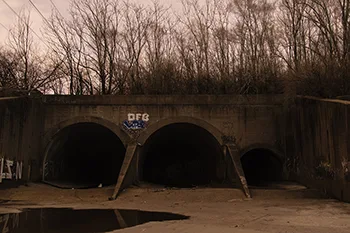
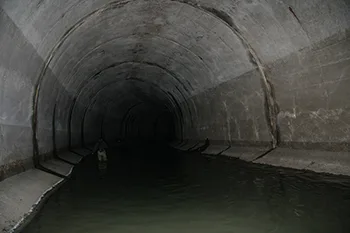 There aren't many people adventurous/stupid enough to willingly go into the sewers just to see what's going on down there. Luckily, we have the exact qualifications needed for the job.
There aren't many people adventurous/stupid enough to willingly go into the sewers just to see what's going on down there. Luckily, we have the exact qualifications needed for the job.

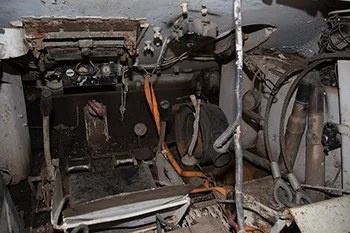 This Soviet T34/85 tank was built sometime between 1943-45. This example, which is an early variant of the T34 first produced in 1940, features a larger turret and improved interior layout of its predecessor. This tank employs an 85mm main gun and dual DT 1929 7.62x54R machine guns. The diesel powered V12 motor could propel this tank up to 26 MPH at a range of roughly 200 miles before refueling.
This Soviet T34/85 tank was built sometime between 1943-45. This example, which is an early variant of the T34 first produced in 1940, features a larger turret and improved interior layout of its predecessor. This tank employs an 85mm main gun and dual DT 1929 7.62x54R machine guns. The diesel powered V12 motor could propel this tank up to 26 MPH at a range of roughly 200 miles before refueling.
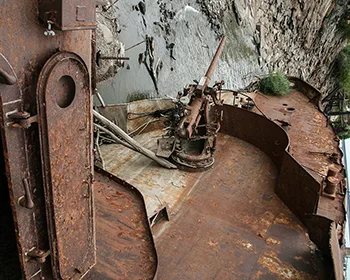
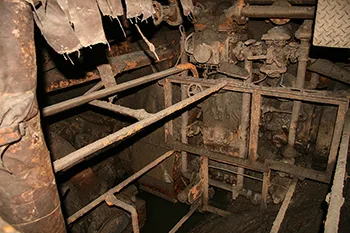 The USS Inaugural (AM-242) was an Admirable-class fleet minesweeper. The Admirable class was the largest and one of the most successful classes of U.S. minesweepers ordered during World War II. Inaugural was launched on 1 October 1944, and was commissioned on 30 December, with Lieutenant John H. Pace USNR in command.
The USS Inaugural (AM-242) was an Admirable-class fleet minesweeper. The Admirable class was the largest and one of the most successful classes of U.S. minesweepers ordered during World War II. Inaugural was launched on 1 October 1944, and was commissioned on 30 December, with Lieutenant John H. Pace USNR in command.
The ship was decommissioned in 1946 and set up as a museum ship in St. Louis, Missouri in 1968.
Inaugural had performed its duties with distinction. By the end of its career, the vessel had cleared eighty-two mines and was awarded two battle stars for service during World War II.
Inaugural was ripped from its mooring and grounded a mile downstream in the flood of 1993.
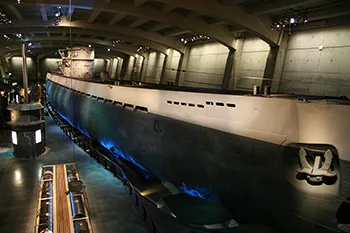
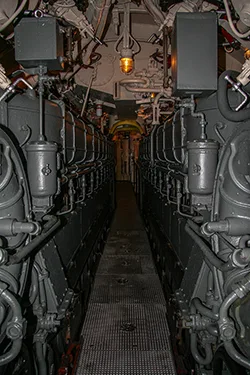 The U-505 is a German Type IXC U-boat built for service in the Kriegsmarine during World War II. She was captured on 4 June 1944 by United States Navy Task Group 22.3 (TG 22.3). Her codebooks, Enigma machine and other secret materials found on board assisted Allied code breaking operations. All but one of U-505's crew were rescued by the Navy task group. The submarine was towed to Bermuda in secret, her crew was interned at a US prisoner of war camp where they were denied access to International Red Cross visits. The Navy classified the capture as top secret and prevented its discovery by the Germans. In 1954, U-505 was donated to the Museum of Science and Industry in Chicago, Illinois and is now a museum ship. She is one of six U-boats that were captured by Allied forces during World War II, and one of four German World War II U-boats that survive as museum ships. She is the only Type IXC still in existence.
The U-505 is a German Type IXC U-boat built for service in the Kriegsmarine during World War II. She was captured on 4 June 1944 by United States Navy Task Group 22.3 (TG 22.3). Her codebooks, Enigma machine and other secret materials found on board assisted Allied code breaking operations. All but one of U-505's crew were rescued by the Navy task group. The submarine was towed to Bermuda in secret, her crew was interned at a US prisoner of war camp where they were denied access to International Red Cross visits. The Navy classified the capture as top secret and prevented its discovery by the Germans. In 1954, U-505 was donated to the Museum of Science and Industry in Chicago, Illinois and is now a museum ship. She is one of six U-boats that were captured by Allied forces during World War II, and one of four German World War II U-boats that survive as museum ships. She is the only Type IXC still in existence.

 We stumbled across this lot on a recent drive and immediately decided to check it out. I'm not sure why all of these aircraft are sitting here but it seems to be related to a salvage operation.
We stumbled across this lot on a recent drive and immediately decided to check it out. I'm not sure why all of these aircraft are sitting here but it seems to be related to a salvage operation.
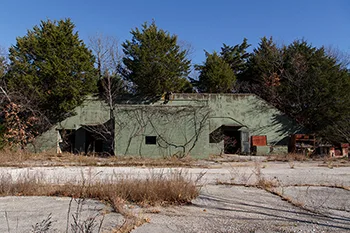
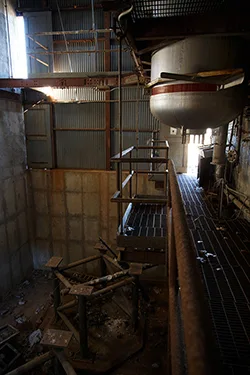 The Rocket Factory was constructed in the 1950s and during the short decade in which it was operational, it contributed significantly to the course of world history. It was decommissioned shortly afterward, in the late 1960s. Of the remaining buildings, the steel frame structures were used for testing the fuel delivery systems and gathering data. The resultant data was sent back to a reinforced bunker through a short tunnel which connected the buildings. Inside the bunkers, the data was collected and analyzed. In the case of the main control bunker, there are two longer tunnels about 100 yards in length, which connect to two separate large test pads for the rockets.
The Rocket Factory was constructed in the 1950s and during the short decade in which it was operational, it contributed significantly to the course of world history. It was decommissioned shortly afterward, in the late 1960s. Of the remaining buildings, the steel frame structures were used for testing the fuel delivery systems and gathering data. The resultant data was sent back to a reinforced bunker through a short tunnel which connected the buildings. Inside the bunkers, the data was collected and analyzed. In the case of the main control bunker, there are two longer tunnels about 100 yards in length, which connect to two separate large test pads for the rockets.
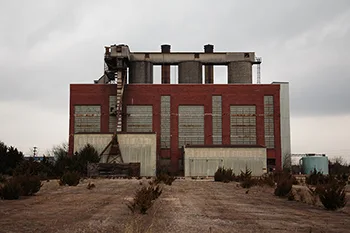
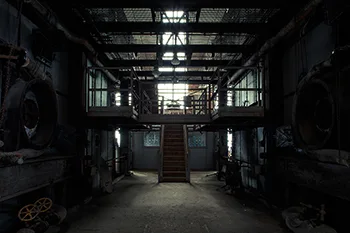 The Army Ammunition Plant was constructed in the 1940s for the purpose of contributing to the United States' war effort and it continued long after WWII ended. In fact it contributed to every major war since then, right up until the 1990s when it was finally shut down. We hiked through the woods for miles before we saw the first structure in the distance. We left the car around noon but by the time we got to the roof of the Power Plant the sun was already beginning its descent on a low arc through the western December sky. By this time the increasing clouds meant rain was threatening to soak our expedition.
The Army Ammunition Plant was constructed in the 1940s for the purpose of contributing to the United States' war effort and it continued long after WWII ended. In fact it contributed to every major war since then, right up until the 1990s when it was finally shut down. We hiked through the woods for miles before we saw the first structure in the distance. We left the car around noon but by the time we got to the roof of the Power Plant the sun was already beginning its descent on a low arc through the western December sky. By this time the increasing clouds meant rain was threatening to soak our expedition.
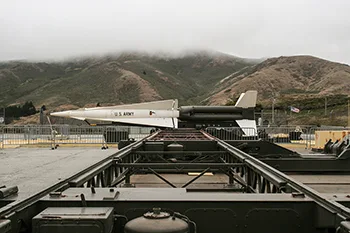
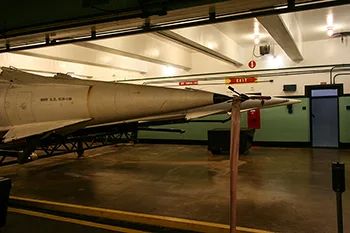 SF-88L was the launch battery of the 2nd Battalion, 56th Artillery. It was here that the Missile body and guidance system were assembled and tested. The warheads were attached in the warhead building prior to being wheeled over to the launch area and lowered into the underground storage bunker magazine known as the pit. SF-88L has two magazines, each with the capacity to store 6 missiles. The magazines are 49' long and 60' wide. At the end of each magazine, located behind blast doors, was the control room. From the control room, the crew could launch the missiles as well as raise or lower them to and from the magazine. This is technically just the launch battery. The radar Integrated Fire Control, or IFC (named SF-88C) was located just down the road. SF-88C is abandoned and I planned to visit it on this trip. However, to my surprise, the roads were gated and I only had with me street maps to the location. To make it on foot would have taken roughly several hours round trip. Since I only had about 24 hours in San Francisco, I had to make the painful decision to not visit it in order to make time for other locations that I had planned.
SF-88L was the launch battery of the 2nd Battalion, 56th Artillery. It was here that the Missile body and guidance system were assembled and tested. The warheads were attached in the warhead building prior to being wheeled over to the launch area and lowered into the underground storage bunker magazine known as the pit. SF-88L has two magazines, each with the capacity to store 6 missiles. The magazines are 49' long and 60' wide. At the end of each magazine, located behind blast doors, was the control room. From the control room, the crew could launch the missiles as well as raise or lower them to and from the magazine. This is technically just the launch battery. The radar Integrated Fire Control, or IFC (named SF-88C) was located just down the road. SF-88C is abandoned and I planned to visit it on this trip. However, to my surprise, the roads were gated and I only had with me street maps to the location. To make it on foot would have taken roughly several hours round trip. Since I only had about 24 hours in San Francisco, I had to make the painful decision to not visit it in order to make time for other locations that I had planned.
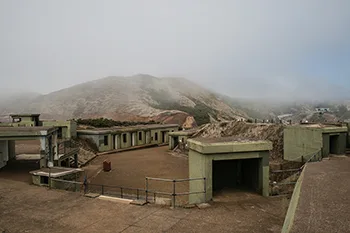
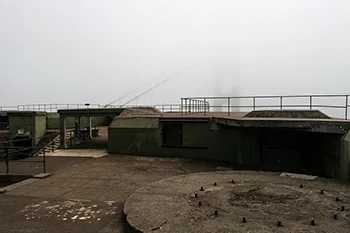 "For half a century, Battery Spencer was one of the most strategically important sites guarding the Golden Gate. Construction started in 1893 and was completed in 1897. Under the provisions of War Department General Order 16, dated 14 February 1902, it was named for Major General Joseph Spencer of the Continental Army, a hero of the Revolutionary War, who died in 1789. It was initially armed with three M1888 12-inch breech loading rifles (Made at Waterlieviet Arsenal and serial numbered 10, 16, and 17) mounted on M1892 barbette mounts (made at Watertown Arsenal and serial numbered 1, 4, and 5.) In 1917 one gun was removed to rearm Battery Chester at Fort Winfield Scott. The remaining two guns were removed and scrapped in 1943".
"For half a century, Battery Spencer was one of the most strategically important sites guarding the Golden Gate. Construction started in 1893 and was completed in 1897. Under the provisions of War Department General Order 16, dated 14 February 1902, it was named for Major General Joseph Spencer of the Continental Army, a hero of the Revolutionary War, who died in 1789. It was initially armed with three M1888 12-inch breech loading rifles (Made at Waterlieviet Arsenal and serial numbered 10, 16, and 17) mounted on M1892 barbette mounts (made at Watertown Arsenal and serial numbered 1, 4, and 5.) In 1917 one gun was removed to rearm Battery Chester at Fort Winfield Scott. The remaining two guns were removed and scrapped in 1943".
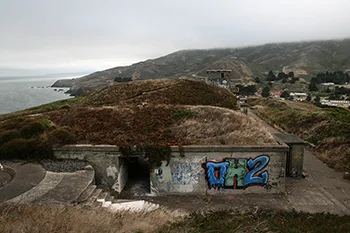
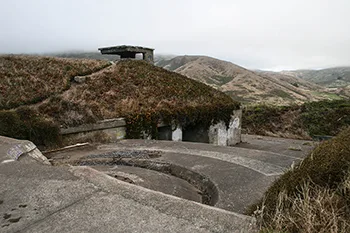 "The emplacement was named on December 27, 1904 in honor of Captain Edwin Guthrie, 15th Infantry Regiment, who died in action at La Hoya during the Mexican War in 1847. In 1922, Battery Guthrie was divided for better management of the weapons, and the two guns on the left flank were named on March 22 for Hamilton A. Smith, a West Point graduate killed in action at Soissons, France, during World War I in 1918. During World War II the guns from these two batteries were used to defend the minefields outside the Golden Gate from minesweepers. The battery was inactivated in 1945 and its guns scrapped soon thereafter".
"The emplacement was named on December 27, 1904 in honor of Captain Edwin Guthrie, 15th Infantry Regiment, who died in action at La Hoya during the Mexican War in 1847. In 1922, Battery Guthrie was divided for better management of the weapons, and the two guns on the left flank were named on March 22 for Hamilton A. Smith, a West Point graduate killed in action at Soissons, France, during World War I in 1918. During World War II the guns from these two batteries were used to defend the minefields outside the Golden Gate from minesweepers. The battery was inactivated in 1945 and its guns scrapped soon thereafter".
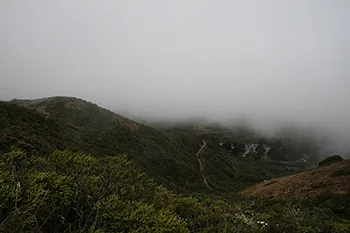
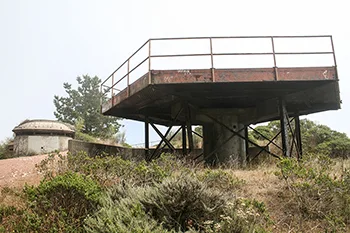 This one would have been a piece of cake, had the road not been under construction. They wouldn't let me through, so I had to hike through the mountains to get there. This trek earned me a poison ivy (technically poodle dog bush) rash from head to toe, the worst I've ever had...
This one would have been a piece of cake, had the road not been under construction. They wouldn't let me through, so I had to hike through the mountains to get there. This trek earned me a poison ivy (technically poodle dog bush) rash from head to toe, the worst I've ever had...
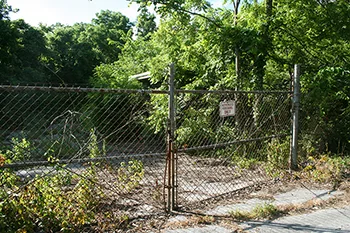
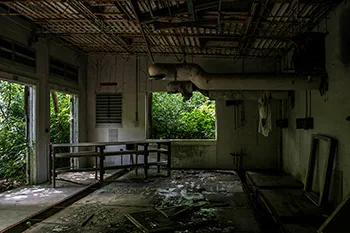 Nike Missile installations were the United States' first ground based anti-aircraft defense system, which became operational as early as 1953. They were placed in secluded locations throughout the country and were our last line of homeland defense against enemy bombers at that time. Eventually technology improved and these systems became obsolete. There isn't much left of this old Nike Missile Base now. As per the typical construction of such Cold War era missile sites, the buildings are scattered and this particular installation is spread among 3 separate areas. I have arranged them here in the order in which I explored them. Area 1 consists of the Integrated Fire Control (IFC) Area. This site contained the Nike system's ground-based radar target acquisition and computer systems. There are 3 buildings left of the IFC now. Near the entrance sits a guard shack. Further up into the woods are two more heavily overgrown structures whose original purpose has been long since forgotten.
Nike Missile installations were the United States' first ground based anti-aircraft defense system, which became operational as early as 1953. They were placed in secluded locations throughout the country and were our last line of homeland defense against enemy bombers at that time. Eventually technology improved and these systems became obsolete. There isn't much left of this old Nike Missile Base now. As per the typical construction of such Cold War era missile sites, the buildings are scattered and this particular installation is spread among 3 separate areas. I have arranged them here in the order in which I explored them. Area 1 consists of the Integrated Fire Control (IFC) Area. This site contained the Nike system's ground-based radar target acquisition and computer systems. There are 3 buildings left of the IFC now. Near the entrance sits a guard shack. Further up into the woods are two more heavily overgrown structures whose original purpose has been long since forgotten.
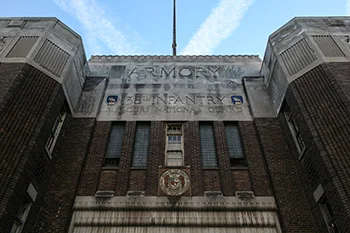
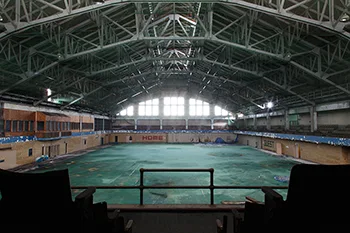 The National Guard Armory was erected in 1937. It went into service in 1939 as the Headquarters of Saint Louis' own 138th Infantry. This building was used, like the other armories, for the purpose of storing ammunition and equipment as well as training soldiers. It remained in use from the time of its initial entry into service in 1939 up until some time in the mid 1960's. The below-ground parking garage housed tanks and other heavy equipment during this time. The building was operated by the 138th as late as 1963...
The National Guard Armory was erected in 1937. It went into service in 1939 as the Headquarters of Saint Louis' own 138th Infantry. This building was used, like the other armories, for the purpose of storing ammunition and equipment as well as training soldiers. It remained in use from the time of its initial entry into service in 1939 up until some time in the mid 1960's. The below-ground parking garage housed tanks and other heavy equipment during this time. The building was operated by the 138th as late as 1963...
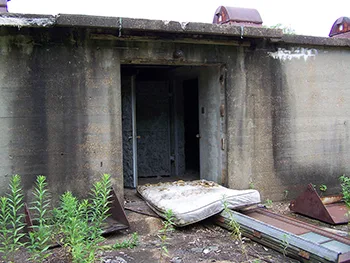
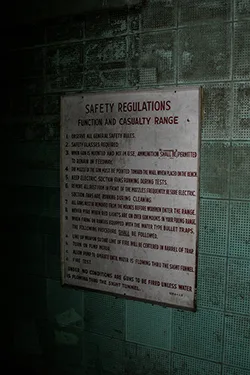 The munitions manufacturing facility that once stood here was built during WWII and saw use through the Vietnam War for the production of ammunition and airplanes. There are tunnels which once connected the factories and provided climate controlled underground storage, evidenced by the large empty rooms and aged compressor equipment. The tunnels themselves stretch for a good mile or so. Along the side of the busy road sits a conspicuous bunker, surrounded by a tall fence which is lined with razor wire. The lack of doors on this structure hints of the tunnels existence below. This small concrete shack was, in fact a machine-gun emplacement. Nearby, a long abandoned munition testing facility slowly crumbles. Falsely assuming there was a connection from the building just down the road, we headed there first. The ammunition produced in the Manufacturing Plant was tested at the Firing Range/Test Laboratory. It has a few small tunnels used for underground 50 cal target practice, but we found they do not connect directly to the main storage bunkers/tunnels. It was in an advanced state of disrepair with the exception of the area used as a firing range which had huge blast doors and reinforced concrete walls. Several nearby warehouses are being rented out, others are sitting vacant. To this day, the area is still mostly Federal Government owned.
The munitions manufacturing facility that once stood here was built during WWII and saw use through the Vietnam War for the production of ammunition and airplanes. There are tunnels which once connected the factories and provided climate controlled underground storage, evidenced by the large empty rooms and aged compressor equipment. The tunnels themselves stretch for a good mile or so. Along the side of the busy road sits a conspicuous bunker, surrounded by a tall fence which is lined with razor wire. The lack of doors on this structure hints of the tunnels existence below. This small concrete shack was, in fact a machine-gun emplacement. Nearby, a long abandoned munition testing facility slowly crumbles. Falsely assuming there was a connection from the building just down the road, we headed there first. The ammunition produced in the Manufacturing Plant was tested at the Firing Range/Test Laboratory. It has a few small tunnels used for underground 50 cal target practice, but we found they do not connect directly to the main storage bunkers/tunnels. It was in an advanced state of disrepair with the exception of the area used as a firing range which had huge blast doors and reinforced concrete walls. Several nearby warehouses are being rented out, others are sitting vacant. To this day, the area is still mostly Federal Government owned.
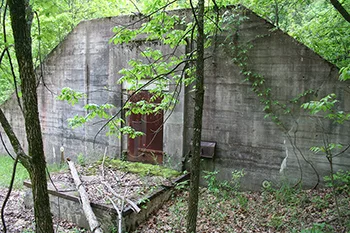
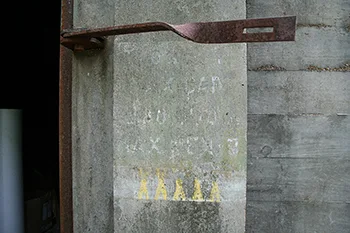 These bunkers were used to store explosives and other munitions during the Cold War. A major Saint Louis business owns it and has an already well secluded location even more well secured. We still managed to find a way in and after hiking for about 8 miles or more, we found a few bunkers. On our way out, we were supposed to take the scenic route and end up in the thick of bunkerland, but we took a wrong turn. At that point it was already late, so we decided to make it a point to return and find the rest some day.
These bunkers were used to store explosives and other munitions during the Cold War. A major Saint Louis business owns it and has an already well secluded location even more well secured. We still managed to find a way in and after hiking for about 8 miles or more, we found a few bunkers. On our way out, we were supposed to take the scenic route and end up in the thick of bunkerland, but we took a wrong turn. At that point it was already late, so we decided to make it a point to return and find the rest some day.
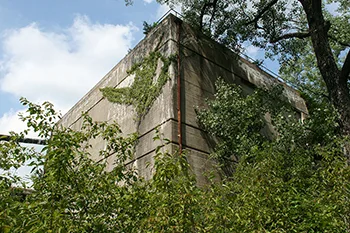
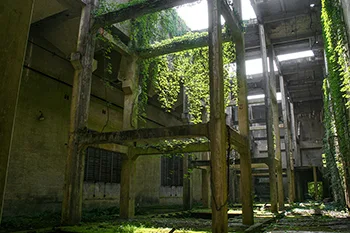 Hiding in the woods and thick overgrowth lie several deserted and almost completely forgotten behemoths of early-to-mid 20th century industry. I know only that these buildings were in some way originally involved in the processing of stone mined locally and were used in the construction of what was to be a massive scientific-industrial complex. I read they also had repair shops and all kinds of other factories out here, all working for a common interest. Their impressive size and the noises they once emitted earned them the collective title of "Mechanical City". Their individual, specific uses are beyond any guess I could possibly make but I am familiar with the buildings that these had been designed to help construct. This site is closely related to two nearby and much more well-known locations. In fact, it was built to facilitate their construction, one of which is the former Weldon Springs Ordnance Works, known to locals as the "Equadome". If you lived in Saint Charles up until the late '90s, you probably at least heard of the 'dome. It was built to produce TNT and other munitions during WWII. I know of no other place that had so many rumors attributed to it; from the supposed site of Satan worship, to several rapes and a death or two, it had quite the reputation. It was a massive industrial playground and was abandoned in the 60s. Unfortunately, it was demolished in 1998. It was built to withstand ordnance explosions and as a result proved to be very difficult to finally demolish. I was fortunate to have explored it several times, but I had no camera back then.
Hiding in the woods and thick overgrowth lie several deserted and almost completely forgotten behemoths of early-to-mid 20th century industry. I know only that these buildings were in some way originally involved in the processing of stone mined locally and were used in the construction of what was to be a massive scientific-industrial complex. I read they also had repair shops and all kinds of other factories out here, all working for a common interest. Their impressive size and the noises they once emitted earned them the collective title of "Mechanical City". Their individual, specific uses are beyond any guess I could possibly make but I am familiar with the buildings that these had been designed to help construct. This site is closely related to two nearby and much more well-known locations. In fact, it was built to facilitate their construction, one of which is the former Weldon Springs Ordnance Works, known to locals as the "Equadome". If you lived in Saint Charles up until the late '90s, you probably at least heard of the 'dome. It was built to produce TNT and other munitions during WWII. I know of no other place that had so many rumors attributed to it; from the supposed site of Satan worship, to several rapes and a death or two, it had quite the reputation. It was a massive industrial playground and was abandoned in the 60s. Unfortunately, it was demolished in 1998. It was built to withstand ordnance explosions and as a result proved to be very difficult to finally demolish. I was fortunate to have explored it several times, but I had no camera back then.
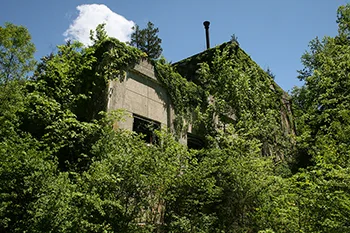
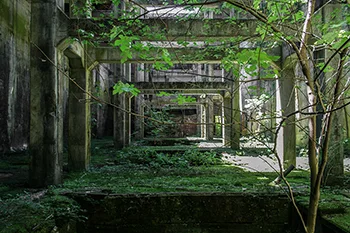 On this trip, we visited the East side of Mechanical City and found more random buildings scattered in the woods. The largest of these closely resembles one I visited previously on the Western edge, several miles away.
On this trip, we visited the East side of Mechanical City and found more random buildings scattered in the woods. The largest of these closely resembles one I visited previously on the Western edge, several miles away.
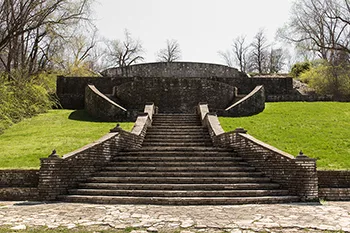
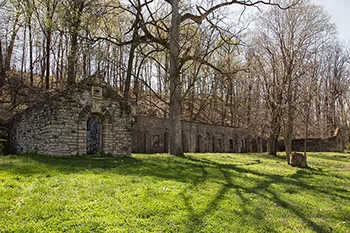 "Fort Bellefontaine was the first United States military installation west of the Mississippi in the new Louisiana Territory. Located on the south bank of the Missouri River, in present-day Missouri, Fort Bellefontaine was first a Spanish military post. After the Louisiana Purchase, by a treaty made between the United States Government, signed by William H. Harrison and representatives of the Native American Sac and Fox tribes (on November 3, 1804), the fort became a fur trading post of the United States Government. Rudolf Tiller served as factor and Col. Thomas Hunt served as first in command. The trading post was discontinued after 1808, and from 1809 to 1826 the facility served as a United States military fort. During that time period, from about 1809 to 1815, the fort served as the headquarters of the Department of Louisiana, and was the regional Army headquarters during the War of 1812. Its sister forts were Fort Osage along the Missouri near modern Kansas City, which controlled trade with western Indians; and Fort Madison in what is now Iowa, which controlled trade of the Upper Mississippi. Lewis and Clark's Corps of Discovery expedition (1804-1806) spent the first night of their expedition on an island opposite Cold Water Creek and their last night two years later at the fort, which had been established in their absence. Other major expeditions left from this site betweem 1805 and 1819 to explore the newly acquired Louisiana Territory. Until it was replaced by Jefferson Barracks in 1826, Fort Belle Fontaine was an important gathering place in the wilderness for officers and enlisted men, Native American, French, Spanish and American settlers, trappers and traders, and the local businessmen and farmers who supplied the fort with necessities." Today it is a scenic park and is open to the public.
"Fort Bellefontaine was the first United States military installation west of the Mississippi in the new Louisiana Territory. Located on the south bank of the Missouri River, in present-day Missouri, Fort Bellefontaine was first a Spanish military post. After the Louisiana Purchase, by a treaty made between the United States Government, signed by William H. Harrison and representatives of the Native American Sac and Fox tribes (on November 3, 1804), the fort became a fur trading post of the United States Government. Rudolf Tiller served as factor and Col. Thomas Hunt served as first in command. The trading post was discontinued after 1808, and from 1809 to 1826 the facility served as a United States military fort. During that time period, from about 1809 to 1815, the fort served as the headquarters of the Department of Louisiana, and was the regional Army headquarters during the War of 1812. Its sister forts were Fort Osage along the Missouri near modern Kansas City, which controlled trade with western Indians; and Fort Madison in what is now Iowa, which controlled trade of the Upper Mississippi. Lewis and Clark's Corps of Discovery expedition (1804-1806) spent the first night of their expedition on an island opposite Cold Water Creek and their last night two years later at the fort, which had been established in their absence. Other major expeditions left from this site betweem 1805 and 1819 to explore the newly acquired Louisiana Territory. Until it was replaced by Jefferson Barracks in 1826, Fort Belle Fontaine was an important gathering place in the wilderness for officers and enlisted men, Native American, French, Spanish and American settlers, trappers and traders, and the local businessmen and farmers who supplied the fort with necessities." Today it is a scenic park and is open to the public.
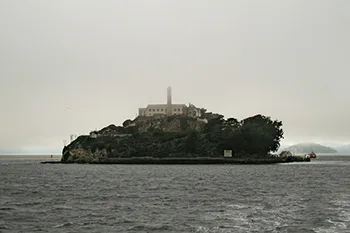
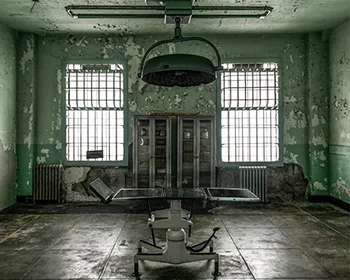 Alcatraz Island is located in the San Francisco Bay, 1.5 miles (2.4 km) offshore from San Francisco, California. Often referred to as "The Rock," the small island was developed with facilities for a lighthouse, a military fortification, a military prison (1868), and a federal prison from 1933 until 1963. Beginning in November 1969, the island was occupied for more than 19 months by a group of Aboriginal Peoples from San Francisco who were part of a wave of Native activism across the nation with public protests through the 1970s.
Alcatraz Island is located in the San Francisco Bay, 1.5 miles (2.4 km) offshore from San Francisco, California. Often referred to as "The Rock," the small island was developed with facilities for a lighthouse, a military fortification, a military prison (1868), and a federal prison from 1933 until 1963. Beginning in November 1969, the island was occupied for more than 19 months by a group of Aboriginal Peoples from San Francisco who were part of a wave of Native activism across the nation with public protests through the 1970s.
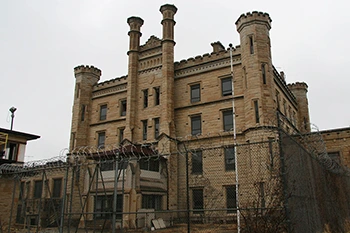
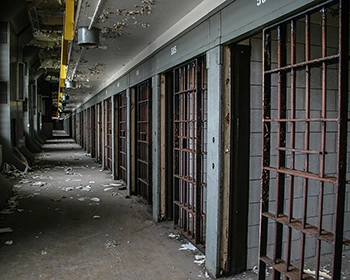 Joliet Maximum-Security Prison was opened in the mid-1800's. It was constructed through the use of convict labor. In the 1860's, it housed prisoners of the Civil War. By the late 1800's, it was the largest single prison in the U.S. In the early 1900's, one of the inmates murdered the then-currrent warden's wife and lit their house on fire with her inside. In the mid-1970's, one of the cell blocks was taken over by gangs...
Joliet Maximum-Security Prison was opened in the mid-1800's. It was constructed through the use of convict labor. In the 1860's, it housed prisoners of the Civil War. By the late 1800's, it was the largest single prison in the U.S. In the early 1900's, one of the inmates murdered the then-currrent warden's wife and lit their house on fire with her inside. In the mid-1970's, one of the cell blocks was taken over by gangs...

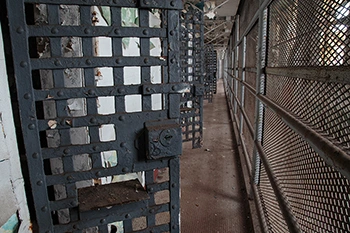 Tennessee State Prison is guarded, some buildings are active/alarmed and a high ranking government official lives on site..
Tennessee State Prison is guarded, some buildings are active/alarmed and a high ranking government official lives on site..
The Springfield County Courthouse cost 2 million dollars to build in 1909. Construction broke ground on August 21 of that year and the cornerstone was laid October 1909. It was completed on February 26, 1912.
When completed, this building was heralded as one of the best and "most perfect" Beaux-Arts style buildings ever designed. In fact, the government of Montreal asked permission to use the plans as models for a proposed courthouse in Canada.
There are 4 courtrooms in the center of the first floor, each set up similarly, having ten rooms for all of the necessary personnel such as witnesses, judges, prisoners, employees and probation officers. The second floor housed the First District Police Court, with the sheriff's office in the southeast corner. The prosecuting attorney and his staff was located in the northwest corner. The chief of police and the chief of detectives were located on the third floor with a newspaper office situated directly between the two. The Board of Election Commissioners was located in the southwest corner. The Police Court and the circuit attorney resided on the fourth floor. The grand jury was located on the fifth floor, with additional rooms for the assistant circuit attorney. Originally, there was supposed to be a six-story tower located at the center of the building but the decision was made to exclude the tower and save an estimated $70,000. This omission was regarded, by the architect, as a significant disservice to the overall aesthetic of the building but in the end there was nothing he could do to keep it in the plans.
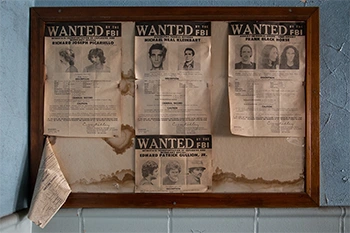
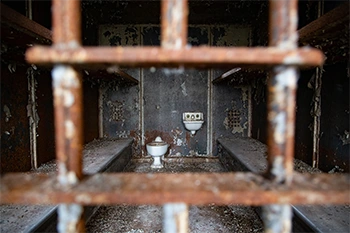 This police station was built in the 1930s and it closed down in 1987 at which point it appears they simply closed the doors and walked away. The power, and even the lights, have been left on the whole time which has created a goldilocks scenario leaving everything frozen in time like some sort of museum dedicated to "law enforcement as it existed prior to the age of computers". Aside from the natural elements slowly creeping in, what was hidden here behind doors has remained locked up, forgotten and unseen by just about anyone for nearly forty years. NSFW.
This police station was built in the 1930s and it closed down in 1987 at which point it appears they simply closed the doors and walked away. The power, and even the lights, have been left on the whole time which has created a goldilocks scenario leaving everything frozen in time like some sort of museum dedicated to "law enforcement as it existed prior to the age of computers". Aside from the natural elements slowly creeping in, what was hidden here behind doors has remained locked up, forgotten and unseen by just about anyone for nearly forty years. NSFW.
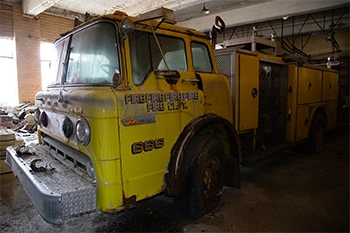
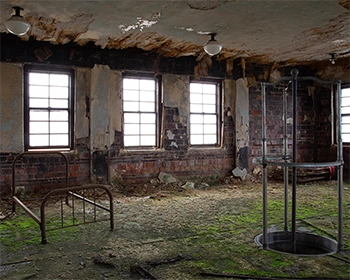 This Fire Station was constructed in the 1930's. It appears to have shut down in ~1990. The yellow truck is a mid-to-late 1980's Ford C900 series fire engine. It was surprising to find here considering that it was a current production model and probably still had that new car smell at the time of this station's closure. It could have been in use at another engine house until it was retired to the garage here, but it looks to me like it's been deteriorating where it sits for about as long as everything else. Even more surprising, though, was the one sitting next to it; The red truck is an American LaFrance Type 75 fire engine. This model was produced between 1915 and 1927. The Type 75 featured a 750gpm water pump and was the flagship model of its time. It's entirely possible that this Type 75 was in operation here in the early days of this facility..
This Fire Station was constructed in the 1930's. It appears to have shut down in ~1990. The yellow truck is a mid-to-late 1980's Ford C900 series fire engine. It was surprising to find here considering that it was a current production model and probably still had that new car smell at the time of this station's closure. It could have been in use at another engine house until it was retired to the garage here, but it looks to me like it's been deteriorating where it sits for about as long as everything else. Even more surprising, though, was the one sitting next to it; The red truck is an American LaFrance Type 75 fire engine. This model was produced between 1915 and 1927. The Type 75 featured a 750gpm water pump and was the flagship model of its time. It's entirely possible that this Type 75 was in operation here in the early days of this facility..
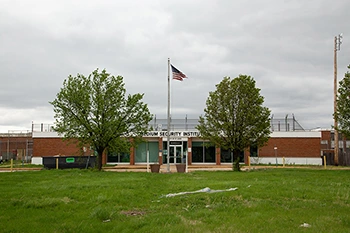
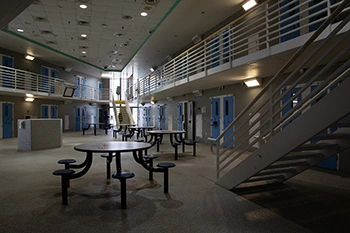 The Medium Security Institution (AKA The Workhouse) was constructed in Saint Louis in the 1960's. It was operational for about 60 years before reports of inhumane conditions brought about its eventual replacement and closure. There now appears to be some questionable renovation work being done inside-reportedly at the cost of millions of taxpayer dollars.
The Medium Security Institution (AKA The Workhouse) was constructed in Saint Louis in the 1960's. It was operational for about 60 years before reports of inhumane conditions brought about its eventual replacement and closure. There now appears to be some questionable renovation work being done inside-reportedly at the cost of millions of taxpayer dollars.
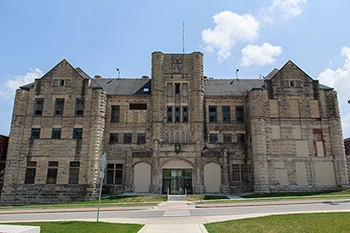
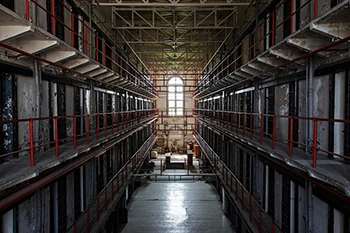 Missouri State Penitentiary began serving up hard time in 1836, the same month (March 1836) in which the infamous fall of the Alamo in Texas had occurred. It served as Missouri's primary maximum security institution before it closed in 2004, until which time it was the oldest operating prison west of the Mississippi.
Missouri State Penitentiary began serving up hard time in 1836, the same month (March 1836) in which the infamous fall of the Alamo in Texas had occurred. It served as Missouri's primary maximum security institution before it closed in 2004, until which time it was the oldest operating prison west of the Mississippi.
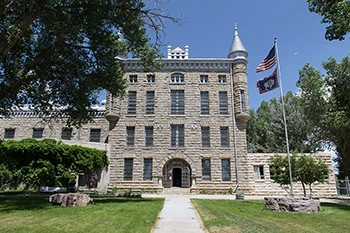
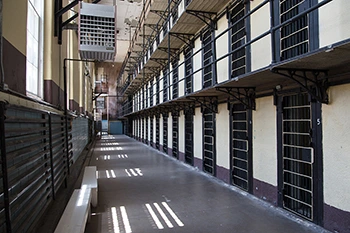 Wyoming State Penitentiary was constructed in 1901. During its 80 years in service, 250 people died here, of which only 14 people were officially executed by hanging or, later, the gas chamber which was installed in 1936. Others died of natural causes, suicide or inmate violence. One particular method of suicide involved running head first into the well-secured cafeteria tables. According to one notable inmate, whose documentary style journal was later found in the prison archives, and verified as true accounts, men were often sent to the "butcher shop" which was an operating room in the medical ward, never to return. Some also froze to death in the "dungeon". The prison didn't have electricity or running water when it was built and it wasn't until 1978 that they had hot water, and that only lasted three years before it closed in 1981.
Wyoming State Penitentiary was constructed in 1901. During its 80 years in service, 250 people died here, of which only 14 people were officially executed by hanging or, later, the gas chamber which was installed in 1936. Others died of natural causes, suicide or inmate violence. One particular method of suicide involved running head first into the well-secured cafeteria tables. According to one notable inmate, whose documentary style journal was later found in the prison archives, and verified as true accounts, men were often sent to the "butcher shop" which was an operating room in the medical ward, never to return. Some also froze to death in the "dungeon". The prison didn't have electricity or running water when it was built and it wasn't until 1978 that they had hot water, and that only lasted three years before it closed in 1981.
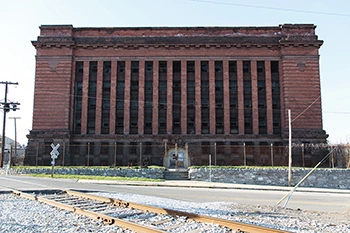
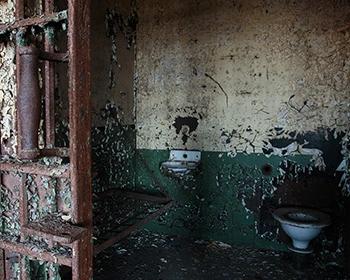 York County Prison was constructed around 1906 and closed roughly 70 years later when a new prison was built. This prison gained notoriety when it was found to have been serving road-kill to inmates.
York County Prison was constructed around 1906 and closed roughly 70 years later when a new prison was built. This prison gained notoriety when it was found to have been serving road-kill to inmates.
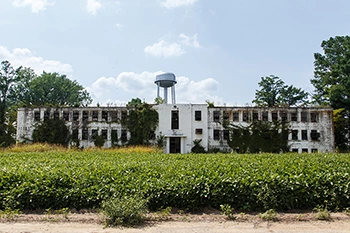
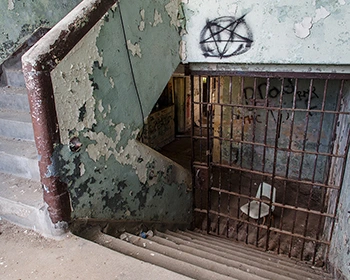 Renz Correctional Center was opened in 1961 as a high-security prison for female offenders. It was designed to hold about 500 prisoners and was known as Renz Farm because it was used to raise chicken and grow produce. Its most notable place in history pertains to the escape of James Earl Ray from the Missouri State Penitentiary just down the road. He managed to hide inside a delivery truck that was heading to Renz to deliver bread. At some point along the route, he got out and was on the run for about a year...
Renz Correctional Center was opened in 1961 as a high-security prison for female offenders. It was designed to hold about 500 prisoners and was known as Renz Farm because it was used to raise chicken and grow produce. Its most notable place in history pertains to the escape of James Earl Ray from the Missouri State Penitentiary just down the road. He managed to hide inside a delivery truck that was heading to Renz to deliver bread. At some point along the route, he got out and was on the run for about a year...
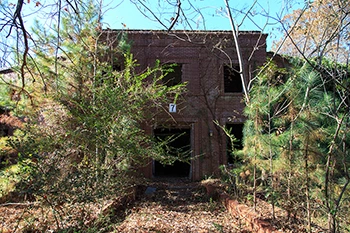
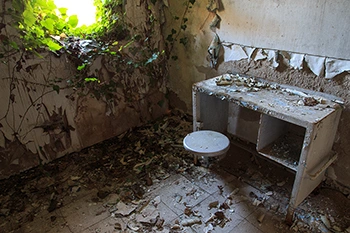 The Youth Detention Center in Atlanta Georgia was built in 1914 as a women's reformatory. Eventually, it was converted and expanded to become a Youth Detention Center. The campus is rather large and there are about 10 buildings on site consisting of the detention facility which contains about 100 cells as well as a recreation building with a theater, pool and classrooms. There is also an administration building and a cafeteria among others. The detention center closed in the late 90s but some buildings remained in use by a mental health provider until around 2006.
The Youth Detention Center in Atlanta Georgia was built in 1914 as a women's reformatory. Eventually, it was converted and expanded to become a Youth Detention Center. The campus is rather large and there are about 10 buildings on site consisting of the detention facility which contains about 100 cells as well as a recreation building with a theater, pool and classrooms. There is also an administration building and a cafeteria among others. The detention center closed in the late 90s but some buildings remained in use by a mental health provider until around 2006.

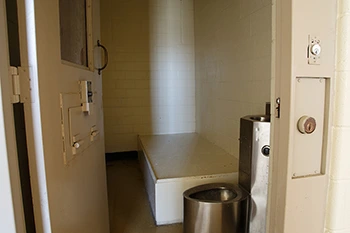 Youth Detention Center #2 was constructed in the early 1900's. At its peak, 150 juveniles were housed here. The facility produced much of its own food, having some fields set aside for corn and vegetables and others for cows and pigs. The inmates themselves were involved in some of the farming operations here. In more recent years, the numbers of residents were significantly reduced due to less juveniles in the systems as well as alternative social service programs. After 100 years of operation, the Detention Center closed for good in 2008.
Youth Detention Center #2 was constructed in the early 1900's. At its peak, 150 juveniles were housed here. The facility produced much of its own food, having some fields set aside for corn and vegetables and others for cows and pigs. The inmates themselves were involved in some of the farming operations here. In more recent years, the numbers of residents were significantly reduced due to less juveniles in the systems as well as alternative social service programs. After 100 years of operation, the Detention Center closed for good in 2008.
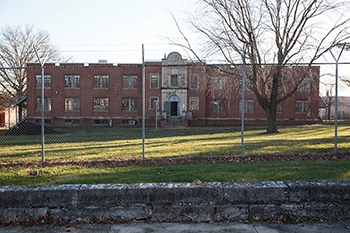
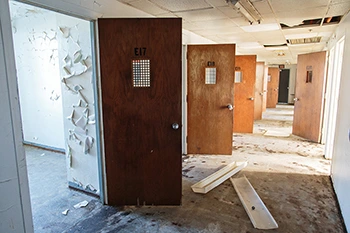 Chillicothe Women's Prison was originally constructed in 1888 as an industrial home for girls. Their mission statement summarizes their objective of being a place where "girls, removed from the vicious associates and evil influences, may receive careful physical, intellectual and moral training, participate in enjoyment of a true home life, be reformed and become good domestic women prudent in speech and conducts, cleanly industrious and capable housekeepers." Most girls were between the ages of 13 and 17 but some were as young as 10 and others, as old as 20 and they were assigned here by juvenile court and county court judges. On average, most girls who were admitted here served three years. The home was predominantly self-sufficient, having produced the food served on site at the home's farm and the clothing the inmates wore was made in their own domestic arts classes. According to the records of the 1918 harvest, their farm produced some "5,685 pounds of cabbage; 752 lbs of beets; 1,170 dozen ears of sweet corn; 692 pounds of eggplant; 453 bushels of tomatoes; 1943 pounds of greens; 1,741 heads of lettuce; and, 3737 dozen radishes". Various changes through the 30s, 50s and 60s included demolition of some attractive Victorian architecture, notably the Marmaduke Cottage which was replaced by the modernist utilitarian Blair and Donnelly Cottage housing units which comprise the main prison buildings now visible from the road. The only remaining original buildings include the McReynold's school building and the Power House, neither of which feature prominently in the overall layout of the current site.
Chillicothe Women's Prison was originally constructed in 1888 as an industrial home for girls. Their mission statement summarizes their objective of being a place where "girls, removed from the vicious associates and evil influences, may receive careful physical, intellectual and moral training, participate in enjoyment of a true home life, be reformed and become good domestic women prudent in speech and conducts, cleanly industrious and capable housekeepers." Most girls were between the ages of 13 and 17 but some were as young as 10 and others, as old as 20 and they were assigned here by juvenile court and county court judges. On average, most girls who were admitted here served three years. The home was predominantly self-sufficient, having produced the food served on site at the home's farm and the clothing the inmates wore was made in their own domestic arts classes. According to the records of the 1918 harvest, their farm produced some "5,685 pounds of cabbage; 752 lbs of beets; 1,170 dozen ears of sweet corn; 692 pounds of eggplant; 453 bushels of tomatoes; 1943 pounds of greens; 1,741 heads of lettuce; and, 3737 dozen radishes". Various changes through the 30s, 50s and 60s included demolition of some attractive Victorian architecture, notably the Marmaduke Cottage which was replaced by the modernist utilitarian Blair and Donnelly Cottage housing units which comprise the main prison buildings now visible from the road. The only remaining original buildings include the McReynold's school building and the Power House, neither of which feature prominently in the overall layout of the current site.
The Old Federal Building in Hannibal Missouri was completed in 1888 and is the second oldest civil structure in Missouri. Local congressman William Henry Hatch is credited for rescuing this building when construction was suspended at the second floor due to insufficient funds. Fearing the building would have to be truncated prior to completion, he was able to get additional appropriations through congress in order to complete the building as originally designed. This building takes design cues from the Old Post Office building in Saint Louis, both of which are considered examples of "Second Empire" style. The Oak and Pine hardwood found throughout the interior was supplied in 1888 and retains its natural finish in the large Court Room on the third floor. Among other tenants, the building housed the Post Office, the Internal Revenue Service, Army and Navy recruiters and even the Prohibition Enforcement Office during prohibition. The upper levels were last occupied by the Navy until they vacated in 1979. Since then it has been sporadically rented out to various short-term tenants but now it is mostly vacant.
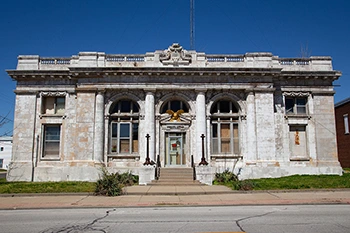
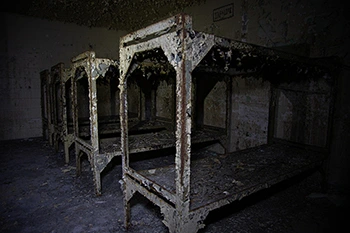 The old Vernon County Jail in Nevada, Missouri was originally constructed as the new U.S. Post Office in 1909 and now, over 100 years later, it stands out as one of the more beautifully designed structures in this part of the state. This is explained by the fact that it was designed by notable architect James Knox Taylor who, at the turn of the 20th Century, was Supervising Architect of the United States Department of the Treasury. Taylor is listed as Supervising Architect of hundreds of Federal buildings during his time. Some of these buildings include the Ellis Island Immigrant Hospital (1908), The Denver Mint (1897) and a variety of other federal buildings and post offices across the country. Sharing many architectural elements and design cues of other work attributed to Taylor, this building which is located in the little middle-of-nowhere town of Nevada, Missouri, is nearly identical to the Post Office credited to him in Niagra Falls, New York as can be seen on his Wikipedia page here. After 52 years of service, a new post office of an objectively uglier but probably more efficient design was being constructed in 1961 and by 1963 the old post office was taken over by the local Sherrif's department to serve as their new offices and county jail.
The old Vernon County Jail in Nevada, Missouri was originally constructed as the new U.S. Post Office in 1909 and now, over 100 years later, it stands out as one of the more beautifully designed structures in this part of the state. This is explained by the fact that it was designed by notable architect James Knox Taylor who, at the turn of the 20th Century, was Supervising Architect of the United States Department of the Treasury. Taylor is listed as Supervising Architect of hundreds of Federal buildings during his time. Some of these buildings include the Ellis Island Immigrant Hospital (1908), The Denver Mint (1897) and a variety of other federal buildings and post offices across the country. Sharing many architectural elements and design cues of other work attributed to Taylor, this building which is located in the little middle-of-nowhere town of Nevada, Missouri, is nearly identical to the Post Office credited to him in Niagra Falls, New York as can be seen on his Wikipedia page here. After 52 years of service, a new post office of an objectively uglier but probably more efficient design was being constructed in 1961 and by 1963 the old post office was taken over by the local Sherrif's department to serve as their new offices and county jail.
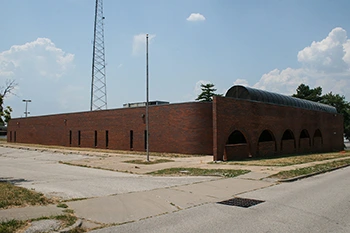
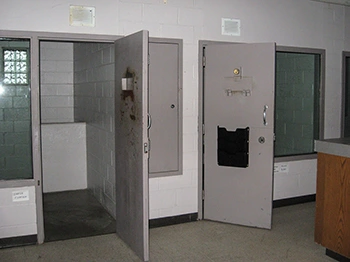 This was a particularly exciting solo explore because it was a revisit.. But it wasn't that kind of revisit since I had never explored it before. As the post title implies: this is a police station. And not just any police station. This is one I'm very familiar with. You see, I've actually been locked up here once.. or twice.. upon a time. Not only have I spent several days incarcerated here, but I've paid numerous tickets and appeared in court here before. It was incredibly good to be back under entirely different circumstances this time. Needless to say, I feel very satisfied about my relationship with this place.
This was a particularly exciting solo explore because it was a revisit.. But it wasn't that kind of revisit since I had never explored it before. As the post title implies: this is a police station. And not just any police station. This is one I'm very familiar with. You see, I've actually been locked up here once.. or twice.. upon a time. Not only have I spent several days incarcerated here, but I've paid numerous tickets and appeared in court here before. It was incredibly good to be back under entirely different circumstances this time. Needless to say, I feel very satisfied about my relationship with this place.
Saint Mary's Infirmary was built in 1889 with various additions through the 1940's. The well-renowned SSM Healthcare actually began here at this location. According to the history page of SSM's own website "SSM Health Care traces its roots to 1872, when Mother Mary Odilia Berger and four other sisters came to St. Louis from Germany, after caring for sick and wounded soldiers during the Franco-Prussian War. Facing religious persecution in Germany, they came to the United States for two reasons: to preserve their call to live in religious community and to be of service to people in need...
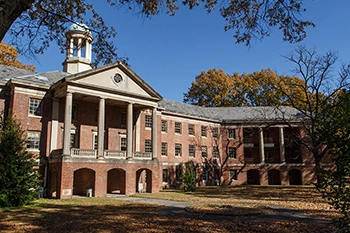
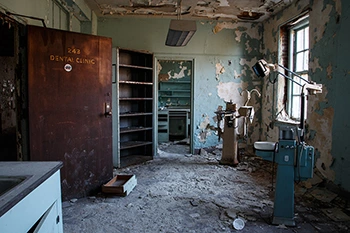 The Memphis Marine Hospital traces its history back to 1798 when President John Adams established the first Marine Hospital Service as a precursor to the U.S. Public Health Service. Its mission was to provide medical services for injured riverboat workers. The first hospital was destroyed when the river changed course and the new hospital opened in this location as its replacement in 1884. The 1884 hospital was soon obsolete and the rise in demand for medical care necessitated its replacement which was completed in 1936 at the cost of 1 million dollars.
The Memphis Marine Hospital traces its history back to 1798 when President John Adams established the first Marine Hospital Service as a precursor to the U.S. Public Health Service. Its mission was to provide medical services for injured riverboat workers. The first hospital was destroyed when the river changed course and the new hospital opened in this location as its replacement in 1884. The 1884 hospital was soon obsolete and the rise in demand for medical care necessitated its replacement which was completed in 1936 at the cost of 1 million dollars.
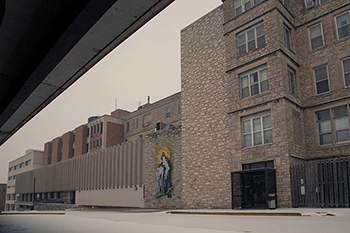
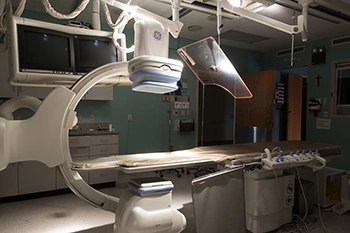 This hospital opened in the early 1900s and remained in service at this location for a little over 100 years. It just closed recently.
This hospital opened in the early 1900s and remained in service at this location for a little over 100 years. It just closed recently.
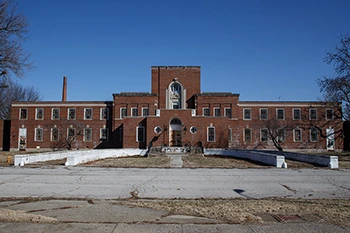
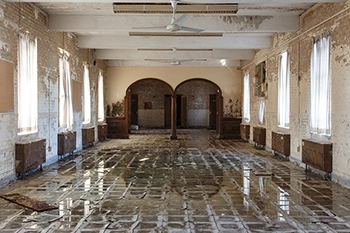 The Asylum was constructed in the early 1900s to treat, house and care for the insane. Just four years after it opened, they already had nearly 1,000 patients living here. The facility utilized many common treatment options of the time, including Hydrotherapy and Electro-Shock Therapy. Lobotomies were also regularly performed here, in some cases as often as forty times a year.
The Asylum was constructed in the early 1900s to treat, house and care for the insane. Just four years after it opened, they already had nearly 1,000 patients living here. The facility utilized many common treatment options of the time, including Hydrotherapy and Electro-Shock Therapy. Lobotomies were also regularly performed here, in some cases as often as forty times a year.
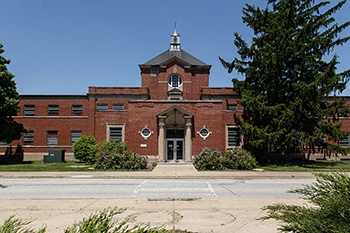
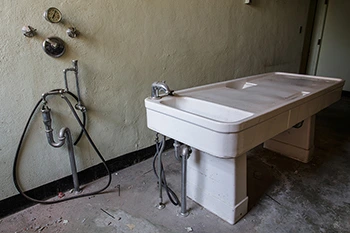 Asylum #2, aka CPR Dummy State Hospital for the Insane, is part of an old mental hospital which began at this site in the mid 1800's. Most of the original buildings have been demolished but the facility remained in operation, even expanding to newer buildings, until just within the past few years. One resident here, Anne Resusci, would become famous after gaining her freedom by initiating reform within the systems of mental health. She was later transformed into a CPR Dummy with short stubby arms by a wicked witch who cast a spell on her.
Asylum #2, aka CPR Dummy State Hospital for the Insane, is part of an old mental hospital which began at this site in the mid 1800's. Most of the original buildings have been demolished but the facility remained in operation, even expanding to newer buildings, until just within the past few years. One resident here, Anne Resusci, would become famous after gaining her freedom by initiating reform within the systems of mental health. She was later transformed into a CPR Dummy with short stubby arms by a wicked witch who cast a spell on her.
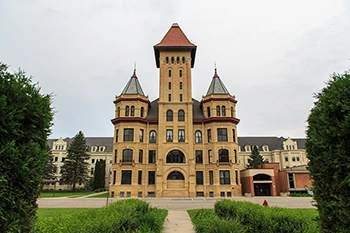
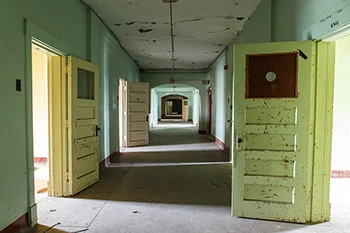 Fergus Falls State Hospital was constructed between 1890 and 1912. The first portion to be completed opened its doors on July 29, 1890. The main building was completed shortly thereafter, in 1912. It was originally conceived in 1885 as the Third Minnesota State Hospital for the Insane and the name was later changed when the location was decided upon, that being Fergus Falls Minnesota. This massive castle-like structure is a third of a mile long and has the distinction of being one of the last Kirkbrides built in the United States.
Fergus Falls State Hospital was constructed between 1890 and 1912. The first portion to be completed opened its doors on July 29, 1890. The main building was completed shortly thereafter, in 1912. It was originally conceived in 1885 as the Third Minnesota State Hospital for the Insane and the name was later changed when the location was decided upon, that being Fergus Falls Minnesota. This massive castle-like structure is a third of a mile long and has the distinction of being one of the last Kirkbrides built in the United States.
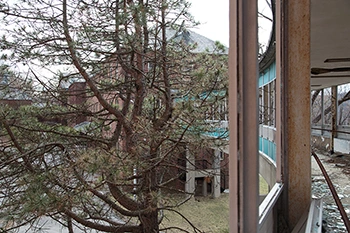
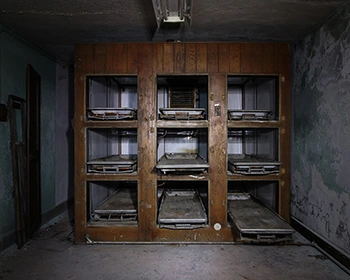 Harlem Valley State Hospital was built in the 1920's and closed in the 1990's. It was originally supposed to be a prison but after construction had already begun, it was converted into a psychiatric hospital for the insane. This facility practiced both insulin and electro-shock therapy in addition to lobotomies. It is a massive campus and is surprisingly well-secured by the new owners who are slowly renovating parts of it. And they're not too fond of curious trespassers; There were no less than 4 separate security vehicles actively patrolling the site on the day of our visit and they missed us by mere seconds..
Harlem Valley State Hospital was built in the 1920's and closed in the 1990's. It was originally supposed to be a prison but after construction had already begun, it was converted into a psychiatric hospital for the insane. This facility practiced both insulin and electro-shock therapy in addition to lobotomies. It is a massive campus and is surprisingly well-secured by the new owners who are slowly renovating parts of it. And they're not too fond of curious trespassers; There were no less than 4 separate security vehicles actively patrolling the site on the day of our visit and they missed us by mere seconds..
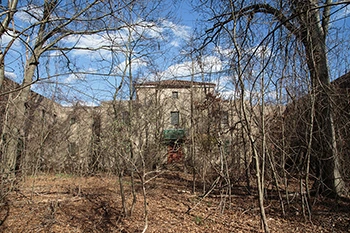
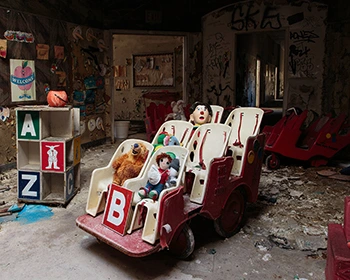 Rockland Psychiatric Center was originally opened in 1927 with over 5,000 beds. At its peak, it housed over 9,000 psychiatric patients with a staff of 2,000. Along with most other psychiatric hospitals, new medicines and specialized treatments came into favor by the 1970's and these took the place of more controversial treatments such as Electro-Shock therapy and Pre-Frontal Lobotomies. These new treatment methods resulted in better recovery thus increasing discharge rates and greatly reducing the need for such a high capacity of patients in such massive campuses.
Rockland Psychiatric Center was originally opened in 1927 with over 5,000 beds. At its peak, it housed over 9,000 psychiatric patients with a staff of 2,000. Along with most other psychiatric hospitals, new medicines and specialized treatments came into favor by the 1970's and these took the place of more controversial treatments such as Electro-Shock therapy and Pre-Frontal Lobotomies. These new treatment methods resulted in better recovery thus increasing discharge rates and greatly reducing the need for such a high capacity of patients in such massive campuses.
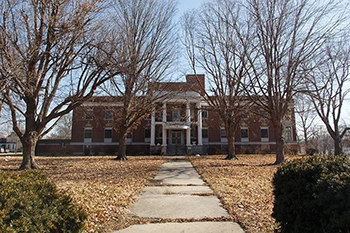
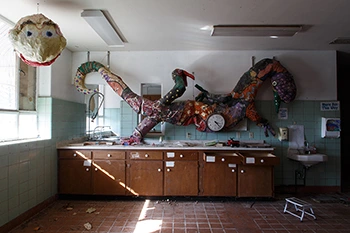 Our expedition started off normally enough, but strange hallucinations soon confused all of our senses. Something felt quite "off" here the moment we stepped inside but the journey had only just begun. We continued onward, going deeper inside the darkness until we merged with the shadows. A technicolor horse lie sleeping in the hallway. Was he guarding the elevator or perhaps waiting for his rider to return from some other level? We silently slipped past, careful not to wake him. We'll just take the stairs. Paintings on the wall depicted devilish scenes and dinosaur kings. A blue man melted in the stairway. What strange trip was now taking hold of us? I began to replay the last few meals I had, hoping to recall consuming anything questionable which might explain the things I was seeing. Eventually we found ourselves on the next floor. I'm certain it was either the basement or the roof. A lizard crawled across the wall with a clock on his back. The time on the lizard was 3:22 but I knew damn well it was only 11:30. No sense in arguing, I thought. I didn't like my odds in a fight with a reptile twice my size. Snakes hissed from the eyes of an Aztec sun. Curling and menacing they coiled around my mind, choking what little coherency I had left.
Our expedition started off normally enough, but strange hallucinations soon confused all of our senses. Something felt quite "off" here the moment we stepped inside but the journey had only just begun. We continued onward, going deeper inside the darkness until we merged with the shadows. A technicolor horse lie sleeping in the hallway. Was he guarding the elevator or perhaps waiting for his rider to return from some other level? We silently slipped past, careful not to wake him. We'll just take the stairs. Paintings on the wall depicted devilish scenes and dinosaur kings. A blue man melted in the stairway. What strange trip was now taking hold of us? I began to replay the last few meals I had, hoping to recall consuming anything questionable which might explain the things I was seeing. Eventually we found ourselves on the next floor. I'm certain it was either the basement or the roof. A lizard crawled across the wall with a clock on his back. The time on the lizard was 3:22 but I knew damn well it was only 11:30. No sense in arguing, I thought. I didn't like my odds in a fight with a reptile twice my size. Snakes hissed from the eyes of an Aztec sun. Curling and menacing they coiled around my mind, choking what little coherency I had left.

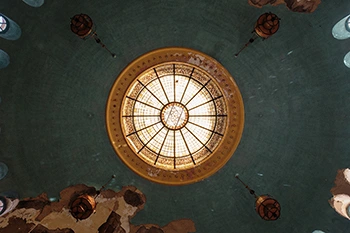 The Tuberculosis Hospital was constructed on 300 acres of scenic woodland in the early 1900's to treat the growing Tuberculosis epidemic in the United States. Tuberculosis is an infectious disease which generally affects the lungs, causing chronic bloody coughing fits. It also causes weight loss and due to this was known as "consumption" in the early years of its outbreak. The most common treatment generally involved "Heliotherapy" which was simply being exposed to sunlight for extended periods of time. And this was not without merit; exposure to sunlight does help kill the Tuberculosis causing bacteria as does Vitamin D which the body produces more of with sunlight exposure. For these reasons, The Tuberculosis Hospital was designed with large patios on each wing for patients to be relax in the sunlight and fresh country air.
The Tuberculosis Hospital was constructed on 300 acres of scenic woodland in the early 1900's to treat the growing Tuberculosis epidemic in the United States. Tuberculosis is an infectious disease which generally affects the lungs, causing chronic bloody coughing fits. It also causes weight loss and due to this was known as "consumption" in the early years of its outbreak. The most common treatment generally involved "Heliotherapy" which was simply being exposed to sunlight for extended periods of time. And this was not without merit; exposure to sunlight does help kill the Tuberculosis causing bacteria as does Vitamin D which the body produces more of with sunlight exposure. For these reasons, The Tuberculosis Hospital was designed with large patios on each wing for patients to be relax in the sunlight and fresh country air.
It was only after WWII that widespread use of Tuberculosis vaccines would occur. The 1946 development of the antibiotic streptomycin effectively cured the disease. This finally ended the reign of TB and now that the disease was under control, many such hospitals closed around this time. This Tuberculosis hospital was therefore active only until the 1960's. Afterward it was converted to a developmental center for mentally and physically handicapped patients and it remained in that capacity until the mid 1990's at which point it was abandoned. Since the closure of the hospital, new drug-resistant strains of TB had emerged in the 1980s and now, it is estimated that roughly 1/3 of the world's population is currently infected. In 2014 alone, 1.5 million people died from the disease.
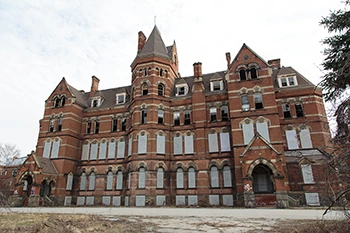
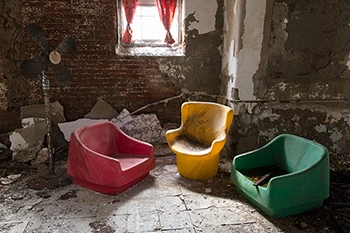 Hudson River State Hospital is a "Victorian Gothic" styled Kirkbride Hospital for the Insane which was constructed in New York in 1868 and opened on October 18, 1871. Construction took over 25 years to complete and was heavily criticized for cost overruns and delays. It operated until 2003 when facilities were consolidated with other local hospitals and it has been abandoned ever since. Demolition is set to begin any day now.
Hudson River State Hospital is a "Victorian Gothic" styled Kirkbride Hospital for the Insane which was constructed in New York in 1868 and opened on October 18, 1871. Construction took over 25 years to complete and was heavily criticized for cost overruns and delays. It operated until 2003 when facilities were consolidated with other local hospitals and it has been abandoned ever since. Demolition is set to begin any day now.
Forest Park Hospital, formerly Deaconess Central Hospital, was founded in 1889. The hospital was constructed at its present location by the time of the World's Fair in 1904 when the world's first neonatal incubator was proudly displayed here.*
The hospital remained a non-profit institution until 1997 when it was sold to Tenent Health Care of Texas. The hospital was sold again several times during the next few years, finally ending up in the hands of Success Health Care, a joint partnership group from Florida
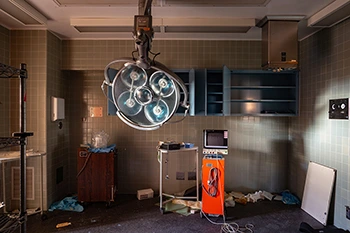
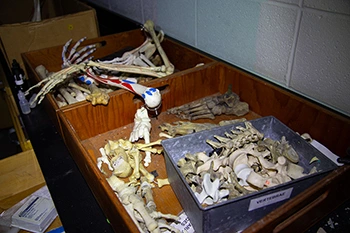 When this hospital was still semi-operational it was a pretty surreal environment in which to find yourself; On one floor you'd encounter a typical medical office with clean hallways and receptionists who occasionally called out the names of bored magazine readers. Just around the corner from the waiting room, a normal looking staircase transported you to an alternate-reality version of the same space you just passed through. The muffled sounds of a still active hospital wing faintly reverberated through the long unswept hallways and heavy shadows of the floor above. There's a definite tension in the air when you know that you're not alone inside and you've become unsure of the quickest route to the nearest exit. Some stairwells were locked on one floor but open on another which effectively made the whole place a sprawling 3D puzzle you needed to solve in order to get to the next level. Occasionally a nurse would require something stored in a deactivated wing and they were always escorted by security. The elevators would randomly come to life with sudden buzzing/rattling noise which usually gave you just enough time to duck before the familiar "ding" as the doors opened. Sometimes it dinged on the floor above and other times it happened right around the corner from you. Most of the time you were too far away to hear anything so you never could be sure where exactly the riders disembarked-or if anyone was there at all.
When this hospital was still semi-operational it was a pretty surreal environment in which to find yourself; On one floor you'd encounter a typical medical office with clean hallways and receptionists who occasionally called out the names of bored magazine readers. Just around the corner from the waiting room, a normal looking staircase transported you to an alternate-reality version of the same space you just passed through. The muffled sounds of a still active hospital wing faintly reverberated through the long unswept hallways and heavy shadows of the floor above. There's a definite tension in the air when you know that you're not alone inside and you've become unsure of the quickest route to the nearest exit. Some stairwells were locked on one floor but open on another which effectively made the whole place a sprawling 3D puzzle you needed to solve in order to get to the next level. Occasionally a nurse would require something stored in a deactivated wing and they were always escorted by security. The elevators would randomly come to life with sudden buzzing/rattling noise which usually gave you just enough time to duck before the familiar "ding" as the doors opened. Sometimes it dinged on the floor above and other times it happened right around the corner from you. Most of the time you were too far away to hear anything so you never could be sure where exactly the riders disembarked-or if anyone was there at all.
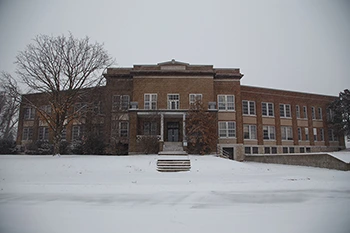
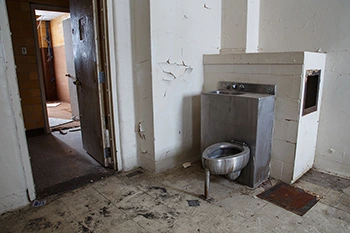 Portions of Fulton State Hospital date back to the mid 1800's. Unfortunately the original "Kirkbride" Asylum building caught fire and was demolished in the 1950's.. but the tunnel system still remains underground. Today, a few older buildings remain on the campus and are obviously in a state of disrepair. On this trip, we entered two of them. These two buildings were constructed in the early 1900's and were in use up until the late 1990's. Building #1 appears to have been an activities building as it features several floor plans of spacious open rooms with large windows in addition to some resident housing and day rooms. On the lower level there is one prison cell type room likely used for disruptive patients. Building #2, constructed in 1910 appears to have been primarily used as housing as evidenced by rows of tiny rooms sandwiched together on both levels.
Portions of Fulton State Hospital date back to the mid 1800's. Unfortunately the original "Kirkbride" Asylum building caught fire and was demolished in the 1950's.. but the tunnel system still remains underground. Today, a few older buildings remain on the campus and are obviously in a state of disrepair. On this trip, we entered two of them. These two buildings were constructed in the early 1900's and were in use up until the late 1990's. Building #1 appears to have been an activities building as it features several floor plans of spacious open rooms with large windows in addition to some resident housing and day rooms. On the lower level there is one prison cell type room likely used for disruptive patients. Building #2, constructed in 1910 appears to have been primarily used as housing as evidenced by rows of tiny rooms sandwiched together on both levels.
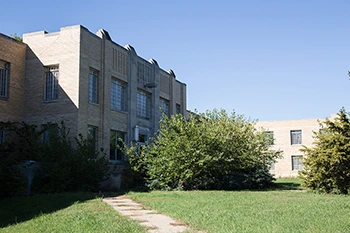
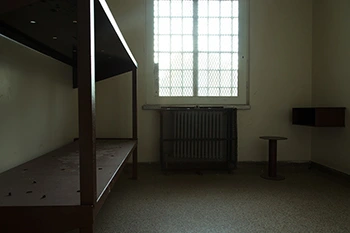 Asylum #7 was constructed in the early 1900's. It began life as an "..Asylum for the Insane", then it was partially converted to a prison. Currently, the campus houses an active prison facility with a handful of vacant buildings scattered among the active ones. Just like the recently penetrated "Government Health Campus", it appears that the current ownership of this location has been enough of a deterrent to keep most people away.. this is an active prison.. The building presented below was the former men's prison barracks and has been vacant for 11 years. We also explored the extent of the tunnels which connect all of the buildings. Due to the nature of exploring partially active locations, I only took the time to photograph what you see below. The rest of the action can be seen in the video from this trip.
Asylum #7 was constructed in the early 1900's. It began life as an "..Asylum for the Insane", then it was partially converted to a prison. Currently, the campus houses an active prison facility with a handful of vacant buildings scattered among the active ones. Just like the recently penetrated "Government Health Campus", it appears that the current ownership of this location has been enough of a deterrent to keep most people away.. this is an active prison.. The building presented below was the former men's prison barracks and has been vacant for 11 years. We also explored the extent of the tunnels which connect all of the buildings. Due to the nature of exploring partially active locations, I only took the time to photograph what you see below. The rest of the action can be seen in the video from this trip.
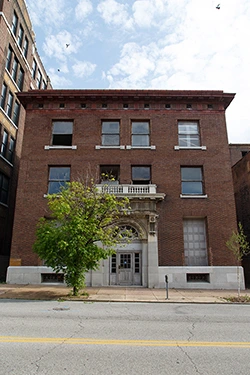
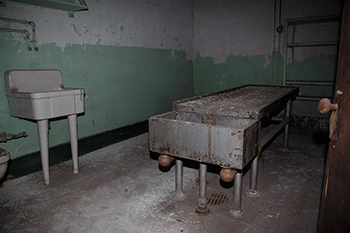 The People's Hospital was constructed in 1909 by a benevolent society, the Saint Louis Provident Association, which was one of the earliest such groups dedicated to social work. The building was converted into a hospital after the People's Hospital group purchased it in 1944. They opened their doors on October 10th and here they operated a 75 room short term non-profit hospital serving primarily African Americans. The People's Hospital also ran a nursing school at this location, one of the only post-secondary education opportunities for minority women in the area. The People's Hospital closed in 1967. It would house a home for the blind until 1972, but since then it has been mostly vacant.
The People's Hospital was constructed in 1909 by a benevolent society, the Saint Louis Provident Association, which was one of the earliest such groups dedicated to social work. The building was converted into a hospital after the People's Hospital group purchased it in 1944. They opened their doors on October 10th and here they operated a 75 room short term non-profit hospital serving primarily African Americans. The People's Hospital also ran a nursing school at this location, one of the only post-secondary education opportunities for minority women in the area. The People's Hospital closed in 1967. It would house a home for the blind until 1972, but since then it has been mostly vacant.
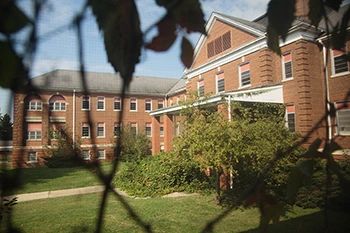
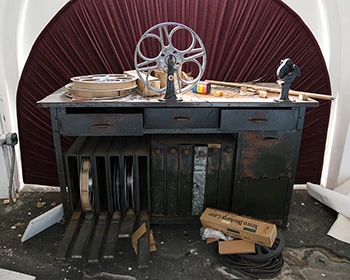 Government Health Campus was originally constructed about 100 years ago. We explored 9 of the buildings on site and all of the tunnels which connected them. According to my comrade's smart device, this included over 6 miles of walking (indoors) and countless stairwells by the time it was over. What we found inside was rather disappointing, however. It seems the organization which owns the site, while being notoriously inefficient in many other areas, was quite efficient at cleaning the place out. As a result, there wasn't much to see other than hallways and empty rooms. There are about 9 individual buildings represented below.
Government Health Campus was originally constructed about 100 years ago. We explored 9 of the buildings on site and all of the tunnels which connected them. According to my comrade's smart device, this included over 6 miles of walking (indoors) and countless stairwells by the time it was over. What we found inside was rather disappointing, however. It seems the organization which owns the site, while being notoriously inefficient in many other areas, was quite efficient at cleaning the place out. As a result, there wasn't much to see other than hallways and empty rooms. There are about 9 individual buildings represented below.
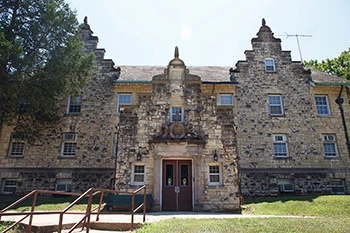
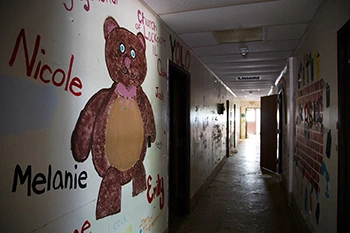 Asylum #9 was constructed in rural Missouri the mid 1800's. It closed down a couple of months ago.
Asylum #9 was constructed in rural Missouri the mid 1800's. It closed down a couple of months ago.
DePaul Hospital is now a Nursing Home. The majority of it is an active senior living community. On the other side of certain doors, however, you will find the abandoned remnants of its former days as a hospital. Here, we have an entire wing left to rot.
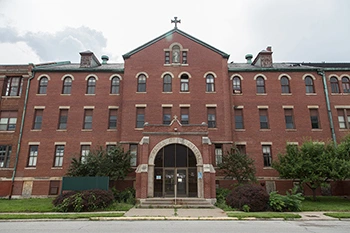
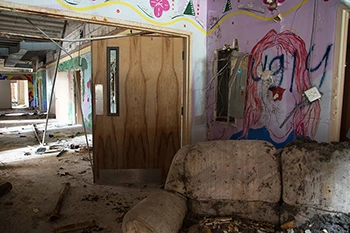 Saint Elizabeth Hospital in Hannibal, Missouri was built in stages beginning in 1915 and continuing through the 1970s. It was the first private hospital in the area and was founded by the Sisters of St Francis. Various additions throughout the years were devised to keep up with medical advances, such as x-ray equipment, iron lungs and new operating theaters. This hospital was dedicated to providing the best care possible and was described as "one of the best appointed hospitals in the state" and "among the most modern in the country". St Elizabeth's remained active until the replacement building was erected in the early 1990s. It was subsequently used by a variety of other businesses until 2009. Sadly, the once proud medical building now languishes in an advanced state of disrepair.
Saint Elizabeth Hospital in Hannibal, Missouri was built in stages beginning in 1915 and continuing through the 1970s. It was the first private hospital in the area and was founded by the Sisters of St Francis. Various additions throughout the years were devised to keep up with medical advances, such as x-ray equipment, iron lungs and new operating theaters. This hospital was dedicated to providing the best care possible and was described as "one of the best appointed hospitals in the state" and "among the most modern in the country". St Elizabeth's remained active until the replacement building was erected in the early 1990s. It was subsequently used by a variety of other businesses until 2009. Sadly, the once proud medical building now languishes in an advanced state of disrepair.
City Hospital was originally built in 1846. Well the first one was, but it burned to the ground 10 years later. So the new City Hospital was built in 1857... But then the "Great Cyclone" of 1896 hit Saint Louis and utterly destroyed the hospital. So the new, new, City Hospital was eventually built in 1906. And it only expanded from there. By 1970 there were 12 buildings on site. But only 15 years later, in 1985, the institution moved and abandoned its former home. I don't have many regrets, but I do regret missing out on City Hospital in all its abandoned glory. It was a massive old hospital. And as far as abandoned hospitals go, at least around here, it was second to none. It's still a legendary place even though most of the buildings are gone now. Thankfully, however the main building remains. Sure it has been renovated into condos for wealthy city folk who are probably the same kind of people that would have been petitioning for its demolition just a decade ago, calling it an "eyesore". But it still stands and for that I'm thankful. But I'm mad at myself for not getting myself out here just a little sooner.. I was aware of the old outbuildings and their ongoing renovation, but it was too much of a tease to me to go explore some gutted remnants of what used to be an insanely awesome location. Despite this, however, we decided we might as well get one last look at the abandoned structures here before they're renovated for good. So today we set out. It was supposed to be a group of us heading out, but it ended up just being myself and one other person. Which was fine, 'cause we spent all day exploring and hit up several different locations. One had an alarm, one was an old refrigeration/cold storage building but we were run off by a homeless resident. Four of them were part of a Hospital complex undergoing renovation, one was an abandoned wing of a hospital connected via an unlocked door to the active wing and the last was an old school built in 1925. Good times. So for this post, I now present what's left of the infamous City Hospital complex:
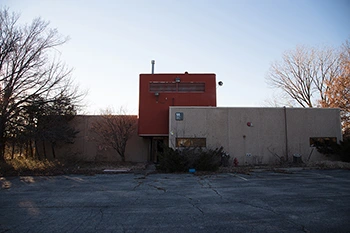
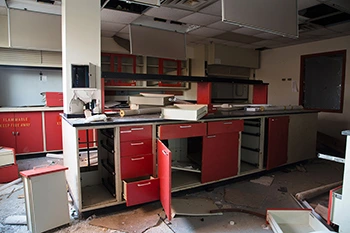 The Animal Testing Laboratory operated here for decades under various owners, all of whom were engaged in roughly the same line of work: They manufactured drugs and tested them on animals. The last of the serious work was conducted here in the early 2000's before the plant went under. A few years later a local businessman attempted to revive operations on this site but soon realized it was more difficult and more expensive than anticipated. It has been sitting vacant since.
The Animal Testing Laboratory operated here for decades under various owners, all of whom were engaged in roughly the same line of work: They manufactured drugs and tested them on animals. The last of the serious work was conducted here in the early 2000's before the plant went under. A few years later a local businessman attempted to revive operations on this site but soon realized it was more difficult and more expensive than anticipated. It has been sitting vacant since.
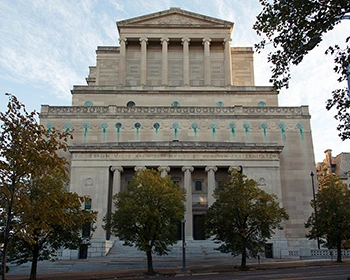
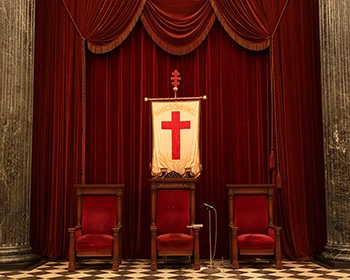 This Masonic Temple was constructed in the early 1900's. It was in service for almost 100 years before it was sold due to insufficient membership and the subsequent dues necessary to keep it active.
This Masonic Temple was constructed in the early 1900's. It was in service for almost 100 years before it was sold due to insufficient membership and the subsequent dues necessary to keep it active.
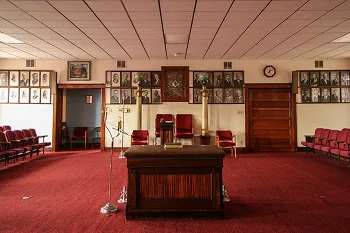
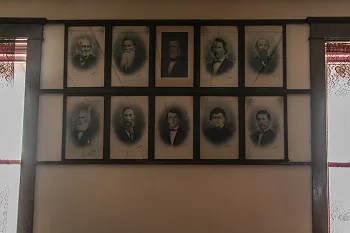 This Masonic Lodge was constructed in the early 1900s and remained in service for 100 years. It has since been demolished.
This Masonic Lodge was constructed in the early 1900s and remained in service for 100 years. It has since been demolished.
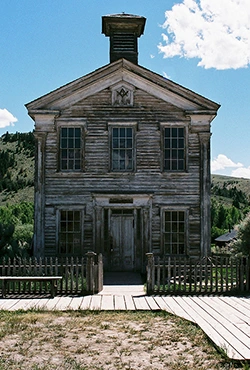
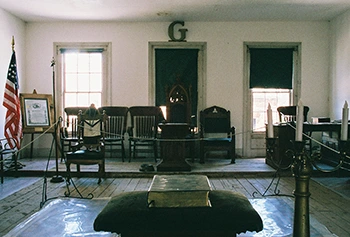 Bannack Lodge no. 16 was chartered on October 3rd, 1871. The building was constructed in 1874 and was active as a Masonic Lodge until October 21, 1921 when the charter was transferred to nearby Dillon.
Bannack Lodge no. 16 was chartered on October 3rd, 1871. The building was constructed in 1874 and was active as a Masonic Lodge until October 21, 1921 when the charter was transferred to nearby Dillon.
This Lodge was chartered in 1895 and the building was erected in 1900. It was home to the local Freemasons and members of the Order of the Eastern Star while local chapters of the Odd Fellows, among other fraternal groups, also frequently met here. At its prime there were over 120 active Masons who belonged to this Lodge. As the population of the town dwindled throughout the 20th century, so did the membership here. Eventually there was no-one left to manage it and the various Masonic decorations made their way to the small local history museum and the Lodge now sits quiet and empty.
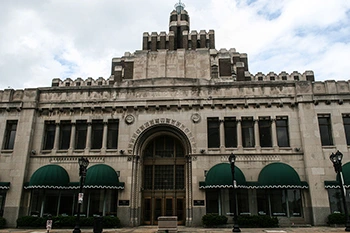
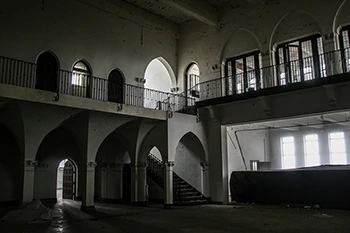 This building was erected in 1928 by the Knights of Pythias, a fraternal organization and secret society. It was designed to look like a castle and serve as their headquarters and meeting place, otherwise known as a Lodge. Following the decline in membership of such organizations, the building was sold to various local companies. The Castle (aka The Beaux Arts/aka Carter Carburetor/ACF Administration Building) has an indoor parking garage, which is partially in use, however the main upper portions of the building
This building was erected in 1928 by the Knights of Pythias, a fraternal organization and secret society. It was designed to look like a castle and serve as their headquarters and meeting place, otherwise known as a Lodge. Following the decline in membership of such organizations, the building was sold to various local companies. The Castle (aka The Beaux Arts/aka Carter Carburetor/ACF Administration Building) has an indoor parking garage, which is partially in use, however the main upper portions of the building
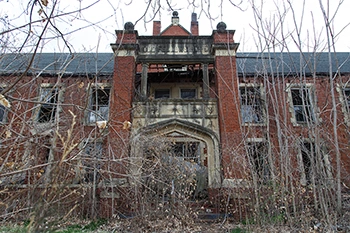
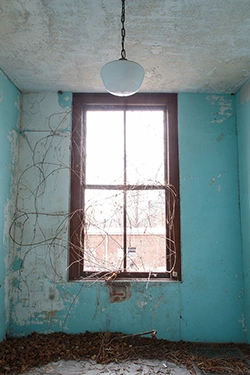 The Odd Fellows home was constructed by The Independent Order of Odd Fellows, a fraternal organization whose chief purpose is to give aid, assistance and comfort to its members and their families. The land on which this home was built was originally the site of an old Hotel. The Odd Fellows purchased the property in 1895 and ran their home from the original building until a fire in the year 1900 forced them to construct a new building. To fully support the mission of the home, the Odd Fellows at this time purchased all of the available surrounding farmland and it was through this expansion they were able to produce their own oats, corn, potatoes, hay, milk, butter and eggs. Among the livestock here were horses, cattle, poultry and hogs. The Odd Fellows home provided safe lodging primarily to orphaned children, but it also served older adults and others who were unable to support themselves until such time as they were able to do so. The home continued to serve the community for well over 80 years before finally closing down sometime in the 1980s.
The Odd Fellows home was constructed by The Independent Order of Odd Fellows, a fraternal organization whose chief purpose is to give aid, assistance and comfort to its members and their families. The land on which this home was built was originally the site of an old Hotel. The Odd Fellows purchased the property in 1895 and ran their home from the original building until a fire in the year 1900 forced them to construct a new building. To fully support the mission of the home, the Odd Fellows at this time purchased all of the available surrounding farmland and it was through this expansion they were able to produce their own oats, corn, potatoes, hay, milk, butter and eggs. Among the livestock here were horses, cattle, poultry and hogs. The Odd Fellows home provided safe lodging primarily to orphaned children, but it also served older adults and others who were unable to support themselves until such time as they were able to do so. The home continued to serve the community for well over 80 years before finally closing down sometime in the 1980s.
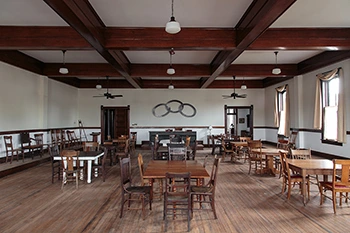
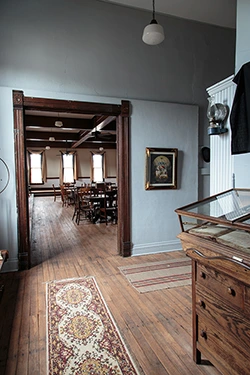 This lodge was chartered in 1854 and the building was erected for them in 1925.
This lodge was chartered in 1854 and the building was erected for them in 1925.
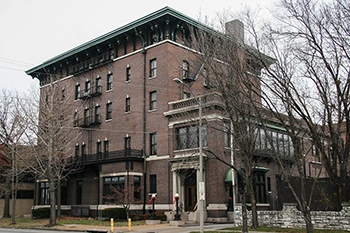
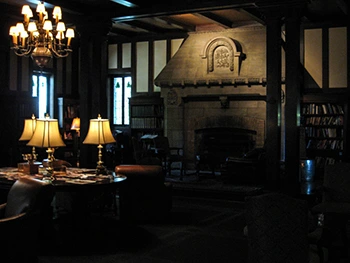 The club has been right here in this unassuming building for over a hundred years. There are no signs or any outside means of identification to give it away. It was built in the early 1900's and remains virtually unchanged to this day. This place represents a time when the automobile was still a rarity on the streets and businesses were locally owned. Well-connected business owners would form civic clubs under whose umbrella they would collectively make decisions regarding civic and social issues and just about everything else of interest to the area leaders of the time. But most business was conducted elsewhere, this club was primarily a social club, a place to make friends with your business associates (a subset of members were also active in a specific sport which otherwise lent some outward public legitimacy to its existence). The door is manned by a butler 24/7. Smoking is allowed and the bar is evidently always open (there is at least one bar on each floor that I accessed). If you need a room with absolute privacy for a night or several, this is the place. The nature of the club is such that it otherwise has literally no public presence. There's no website and no source of history on it readily available. In fact, this post right here is the largest collection of photographs and information pertaining to this establishment made available to the public, let alone on the internet, since it's inception as far as I can tell.
The club has been right here in this unassuming building for over a hundred years. There are no signs or any outside means of identification to give it away. It was built in the early 1900's and remains virtually unchanged to this day. This place represents a time when the automobile was still a rarity on the streets and businesses were locally owned. Well-connected business owners would form civic clubs under whose umbrella they would collectively make decisions regarding civic and social issues and just about everything else of interest to the area leaders of the time. But most business was conducted elsewhere, this club was primarily a social club, a place to make friends with your business associates (a subset of members were also active in a specific sport which otherwise lent some outward public legitimacy to its existence). The door is manned by a butler 24/7. Smoking is allowed and the bar is evidently always open (there is at least one bar on each floor that I accessed). If you need a room with absolute privacy for a night or several, this is the place. The nature of the club is such that it otherwise has literally no public presence. There's no website and no source of history on it readily available. In fact, this post right here is the largest collection of photographs and information pertaining to this establishment made available to the public, let alone on the internet, since it's inception as far as I can tell.
A history of Bethlehem Lutheran Church would be incomplete without giving some background of the circumstances which led to its founding as a congregation and its affiliation with what is now known as the Lutheran Church of the Missouri Synod.
Two significant evens which led to the founding of Lutheran Church and "Missouri Synod" Lutheranism in Saint Louis and Saint Louis County were 1) the decision of a group of Germans from Saxony to emigrate to America and 2) the mass migraion of...
This church's congregation was formed in the 1870's. It wasn't until the month of July in the 1890's before they would have their own "magnificent" church erected here. Unfortunately, their beautiful church burned to the ground less than 5 years later. The congregation would not be deterred, however and set out to rebuild with even loftier goals for the replacement.
Ground was broken for the Methodist church on June 26th, 1901 and the cornerstone was laid on October 17th of that year. The first service was held on October 5th 1902. During the mid 1940's-50's, the main sanctuary was completely remodeled to feature hand carved walnut, marble floor, new stained glass windows and the impressive 55 Rank Moller organ. The unusual monochrome stained glass windows were added in the 1960's.
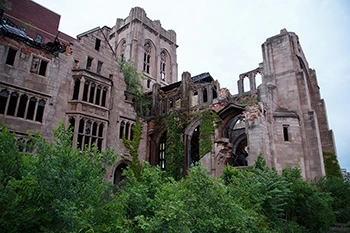
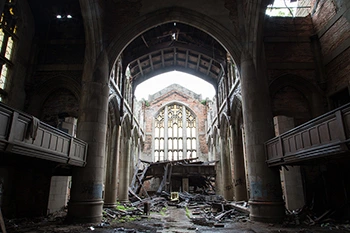 City Methodist Church In Gary Indiana was completed in 1927 at the cost of one million dollars. Elbert Gary, the namesake of Gary Indiana and the chairman of US Steel Corporation, donated $325,000 to help pay for the construction. But costs quickly exceeded their projections and due to these overruns, certain changes were made to save money. Most notably, the stained glass windows were not completed in stained glass towards the bottom of the windows. The enormous size of the building was also a problem early on. The columns in the sanctuary started out very large on one end but were reduced in size towards the balcony because a measurement error meant the plot of land was smaller than expected and the chapel as originally planned simply wouldn't fit. When completed, the church included a gymnasium on the top floor with a full size basketball court and the main sanctuary which seats 950 people as well as a wing containing "Seaman Hall", an auditorium capable of seating 997 people, along with numerous church school rooms and even store fronts on the ground floor which, it was hoped, would help offset the construction costs. In its prime, the church counted 3,000 people in its congregation. But City Methodist, like so many other institutions in so many other cities, suffered a crippling exodus of its contributing members in the 1960s as city inhabitants moved out to the suburbs. In October of 1974, a meeting was held to determine the fate of the church. On January 3rd, 1975, City Methodist Church closed its doors. It has been vacant ever since.
City Methodist Church In Gary Indiana was completed in 1927 at the cost of one million dollars. Elbert Gary, the namesake of Gary Indiana and the chairman of US Steel Corporation, donated $325,000 to help pay for the construction. But costs quickly exceeded their projections and due to these overruns, certain changes were made to save money. Most notably, the stained glass windows were not completed in stained glass towards the bottom of the windows. The enormous size of the building was also a problem early on. The columns in the sanctuary started out very large on one end but were reduced in size towards the balcony because a measurement error meant the plot of land was smaller than expected and the chapel as originally planned simply wouldn't fit. When completed, the church included a gymnasium on the top floor with a full size basketball court and the main sanctuary which seats 950 people as well as a wing containing "Seaman Hall", an auditorium capable of seating 997 people, along with numerous church school rooms and even store fronts on the ground floor which, it was hoped, would help offset the construction costs. In its prime, the church counted 3,000 people in its congregation. But City Methodist, like so many other institutions in so many other cities, suffered a crippling exodus of its contributing members in the 1960s as city inhabitants moved out to the suburbs. In October of 1974, a meeting was held to determine the fate of the church. On January 3rd, 1975, City Methodist Church closed its doors. It has been vacant ever since.
The historic Unitarian Church in Keokuk Iowa was dedicated on Dec. 2, 1874 and is the oldest standing church in the city. Unitarian Churches were known for their use of logic and reason rather than blind faith in their interpretations of the Bible and this attracted many freethinkers of the time. Among the prominent early church members was a physician and lawyer named Samuel Freeman Miller. Miller, an optimist and progressive rationalist, helped found Keokuk's First Unitarian Church in 1853 and personally drafted its articles of incorporation. Shortly thereafter his business partner, Lewis Reeves, died after contracting Asiatic Cholera. Just a few months later, Samuel Miller's wife Lucy died of "consumption" which is what we now know as Tuberculosis. This series of tragedies left him a single father of 3 daughters in addition to now being the sole proprietor of his law practice. His mastery of Law earned the attention of the top courts in the nation and as a result he was later appointed to the United States Supreme Court just after the start of the American Civil War in 1862 by Abraham Lincoln. He served in that role for 28 years, becoming one of the most influential Justices to serve in that capacity until his death in 1890 following which his funeral service was held in this church.
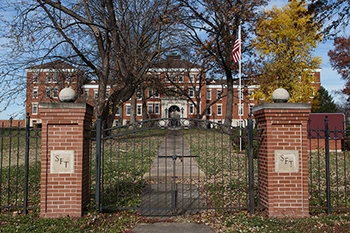
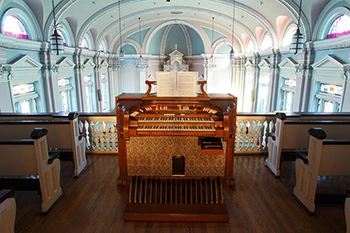 Saint Mary's Female Orphan Asylum was constructed in Saint Louis in the early 1900's. It housed 250 orphans and homeless children ranging from 4 to 14 years old and provided them with a standard education along with music and household skills such as sewing and cooking. The children were given up for adoption whenever suitable homes were provided or when relatives were able to step forward. When children remained beyond the age of 14, they were transferred to another charity's industrial school where they learned trades. The Orphanage closed in the 1950's and has been in the hands of various charitable institutions ever since. It was vacant and for sale for several years until sometime after this visit took place when it became inhabited by new owners.
Saint Mary's Female Orphan Asylum was constructed in Saint Louis in the early 1900's. It housed 250 orphans and homeless children ranging from 4 to 14 years old and provided them with a standard education along with music and household skills such as sewing and cooking. The children were given up for adoption whenever suitable homes were provided or when relatives were able to step forward. When children remained beyond the age of 14, they were transferred to another charity's industrial school where they learned trades. The Orphanage closed in the 1950's and has been in the hands of various charitable institutions ever since. It was vacant and for sale for several years until sometime after this visit took place when it became inhabited by new owners.
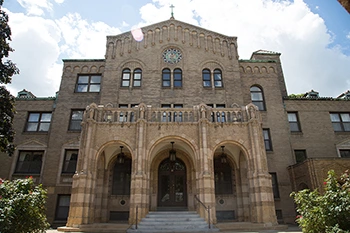
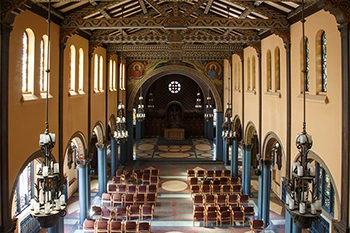 Saint Mary of the Angels Convent was constructed in the 1920's and was home to a small number of comparatively ripened nuns until its closure about 10 years ago. I tried finding interesting historic dates or events to mention but I think the most interesting thing that ever happened here was probably the psychedelic paint scheme used in the chapel.
Saint Mary of the Angels Convent was constructed in the 1920's and was home to a small number of comparatively ripened nuns until its closure about 10 years ago. I tried finding interesting historic dates or events to mention but I think the most interesting thing that ever happened here was probably the psychedelic paint scheme used in the chapel.
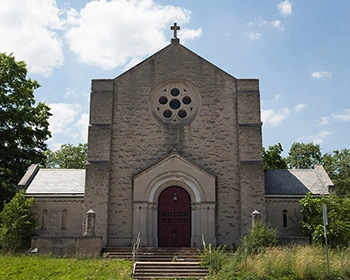
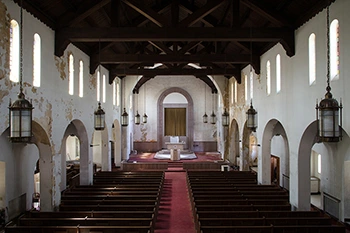 Church #12 was constructed at the turn of the 20th Century and six years later they erected a school building here. It remained in service to the original denomination for exactly 90 years before it was sold in the 1990s and abandoned sometime fairly recently.
Church #12 was constructed at the turn of the 20th Century and six years later they erected a school building here. It remained in service to the original denomination for exactly 90 years before it was sold in the 1990s and abandoned sometime fairly recently.

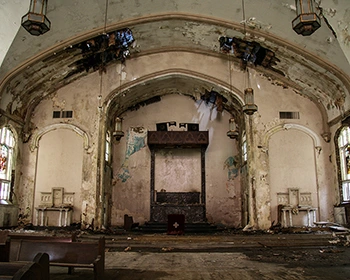 Catholic Church was founded in 1907. The building was completed in 1915. A school, convent and rectory were added within a few years. In the 1970's, facing diminsehd enrollment, Catholic Church merged its school with a variety of other local catholic schools. Ultimately, however, after almost 100 years of service, this parish was to close its doors in 2001 and merge congregations with another local church.
Catholic Church was founded in 1907. The building was completed in 1915. A school, convent and rectory were added within a few years. In the 1970's, facing diminsehd enrollment, Catholic Church merged its school with a variety of other local catholic schools. Ultimately, however, after almost 100 years of service, this parish was to close its doors in 2001 and merge congregations with another local church.
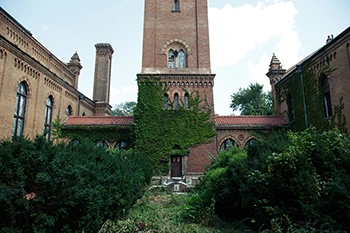
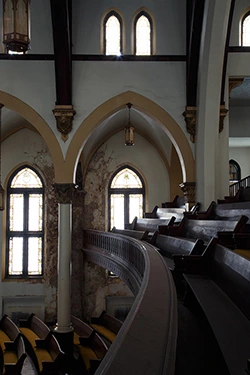 In the Fall of 1817, John M. Peck and James E. Welch arrived in the village of St. Louis to perform missionary work. At this time, Saint Louis was a town of roughly 3,000 inhabitants. These men performed a dilligent search and turned up a total of seven other Baptists in the entire city. They joined together in the acquisition of a small room on Main Street south of Market for the first meeting place of Saint Louis Baptists. The First Baptist Church was formed on February 18th, 1818, three years before Missouri was admitted as the 24th state of the Union. Their first official church building was
In the Fall of 1817, John M. Peck and James E. Welch arrived in the village of St. Louis to perform missionary work. At this time, Saint Louis was a town of roughly 3,000 inhabitants. These men performed a dilligent search and turned up a total of seven other Baptists in the entire city. They joined together in the acquisition of a small room on Main Street south of Market for the first meeting place of Saint Louis Baptists. The First Baptist Church was formed on February 18th, 1818, three years before Missouri was admitted as the 24th state of the Union. Their first official church building was
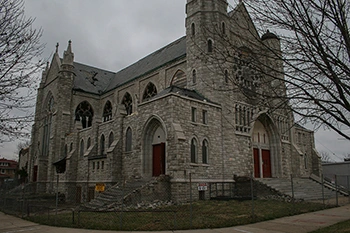
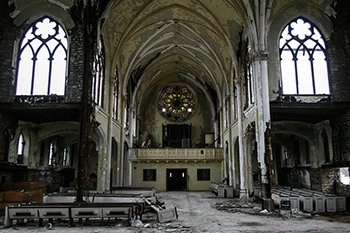 Holy Name Catholic Church was one of the founding churches of the Southeast portion of Kansas City during its second major reisdential expansion. It was also one of the largest built in the Kansas City area. The location selected for Holy Name was a major hill in one of the highest growth areas on the edge of the expanding city. This church was plagued from the beginning, however, with continuous financial difficulties. The basement was completed in 1911, but the financial problems halted construction...
Holy Name Catholic Church was one of the founding churches of the Southeast portion of Kansas City during its second major reisdential expansion. It was also one of the largest built in the Kansas City area. The location selected for Holy Name was a major hill in one of the highest growth areas on the edge of the expanding city. This church was plagued from the beginning, however, with continuous financial difficulties. The basement was completed in 1911, but the financial problems halted construction...
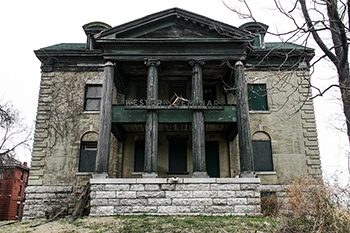
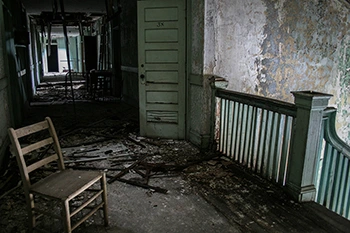 The building known today as the Western Seminary was constructed in approximately 1909 from funds ($25,000) donated by Mrs. Margaret Clock Armour, widow of Simeon Brooks Armour of the famous Armour Meat Packing Company. The building was originally christened "The Margaret Klock Armour Memorial Home for Aged Men and Women" and was operated by the Women's Christian Association of Kansas City who constructed the Gillis Orphan's home on the same tract of land. A bronze tablet was hung in the entryway during the home's dedication by Mrs. Armour which read "At evening time, it shall be light". The land on which it was built had been donated by "Colonel" Thomas H. Swope, whose death had become a highly publicized murder trial. Swope was a wealthy real estate magnate and philanthropist and was the largest indiviual landowner in Kansas City. His physician, Dr. Hyde, was believed to have poisoned him with strychnine in an attempt to inherit some of his vast wealth (Dr. Hyde was married to one of Swope's neices). The Armour Memorial Home, along with the Orphan's Home, were receiving widespread support in the community due to the positive social impact these facilities were making. As a result of their success, these buildings were filled to capacity by the mid 1920's and they had a waiting list of more than 100. At about this time, the Western Negro College offered $25,000 to purchase the property. This sum was sufficient for the homes to relocate to a comfortable 26.5 acres, a site in which they still inhabit today. The Western Negro College had formed in the late 1880's and had moved between a variety of locations before finally purchasing this land in 1926 from the WCA. The College was forced to close its doors in the height of the depression for the school years of 1935-1936, after which time it was reorganized and renamed in 1937 as the Western Seminary. Eventually, the College would operate solely out of the old Orphan's home thus abandoning the old Memorial Home which still bears their name.
The building known today as the Western Seminary was constructed in approximately 1909 from funds ($25,000) donated by Mrs. Margaret Clock Armour, widow of Simeon Brooks Armour of the famous Armour Meat Packing Company. The building was originally christened "The Margaret Klock Armour Memorial Home for Aged Men and Women" and was operated by the Women's Christian Association of Kansas City who constructed the Gillis Orphan's home on the same tract of land. A bronze tablet was hung in the entryway during the home's dedication by Mrs. Armour which read "At evening time, it shall be light". The land on which it was built had been donated by "Colonel" Thomas H. Swope, whose death had become a highly publicized murder trial. Swope was a wealthy real estate magnate and philanthropist and was the largest indiviual landowner in Kansas City. His physician, Dr. Hyde, was believed to have poisoned him with strychnine in an attempt to inherit some of his vast wealth (Dr. Hyde was married to one of Swope's neices). The Armour Memorial Home, along with the Orphan's Home, were receiving widespread support in the community due to the positive social impact these facilities were making. As a result of their success, these buildings were filled to capacity by the mid 1920's and they had a waiting list of more than 100. At about this time, the Western Negro College offered $25,000 to purchase the property. This sum was sufficient for the homes to relocate to a comfortable 26.5 acres, a site in which they still inhabit today. The Western Negro College had formed in the late 1880's and had moved between a variety of locations before finally purchasing this land in 1926 from the WCA. The College was forced to close its doors in the height of the depression for the school years of 1935-1936, after which time it was reorganized and renamed in 1937 as the Western Seminary. Eventually, the College would operate solely out of the old Orphan's home thus abandoning the old Memorial Home which still bears their name.
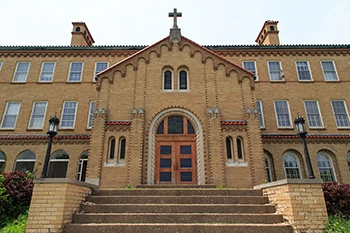
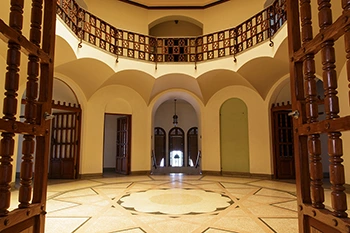 The convent was built in the 1930s and at its peak there were 90 nuns living here simultaneously. It closed recently and is currently for sale.
The convent was built in the 1930s and at its peak there were 90 nuns living here simultaneously. It closed recently and is currently for sale.
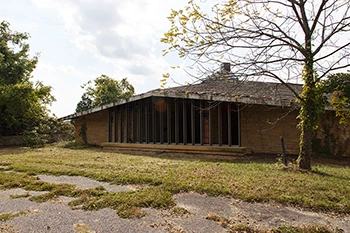
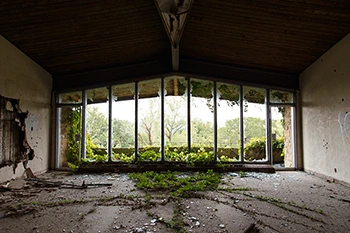 The monastery known as St Pius X Benedictine Abbey was formed in 1951 by the Swiss-American Congregation of the Benedictine Confederation. This location was begun as a foundation which sprouted from its parent monastery, the Conception Abbey. The latest record of activity I can locate here is dated 1982.There are two separate buildings here, both of which are in very poor condition. From what I can gather, the first building pictured is the actual Abbey itself and the second building with the huge fireplace is the residence. The Abbey appears to have suffered a fire at some point long ago and has sat exposed to the elements ever since. All of the rooms have been gutted and the walls are smashed through nearly everywhere. The residence hasn't fared much better. All of this sits on an active golf course and the path which the carts take is literally right outside the front doors.
The monastery known as St Pius X Benedictine Abbey was formed in 1951 by the Swiss-American Congregation of the Benedictine Confederation. This location was begun as a foundation which sprouted from its parent monastery, the Conception Abbey. The latest record of activity I can locate here is dated 1982.There are two separate buildings here, both of which are in very poor condition. From what I can gather, the first building pictured is the actual Abbey itself and the second building with the huge fireplace is the residence. The Abbey appears to have suffered a fire at some point long ago and has sat exposed to the elements ever since. All of the rooms have been gutted and the walls are smashed through nearly everywhere. The residence hasn't fared much better. All of this sits on an active golf course and the path which the carts take is literally right outside the front doors.
Saint Augustine Church in Saint Louis, Missouri, was constructed in the 1890s. It's so tall, the church even had room for a double-decker choir loft. It was used for nearly 100 years before being sold to smaller local congregations. The last of these congregations constructed an exceedingly crappy drywall room inside the sanctuary and thus robbed visitors of one of the most magnificent church interiors I've ever seen. They left sometime within the past couple of years.

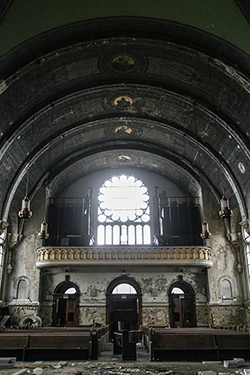 St. Laurence Catholic Church was built in 1911. The cornerstone was laid on June 11, 1911 and it opened for service on December 26th, 1911. The archdiocese closed the church in 1999, citing 3 million dollars needed in repairs. St. Laurence was demolished in the summer of 2014.
St. Laurence Catholic Church was built in 1911. The cornerstone was laid on June 11, 1911 and it opened for service on December 26th, 1911. The archdiocese closed the church in 1999, citing 3 million dollars needed in repairs. St. Laurence was demolished in the summer of 2014.
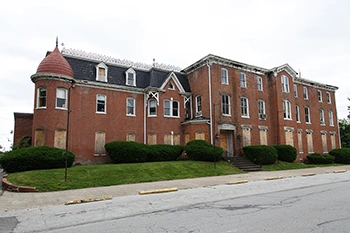
 Kemper Military School was founded by Frederick T Kemper as "The Kemper Family School" and the first class took place on June 3, 1844. At the time it was just a one-room schoolhouse and there were only 5 students enrolled. But by the fall of the same year, enrollment had expanded tenfold. Its popularity increased over the years and it expanded to meet the demand, eventually moving out of the original location to the buildings it would inhabit for all of its subsequent years. By the 1860's, the school was large enough that it was able to remain open during the Civil War, one of few to do so. Graduates of Kemper actually fought on both sides of the Civil War and many even participated in a local battle near the school.
Kemper Military School was founded by Frederick T Kemper as "The Kemper Family School" and the first class took place on June 3, 1844. At the time it was just a one-room schoolhouse and there were only 5 students enrolled. But by the fall of the same year, enrollment had expanded tenfold. Its popularity increased over the years and it expanded to meet the demand, eventually moving out of the original location to the buildings it would inhabit for all of its subsequent years. By the 1860's, the school was large enough that it was able to remain open during the Civil War, one of few to do so. Graduates of Kemper actually fought on both sides of the Civil War and many even participated in a local battle near the school.
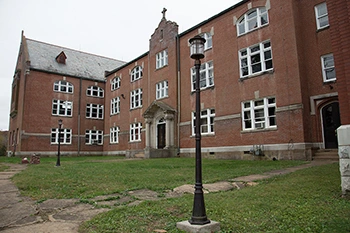
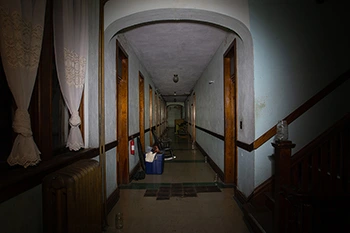 The Catholic Boarding School was constructed in the 1840s as a Methodist High School. During the civil war, it served as a Union hospital. In the 1870s, it was purchased by a group of nuns who transformed it into the boarding school in which capacity it served until the 1970s after which it was a convent before finally being abandoned. The property was eventually sold to its current ownership who transformed it into a bed and breakfast. I stayed here for a weekend recently. The portions of the property that are now part of the bed and breakfast are entirely renovated to such an extent that they are cleaner and more comfortable than most places I've ever stayed and I highly recommend getting a room here. I met the owner who took us on a tour and who agreed to let me photograph the place. She even fired up the pipe organ in the chapel and let me play it -which is something I've ALWAYS wanted to do. It was fucking awesome. This place is cool as hell and, thankfully, so is the owner.
The Catholic Boarding School was constructed in the 1840s as a Methodist High School. During the civil war, it served as a Union hospital. In the 1870s, it was purchased by a group of nuns who transformed it into the boarding school in which capacity it served until the 1970s after which it was a convent before finally being abandoned. The property was eventually sold to its current ownership who transformed it into a bed and breakfast. I stayed here for a weekend recently. The portions of the property that are now part of the bed and breakfast are entirely renovated to such an extent that they are cleaner and more comfortable than most places I've ever stayed and I highly recommend getting a room here. I met the owner who took us on a tour and who agreed to let me photograph the place. She even fired up the pipe organ in the chapel and let me play it -which is something I've ALWAYS wanted to do. It was fucking awesome. This place is cool as hell and, thankfully, so is the owner.
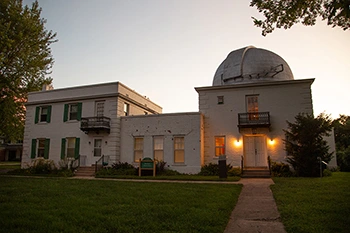
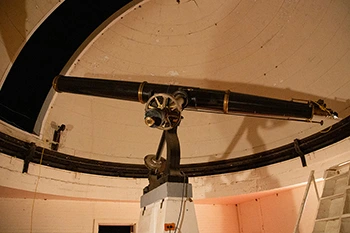 The Morrison Observatory was originaly constructed in 1875 by Pritchett College, a small local institution in Glasgow, Missouri. It was named after the benefactor Bernice Morrison who, in 1874, pledged $100,000 to build a world-class observatory at the college. Within a year, the college delivered on her stated goals. The observatory was outfitted with the best instruments available at the time which consisted of a beautifully crafted 12.25" Clark Refracting Telescope housed beneath a hand-cranked rotating dome that was modeled after the one found at Harvard's Observatory. Clark Telescopes, made by the legendary Alvan Clark company were the centerpieces of all of the top observatories of the day such as Harvard, Lowell, and Yerkes. One year later, in 1876, a 6" Meridian Telescope, built by Troughton & Sims was installed in a separate part of the building. With this addition, the observatory was able to generate income by selling the accurate time to local railroads and other institutions throughout Missouri. The Meridian Telescope is a large single axis transit telescope whose primary function was "to accurately mark the position of a star as it crossed the zenith at the observatory's 39 Degrees North Latitude". There was a lounge chair built for the comfort of the observer who would send a telegraph to the railway signalling devices to accurately mark the time. The position of the telescope was accurately determined through the use of large dials on the side whose marks were illuminated by a complex series of glass prisms which directed the light from attached lamps. There is also a closet directly behind the telescope which was built to house the clock on which the time was locally recorded. This clock was built by notable horologist Charles Frodsham, clockmaker to the Queen of England, who started the Charles Frodsham & Co in London, which "remains in existence as the longest continuously trading firm of chronometer manufacturers in the world". Notable among the oservations made at the Morrison Observatory is that of Jupiter's Great Red Spot which was documented by Dr. Henry Pritchett in 1878. By 1907, however, the Morrison Observatory was no longer in use.
The Morrison Observatory was originaly constructed in 1875 by Pritchett College, a small local institution in Glasgow, Missouri. It was named after the benefactor Bernice Morrison who, in 1874, pledged $100,000 to build a world-class observatory at the college. Within a year, the college delivered on her stated goals. The observatory was outfitted with the best instruments available at the time which consisted of a beautifully crafted 12.25" Clark Refracting Telescope housed beneath a hand-cranked rotating dome that was modeled after the one found at Harvard's Observatory. Clark Telescopes, made by the legendary Alvan Clark company were the centerpieces of all of the top observatories of the day such as Harvard, Lowell, and Yerkes. One year later, in 1876, a 6" Meridian Telescope, built by Troughton & Sims was installed in a separate part of the building. With this addition, the observatory was able to generate income by selling the accurate time to local railroads and other institutions throughout Missouri. The Meridian Telescope is a large single axis transit telescope whose primary function was "to accurately mark the position of a star as it crossed the zenith at the observatory's 39 Degrees North Latitude". There was a lounge chair built for the comfort of the observer who would send a telegraph to the railway signalling devices to accurately mark the time. The position of the telescope was accurately determined through the use of large dials on the side whose marks were illuminated by a complex series of glass prisms which directed the light from attached lamps. There is also a closet directly behind the telescope which was built to house the clock on which the time was locally recorded. This clock was built by notable horologist Charles Frodsham, clockmaker to the Queen of England, who started the Charles Frodsham & Co in London, which "remains in existence as the longest continuously trading firm of chronometer manufacturers in the world". Notable among the oservations made at the Morrison Observatory is that of Jupiter's Great Red Spot which was documented by Dr. Henry Pritchett in 1878. By 1907, however, the Morrison Observatory was no longer in use.

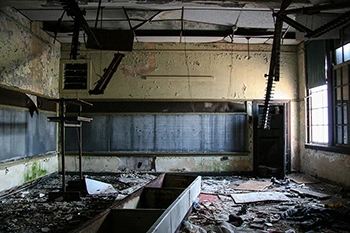 Carr Elementary School in Saint Louis was built in 1908 by renowned architect William B. Ittner. The school closed in 1983 and has been abandoned ever since.
Carr Elementary School in Saint Louis was built in 1908 by renowned architect William B. Ittner. The school closed in 1983 and has been abandoned ever since.
St. Mark's School was constructed in 1909 and features Gothic Revival architecture. This all-girl's school opened on September 15, 1909 with 180 pupils. In 1910, the Sister-Teachers formed a High School department due to the lack of available all-girl high-schools in the area, forming St. Mark's Academy. The education was highly regarded and students came from as far as St. Ann and Glasgow Village, Missouri to attend school here. St. Mark's was always funded solely by the members of its congregation or through the cost of tuition. But their numbers began to decline throughout the 1960s as more people moved out of the city and fewer women chose religious vocations as nuns. Ultimately, it closed its doors in 1975 due to lack of funding.
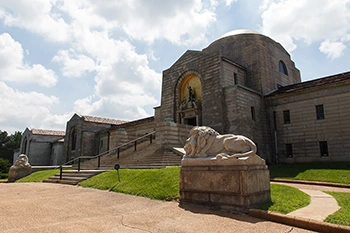
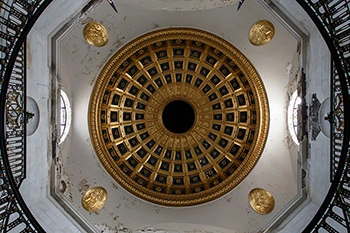 Oak Grove Mausoleum was initially constructed in 1928 and was designed by architects Tom P Barnett and Sidney Lovell. The Mausoleum is a magnificent Byzantine Style domed building which is nearly 1/8th of a mile long and contains over 6,000 crypts and burial vaults. Its grand marbled dome was lavishly decorated by 22k gold leaf and was modeled after the Pantheon in Paris. There are several rare and unique sculptures and stained glass furnishings inside not to mention some of the worlds finest marble. Notable among these are the Tiffany and Co. Stained glass window titled "The Ascension of our Lord" which was custom designed for the Episcopal Church of the Ascension in Saint Louis. The window was rescued just prior to the church's demolition in 1968. In fact, the south wing of the building is said to have been constructed to accommodate this huge 15x24' window. Additionally, the Mausoleum houses one of the original copies of the Gloria Victis, a sculpture created in 1874 by Antonin Mercié. "Mercié designed this sculpture following France's defeat in the Franco-Prussian War. He intended to honor those French soldiers who had fallen in the conflict, especially his friend, the artist Henri Regnault (1843-1871)". Among those buried here are Henry Kiel, who was mayor from 1913-1925 and whom the Kiel Auditorium was named after.
Oak Grove Mausoleum was initially constructed in 1928 and was designed by architects Tom P Barnett and Sidney Lovell. The Mausoleum is a magnificent Byzantine Style domed building which is nearly 1/8th of a mile long and contains over 6,000 crypts and burial vaults. Its grand marbled dome was lavishly decorated by 22k gold leaf and was modeled after the Pantheon in Paris. There are several rare and unique sculptures and stained glass furnishings inside not to mention some of the worlds finest marble. Notable among these are the Tiffany and Co. Stained glass window titled "The Ascension of our Lord" which was custom designed for the Episcopal Church of the Ascension in Saint Louis. The window was rescued just prior to the church's demolition in 1968. In fact, the south wing of the building is said to have been constructed to accommodate this huge 15x24' window. Additionally, the Mausoleum houses one of the original copies of the Gloria Victis, a sculpture created in 1874 by Antonin Mercié. "Mercié designed this sculpture following France's defeat in the Franco-Prussian War. He intended to honor those French soldiers who had fallen in the conflict, especially his friend, the artist Henri Regnault (1843-1871)". Among those buried here are Henry Kiel, who was mayor from 1913-1925 and whom the Kiel Auditorium was named after.
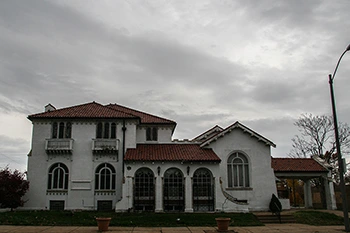
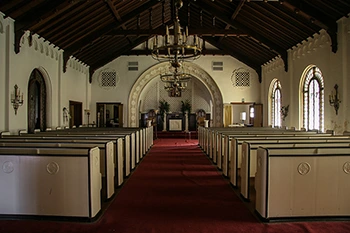 The Southern Funeral Home was built in the late 1920's and was the first purpose built funeral home in the city of Saint Louis. It closed sometime around 2010.
The Southern Funeral Home was built in the late 1920's and was the first purpose built funeral home in the city of Saint Louis. It closed sometime around 2010.
NSFW!! NSFL!!
Memorial Mound in Bessemer Alabama closed in 2002 and left some of its residents behind. According to al.com "The Alabama Department of Public Health has no authority over burial sites." The authorities knew about the situation here but nothing was done about it until photos of a corpse showed up on the internet.
NOTE: They have since removed the remains.

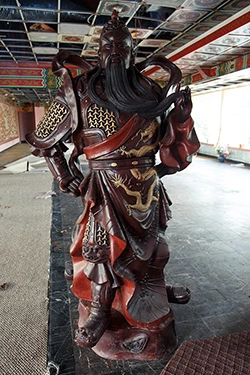 In the mid 1980s, David was running a successful chain of Chinese restaurants in Saint Louis. But only a decade prior, he was forced to flee his home in Vietnam after the Communist Takeover in the spring of 1975 under threat of his life. In Vietnam, David was a well-known business owner who ran several hotels and restaurants until the Communists threatened to kill him for doing business with Americans. The US troop withdraw signaled that it was time for him to take his family and head to the United States. But this would not be easy. First they had to get out of the country. They were forced into hiding just outside the city for nearly a week until they found a fisherman willing to sell his boat.. for 20 ounces of gold. The plan was to head out to the ocean and hope to be spotted by a US boat in time. After floating aimlessly for 6 days at sea, they were discovered by a US ship and were towed to nearby Malaysia, from where they eventually made their way to the United States. David and his family arrived in Saint Louis in late 1976. Encouraged by a friend who declared St. Louis an easy place to start a business, he quickly discovered that Chinese food was popular here and soon got a loan to open his first restaurant in the US in 1977. In only 2 years, he managed to open another 4 restaurants and by the 1980s had opened at least 16 restaurants. David was passionate about his work and regularly put in 14 hour days with frequent trips to China in an effort to learn new recipes in order to keep up the quality and authenticity.
In the mid 1980s, David was running a successful chain of Chinese restaurants in Saint Louis. But only a decade prior, he was forced to flee his home in Vietnam after the Communist Takeover in the spring of 1975 under threat of his life. In Vietnam, David was a well-known business owner who ran several hotels and restaurants until the Communists threatened to kill him for doing business with Americans. The US troop withdraw signaled that it was time for him to take his family and head to the United States. But this would not be easy. First they had to get out of the country. They were forced into hiding just outside the city for nearly a week until they found a fisherman willing to sell his boat.. for 20 ounces of gold. The plan was to head out to the ocean and hope to be spotted by a US boat in time. After floating aimlessly for 6 days at sea, they were discovered by a US ship and were towed to nearby Malaysia, from where they eventually made their way to the United States. David and his family arrived in Saint Louis in late 1976. Encouraged by a friend who declared St. Louis an easy place to start a business, he quickly discovered that Chinese food was popular here and soon got a loan to open his first restaurant in the US in 1977. In only 2 years, he managed to open another 4 restaurants and by the 1980s had opened at least 16 restaurants. David was passionate about his work and regularly put in 14 hour days with frequent trips to China in an effort to learn new recipes in order to keep up the quality and authenticity.
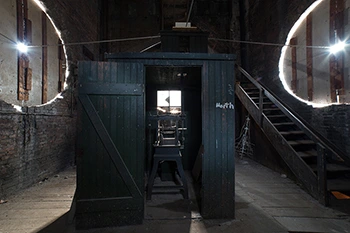
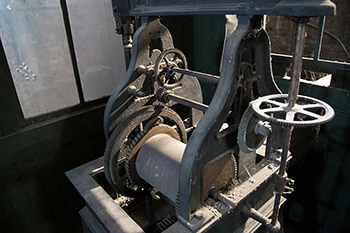 The Clocktower was constructed in the 1890's. It proudly stands watch 230 feet above downtown Saint Louis. Facing out in all 4 directions, its hands have steadfastly toiled away at their work for almost 130 years now-illuminating every moment of our miserable existence and ensuring that the unending march of time continues to progress forward in a clockwise fashion. Unfortunately, the clocktower appears to finally be sealed up now and this may be the last time I would ever get to enjoy the views. But who knows. Maybe in another decade after the current owners abandon it, the great cycle will repeat itself with Saint Louis falling back into disrepair, becoming the filming location for another Escape From New York movie in which this building once again enjoys a starring role. It already happened once before and, well, we survived 2020. Anything is possible at this point.
The Clocktower was constructed in the 1890's. It proudly stands watch 230 feet above downtown Saint Louis. Facing out in all 4 directions, its hands have steadfastly toiled away at their work for almost 130 years now-illuminating every moment of our miserable existence and ensuring that the unending march of time continues to progress forward in a clockwise fashion. Unfortunately, the clocktower appears to finally be sealed up now and this may be the last time I would ever get to enjoy the views. But who knows. Maybe in another decade after the current owners abandon it, the great cycle will repeat itself with Saint Louis falling back into disrepair, becoming the filming location for another Escape From New York movie in which this building once again enjoys a starring role. It already happened once before and, well, we survived 2020. Anything is possible at this point.
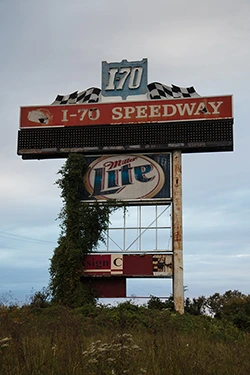
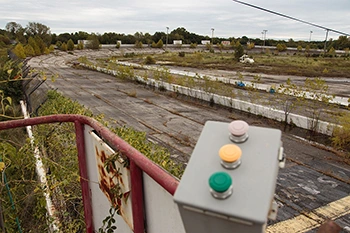 I-70 Speedway was a legendary paved oval race track which remained open consistently through the glory days of racing, spanning the decades from 1969 until its demise in 2008. I-70 hosted various types of races from Stock Car racing to NASCAR truck and Kart racing as well as monster truck events. At one point the main oval was changed to dirt then back to paved. In 2006 a permanent 3/8 mile dirt track was added at the back of the property and often races were held on both tracks on the same night. Known for its steep 28 degree banks, the venerable 5/8 mile racetrack was loved by both racing enthusiasts and the drivers who raced there. Some notable I-70 alumni include racing legends Rusty Wallace and Clint Bowyer among others. It was regarded as a tough white-knuckle racetrack which often sent drivers careening over the walls in a mangled wreck of metal and fire. It was as unforgiving as it was glorious.
I-70 Speedway was a legendary paved oval race track which remained open consistently through the glory days of racing, spanning the decades from 1969 until its demise in 2008. I-70 hosted various types of races from Stock Car racing to NASCAR truck and Kart racing as well as monster truck events. At one point the main oval was changed to dirt then back to paved. In 2006 a permanent 3/8 mile dirt track was added at the back of the property and often races were held on both tracks on the same night. Known for its steep 28 degree banks, the venerable 5/8 mile racetrack was loved by both racing enthusiasts and the drivers who raced there. Some notable I-70 alumni include racing legends Rusty Wallace and Clint Bowyer among others. It was regarded as a tough white-knuckle racetrack which often sent drivers careening over the walls in a mangled wreck of metal and fire. It was as unforgiving as it was glorious.
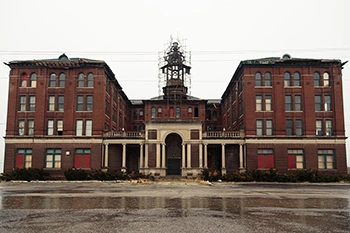
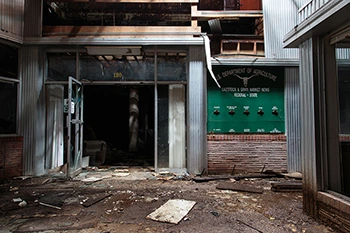 The Livestock Exchange Building was constructed in 1898, dedicated on June 9, 1899, and was a central hub for the local livestock, meatpacking and railroad industries in St Joseph Missouri for most of the last 100 years. The building provided offices for a variety of operations with a common interest; The first floor included the Stockyards offices as well as a bank, post office and even a cigar stand. In addition, the USDA, Western Union Telegraph Company and countless railroad companies, livestock commissions and packing companies had offices located here. It continued to serve in this capacity until roughly 2008. This building was directly involved in the prosperity of St Joseph in the early 20th century as it was the center of the livestock industries which were among the most important in the United States at the time.
The Livestock Exchange Building was constructed in 1898, dedicated on June 9, 1899, and was a central hub for the local livestock, meatpacking and railroad industries in St Joseph Missouri for most of the last 100 years. The building provided offices for a variety of operations with a common interest; The first floor included the Stockyards offices as well as a bank, post office and even a cigar stand. In addition, the USDA, Western Union Telegraph Company and countless railroad companies, livestock commissions and packing companies had offices located here. It continued to serve in this capacity until roughly 2008. This building was directly involved in the prosperity of St Joseph in the early 20th century as it was the center of the livestock industries which were among the most important in the United States at the time.
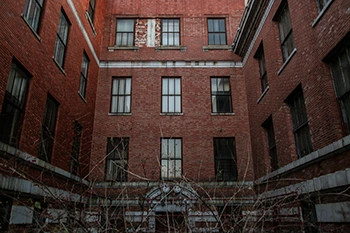
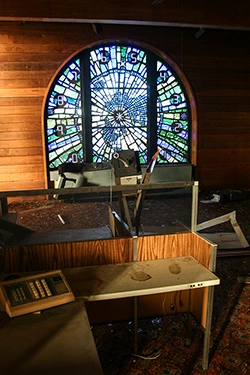 The Beaumont Telephone Exchange was constructed in 1902 as a branch office and exchange for the Bell Telephone Company. This building represents one of few remaining examples of the period of rapid growth in the telephone industry in the early 1900's.
The Beaumont Telephone Exchange was constructed in 1902 as a branch office and exchange for the Bell Telephone Company. This building represents one of few remaining examples of the period of rapid growth in the telephone industry in the early 1900's.
In November of 1877, Alexander Graham Bell's American Telephone and Telegraph company granted a license to expand service to Saint Louis. Early on, George Durant, the general manager of ADT (the American District Telegraph Company), leased equipment for private lines. Eventually it was decided that a central switchboard would be more efficient. Thus having started with twelve subscribers in 1878, this would be the first exchange in what would later be known as the Southwestern Bell Telephone Company. By 1880, this new company had 600 subscribers. Soon they outgrew their offices and moved from 417 Olive to 902 Olive and finally, in 1902, to their present location, where it was said to be "one of the best equipped of modern exchanges".
Over the years, as advances in technology were made, additions were made to the building which directly reflect the exchange adapting to meet them. This building served the telephone services industry throughout its entire career up until the mid 1990's. It was used for a few years as a training center, but eventually the equipment must have simply become too obsolete for even that role. It has been vacant ever since.
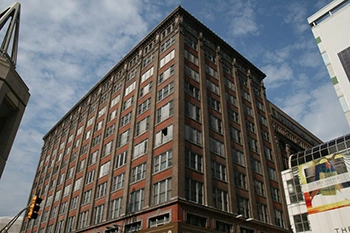
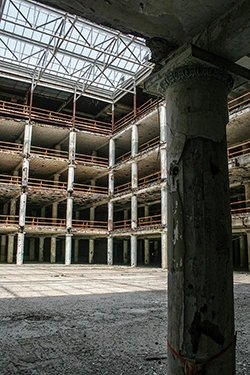 This building was constructed in 1907 originally as the Stix Baer & Fuller department store. It closed in 2002 along with the adjacent Saint Louis Center mall. Currently it is awaiting conversion into lofts. The company who began the project went bankrupt and thus it sits mostly gutted.
This building was constructed in 1907 originally as the Stix Baer & Fuller department store. It closed in 2002 along with the adjacent Saint Louis Center mall. Currently it is awaiting conversion into lofts. The company who began the project went bankrupt and thus it sits mostly gutted.
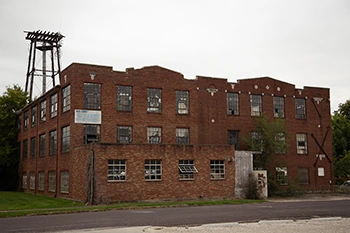
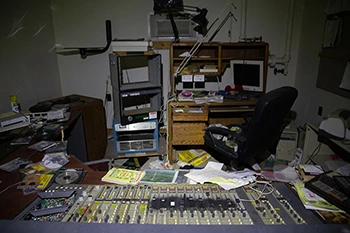 I wasn't sure what to expect going in here but it definitely wasn't a Radio Staion/80's clothing factory. This location was originally an International Shoe Company building. More recently it was home to an odd little blip in fashion history: Leggoons Sportswear. Based on a very short google search, I've determined that Leggoons was basically the embodiment of the 1980's in the form of loudly designed shorts. Unurprisingly when 1980's fashion trends came to an inglolrious end with the dawn of the 1990's, Leggoons failed to stay relevant. Their shop here lasted until 1996 when a note was posted to the employee time-clock board indicating their sudden closure. The internet also tells me that someone had since tried resurrecting the brand in the early 2010's and are still operating today.A few years after Leggoons vacated the premesis, a local radio station set up shop originally as a country station, then changed format to 90's alternative. The antenna was installed on the frame of the old water tower where it is still mounted. They went under in 2014 when the owner ran into financial difficulties and for reasons I don't understand, they appear to have left everything behind.
I wasn't sure what to expect going in here but it definitely wasn't a Radio Staion/80's clothing factory. This location was originally an International Shoe Company building. More recently it was home to an odd little blip in fashion history: Leggoons Sportswear. Based on a very short google search, I've determined that Leggoons was basically the embodiment of the 1980's in the form of loudly designed shorts. Unurprisingly when 1980's fashion trends came to an inglolrious end with the dawn of the 1990's, Leggoons failed to stay relevant. Their shop here lasted until 1996 when a note was posted to the employee time-clock board indicating their sudden closure. The internet also tells me that someone had since tried resurrecting the brand in the early 2010's and are still operating today.A few years after Leggoons vacated the premesis, a local radio station set up shop originally as a country station, then changed format to 90's alternative. The antenna was installed on the frame of the old water tower where it is still mounted. They went under in 2014 when the owner ran into financial difficulties and for reasons I don't understand, they appear to have left everything behind.
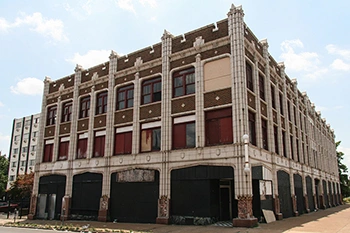
 The Melba Arcade once served as a grand entrance to a theater which sat directly behind it. It was later used as a mixed retail shopping center. The theater burned down in the 1960's, but fortunately this Gothic trimmed arcade style building remains.
The Melba Arcade once served as a grand entrance to a theater which sat directly behind it. It was later used as a mixed retail shopping center. The theater burned down in the 1960's, but fortunately this Gothic trimmed arcade style building remains.
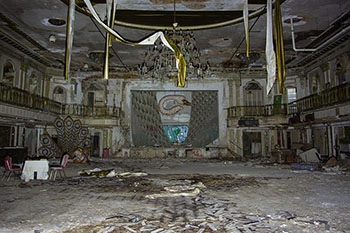
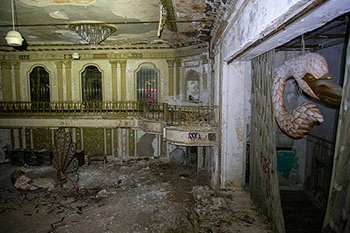 The Jefferson Hotel was the largest and probably most well-known hotel in the Saint Louis area throughout the first half of the 20th Century. It was hurriedly constructed in the early 1900's to assist in accomodating some of the 19.7 million guests who would attend the World's Fair. Construction broke ground in March of 1903 and work at the site would see sixteen hour days in order to meet the impending deadline. Prior to officially opening for business, this hotel was chosen as the location to inaugurate the social season of the World's Fair. A formal ball was held on April 8, 1904 and was sponsored by the Daughters of the Confederacy and the Confederate Memorial Society. The ball was said to be the "most strikingly brilliant social affair ever held" in the area and guests were reported to include "representatives of every civilized country, high World's Fair officials, soldiers, consuls and multimillionaires". The hotel was able to meet the construction deadline, opening on April 29th 1904, the day before the Fair was to begin. Among those registered at the hotel on the eve of the World's Fair included the official delegation of the U.S. Senate and House. President Theodore Roosevelt personally telegraphed the signal to commence the opening from the white house. The hotel would host several Democratic National Conventions throughout the years among other countless conventions and other events.
The Jefferson Hotel was the largest and probably most well-known hotel in the Saint Louis area throughout the first half of the 20th Century. It was hurriedly constructed in the early 1900's to assist in accomodating some of the 19.7 million guests who would attend the World's Fair. Construction broke ground in March of 1903 and work at the site would see sixteen hour days in order to meet the impending deadline. Prior to officially opening for business, this hotel was chosen as the location to inaugurate the social season of the World's Fair. A formal ball was held on April 8, 1904 and was sponsored by the Daughters of the Confederacy and the Confederate Memorial Society. The ball was said to be the "most strikingly brilliant social affair ever held" in the area and guests were reported to include "representatives of every civilized country, high World's Fair officials, soldiers, consuls and multimillionaires". The hotel was able to meet the construction deadline, opening on April 29th 1904, the day before the Fair was to begin. Among those registered at the hotel on the eve of the World's Fair included the official delegation of the U.S. Senate and House. President Theodore Roosevelt personally telegraphed the signal to commence the opening from the white house. The hotel would host several Democratic National Conventions throughout the years among other countless conventions and other events.
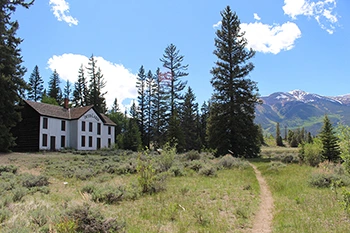
 Interlaken resort began as a hotel in the late 1800s which was located next to the Twin lakes in Colorado. James Dexter purchased the site in 1883 and expanded it into what was to become one of the top resort destinations in Colorado. It only lasted about 25 years before the Twin Lakes themselves were transformed into a reservoir which raised the water level and flooded the main road to the site. The lakes are now connected by a narrow channel in the middle. Interlaken subsequently closed in the early 1900's and it wasn't until the 1970s that the Bureau Of Reclamation stabilized the structures and preserved them from destruction. To reach Interlaken today you can either take a ~5 mile trail from the nearest parking lot or you can cross the lake(s). Our plan was to take a kayak to Interlaken which meant going through the small channel connecting the lakes, turning right and eventually parking the boat onshore right up next to the old resort. The kayak rental guy warned us that if we tipped over in the middle of the lake then we'd likely get hypothermia before reaching the shore. And we only had two hours to get there and back with the kayak. Awesome. Naturally the wind picked up right about the time we got on the lake. The water itself was exremely cold and the wind relentlessly pushed waves against us which just about completely absorbed the energy were burning off just to stay still.
Interlaken resort began as a hotel in the late 1800s which was located next to the Twin lakes in Colorado. James Dexter purchased the site in 1883 and expanded it into what was to become one of the top resort destinations in Colorado. It only lasted about 25 years before the Twin Lakes themselves were transformed into a reservoir which raised the water level and flooded the main road to the site. The lakes are now connected by a narrow channel in the middle. Interlaken subsequently closed in the early 1900's and it wasn't until the 1970s that the Bureau Of Reclamation stabilized the structures and preserved them from destruction. To reach Interlaken today you can either take a ~5 mile trail from the nearest parking lot or you can cross the lake(s). Our plan was to take a kayak to Interlaken which meant going through the small channel connecting the lakes, turning right and eventually parking the boat onshore right up next to the old resort. The kayak rental guy warned us that if we tipped over in the middle of the lake then we'd likely get hypothermia before reaching the shore. And we only had two hours to get there and back with the kayak. Awesome. Naturally the wind picked up right about the time we got on the lake. The water itself was exremely cold and the wind relentlessly pushed waves against us which just about completely absorbed the energy were burning off just to stay still.
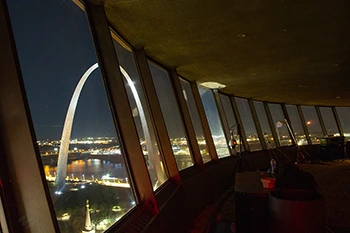
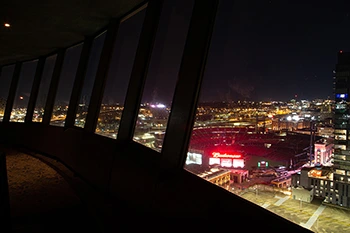 After breaking the hell out of my collarbone earlier this year and subsequently being on the disabled list for the entirety of summer 2022 (wearing a sling and going through physical therapy) I'm FINALLY off the DL and cleared to return to normal activities. And with this post, months of boring, stupid inactivity on the blog has come to a glorious end; BACKSTREET'S BACK, SON! Welcome to the return of boring, stupid activity on the blog! I can tell you're excited, but PLEASE CALM DOWN. As a bonus, this post comes with a little backstory and a couple extra sections with helpful tips and incoherent rambling!
After breaking the hell out of my collarbone earlier this year and subsequently being on the disabled list for the entirety of summer 2022 (wearing a sling and going through physical therapy) I'm FINALLY off the DL and cleared to return to normal activities. And with this post, months of boring, stupid inactivity on the blog has come to a glorious end; BACKSTREET'S BACK, SON! Welcome to the return of boring, stupid activity on the blog! I can tell you're excited, but PLEASE CALM DOWN. As a bonus, this post comes with a little backstory and a couple extra sections with helpful tips and incoherent rambling!
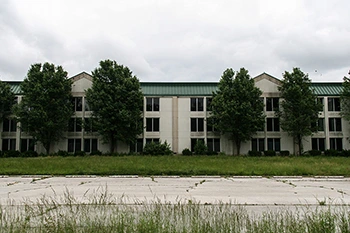
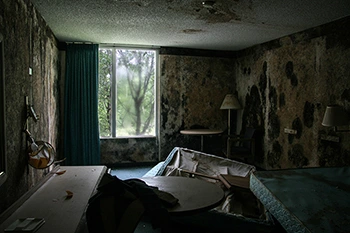 This hotel was in use as recently as January 2012, despite it being in such an advanced state of deterioration by our visit in mid-2013.
This hotel was in use as recently as January 2012, despite it being in such an advanced state of deterioration by our visit in mid-2013.
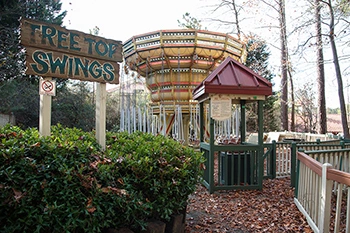
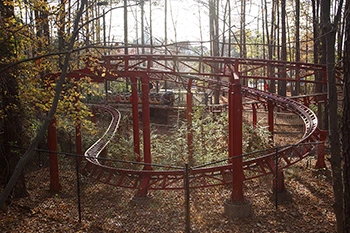 This themepark opened in 1990 and featured a variety of carinval rides and attractions designed for a young audience. The park closed in 2010.
This themepark opened in 1990 and featured a variety of carinval rides and attractions designed for a young audience. The park closed in 2010.
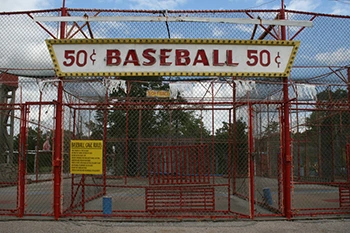
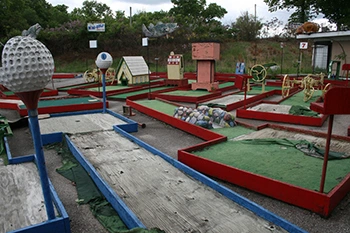 The Strip at the Lake of the Ozarks is an entertainment corridor located along the Bagnel Dam at the popular tourist destination Lake of the Ozarks in Missouri. As of the time of my visit, however, some of it had clearly fallen into disuse and neglect.
The Strip at the Lake of the Ozarks is an entertainment corridor located along the Bagnel Dam at the popular tourist destination Lake of the Ozarks in Missouri. As of the time of my visit, however, some of it had clearly fallen into disuse and neglect.
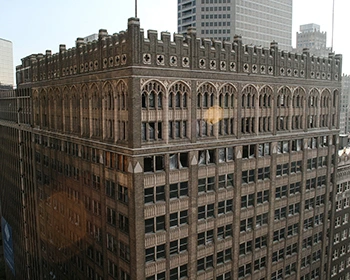
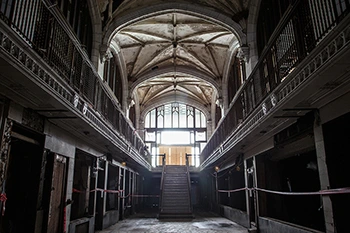 The original Wright building was constructed in 1906 as a retail shopping center. The design featured storefronts facing a vaulted atrium running the length of the building from the front to the back. In 1919, construction began on the addition which wrapped around the 18 story gothic structure. The new portion housed an additional 1000 commercial shops and when completed was "the highest concrete structure of its kind in the world" (St. Louis Star, May 22, 1920).
The original Wright building was constructed in 1906 as a retail shopping center. The design featured storefronts facing a vaulted atrium running the length of the building from the front to the back. In 1919, construction began on the addition which wrapped around the 18 story gothic structure. The new portion housed an additional 1000 commercial shops and when completed was "the highest concrete structure of its kind in the world" (St. Louis Star, May 22, 1920).
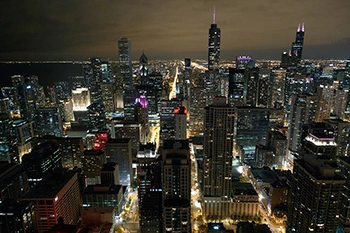
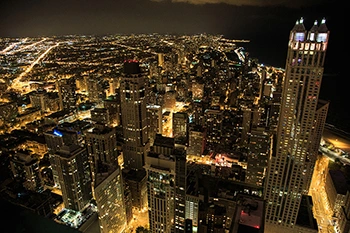 There were two ledges involved.. They were only separated by about 3 feet or so. But it was enough that you didn't have a great hold on either side as you crossed over. Close enough that if you are relaxed and you don't over think the gap, it really shouldn't be a problem, in most situations. But in this case, the gap happened to be roughly 75-100 feet above the ground. I'm not really sure of the exact height because I didn't want to look down long enough to figure it out. Either way, you're dead. This was far sketchier than anything I've done before in terms of height and it was messing with my head. I tried to just look at the ledge I was on and look at the ledge I needed to be on and make it happen. I reached out to it a couple of times as a warm up, trying to reassure myself that it's not that far. I decided to just do it, get it over with. I extended my leg to the other side, stretched further than it seemed like it should be. I let go of one hand on my ledge and began to grasp at the other ledge.
There were two ledges involved.. They were only separated by about 3 feet or so. But it was enough that you didn't have a great hold on either side as you crossed over. Close enough that if you are relaxed and you don't over think the gap, it really shouldn't be a problem, in most situations. But in this case, the gap happened to be roughly 75-100 feet above the ground. I'm not really sure of the exact height because I didn't want to look down long enough to figure it out. Either way, you're dead. This was far sketchier than anything I've done before in terms of height and it was messing with my head. I tried to just look at the ledge I was on and look at the ledge I needed to be on and make it happen. I reached out to it a couple of times as a warm up, trying to reassure myself that it's not that far. I decided to just do it, get it over with. I extended my leg to the other side, stretched further than it seemed like it should be. I let go of one hand on my ledge and began to grasp at the other ledge.
The City Club building, also known as the Alverne, was constructed in 1923. As the City Club, it provided a forum and meeting place for persons active in civic and social issues and was notably inclusive of race, religion and gender among its speakers. The club claimed to have over 700 speakers "representing every quarter of the globe" and "virtually every race and nationality". The City Club addressed issues both locally and globally and sought engagement from its members in solving problems. In the mid 1920's, the Saint Louis branch of this organization counted 3700 members. This was a time when social clubs were at their height of popularity and this was the peak of the City Club's membership. And it wasn't all serious business. In 1928, City Club opened a rooftop mini-golf course and it's said that the Mayor had 5 holes-in-one on opening day. The October 1928 newsletter had a commentary on this course as follows: "Players losing their ball (over the edge of the building) must signal the following players to go through, after which they may hide in the pantry in the 14th floor until danger from enraged pedestrians is passed." Other notable amenities were offered here; its multiple dining rooms served lunch to leading politicians and businessmen of the day, billiards lessons were offered to members' sons, musical programs and regular dances were just some of the perks.
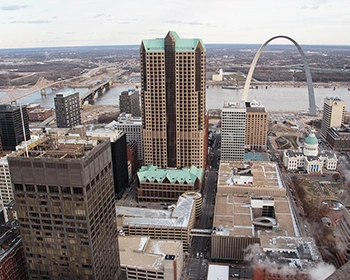
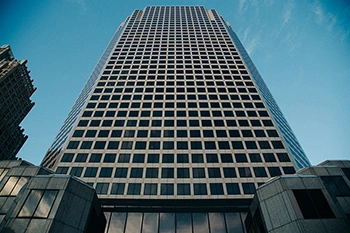 This location is one of the tallest buildings in Saint Louis and has been the subject of some controversy after it was announced that it would be vacated. Naturally we began to eye the place up. But we soon discovered that although the major tenant has in fact moved out, there are still some active offices on the upper floors. My valiant comrade and I nevertheless found our way inside and made it to the very rooftopiest hatch only to find a big padlock in our way. Fortunately, the next roof platform one flight of stairs down from there was not secured in such a way as to deny our advances. We opened the door to the glorious howling of air currents above Saint Louis at heights that are normally reserved for the flying rats we call pigeons. Tall buildings seemed small and humans were no longer easily distinguishable. After enjoying the view from the roof, we proceeded down to the executive level, the topmost habitable portion of the skyscraper. We found chandeliers, ugly contemporary paintings and a large, but sadly empty, bar. We carefully made our way around inside while looking for motion sensors or alarms and found no obvious signs. Soon, however, I opened a hall closet on the South-East corner of the top level and found an alarm panel which was lit up light a Christmas tree. Evidently silent, and well hidden, alarms are the current situation here. We immediately headed for the exits just as security was making their way after us. But luck was on our side and the day was won by the good guys as we exited without incident.
This location is one of the tallest buildings in Saint Louis and has been the subject of some controversy after it was announced that it would be vacated. Naturally we began to eye the place up. But we soon discovered that although the major tenant has in fact moved out, there are still some active offices on the upper floors. My valiant comrade and I nevertheless found our way inside and made it to the very rooftopiest hatch only to find a big padlock in our way. Fortunately, the next roof platform one flight of stairs down from there was not secured in such a way as to deny our advances. We opened the door to the glorious howling of air currents above Saint Louis at heights that are normally reserved for the flying rats we call pigeons. Tall buildings seemed small and humans were no longer easily distinguishable. After enjoying the view from the roof, we proceeded down to the executive level, the topmost habitable portion of the skyscraper. We found chandeliers, ugly contemporary paintings and a large, but sadly empty, bar. We carefully made our way around inside while looking for motion sensors or alarms and found no obvious signs. Soon, however, I opened a hall closet on the South-East corner of the top level and found an alarm panel which was lit up light a Christmas tree. Evidently silent, and well hidden, alarms are the current situation here. We immediately headed for the exits just as security was making their way after us. But luck was on our side and the day was won by the good guys as we exited without incident.
The Alexa Chemical building was constructed in 1896 by the Chemical Building Company as new facilities for the Chemical national bank, although it was never actually used in that capacity. A few notable Saint Louis business occupied space here over the years including a school for secretaries and even the legendary local cafeteria called Miss Hullings, which opened its first location here.
The building is mostly vacant now and has been for a long time. But a recent foreclosure and purchase means the building will likely be renovated very soon.
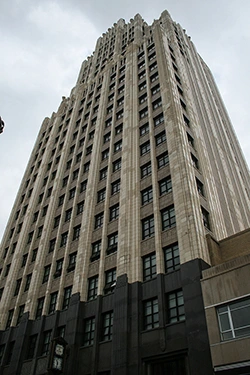
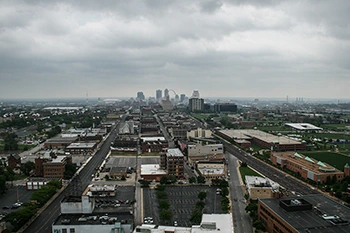 The Continental Life Building had been abandoned for years, but it has been renovated and is now nearly finished. Only part of the first floor remains to be remodeled for some commercial space. It's a nice building and the view from the roof is the only of its kind in the area as it's easily the tallest building in this part of town. When I was almost done, the cleaning crew spotted me coming back into the topmost suite, from the roof. As I headed for the elevators, the guy asked me if I was "looking for someone". I don't know who he thought I could have been looking for, on the roof, but I'm sure we could have had an interesting conversation out there, high above the traffic.
The Continental Life Building had been abandoned for years, but it has been renovated and is now nearly finished. Only part of the first floor remains to be remodeled for some commercial space. It's a nice building and the view from the roof is the only of its kind in the area as it's easily the tallest building in this part of town. When I was almost done, the cleaning crew spotted me coming back into the topmost suite, from the roof. As I headed for the elevators, the guy asked me if I was "looking for someone". I don't know who he thought I could have been looking for, on the roof, but I'm sure we could have had an interesting conversation out there, high above the traffic.
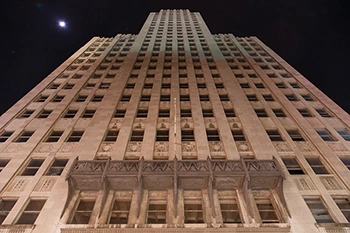
 KCPL was constructed in the 1930's and was the tallest building in the area at that time. The original occupants inhabited the space until the 1990's. Currently, it is undergoing conversion into lofts.
KCPL was constructed in the 1930's and was the tallest building in the area at that time. The original occupants inhabited the space until the 1990's. Currently, it is undergoing conversion into lofts.
This place was a lot of fun. Thanks go to my comrades who made this one possible. Elevator rides to the top made exploring such a tall building much less work than I'm accustomed to. The top featured unparalleled views of the city in all directions and we arrived just as the sun was setting. The blustery winds carried the noises and smells of the city all the way up to our clandestine observatory. Enjoying our various illegitimately acquired views of the world around us are some of my favorite moments that only this hobby can provide. And at the low price of free* (*if you do it right), you really can't beat it. I could have stayed up there all night, but we had some shenanigans to engage in later (the true height of the levels of ridiculousness that our shenanigans would reach was not entirely apparent from the outset, but I can assure you that many shenanigans were had on this night).
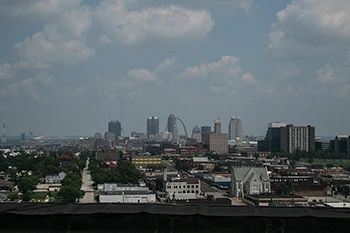
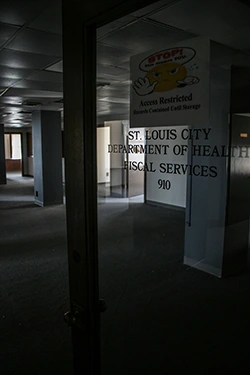 This was, at one time, the headquarters of the Saint Louis Health Department.
This was, at one time, the headquarters of the Saint Louis Health Department.
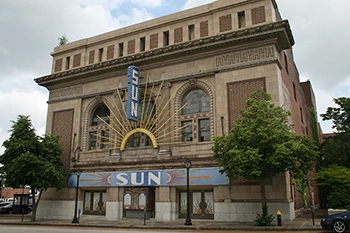
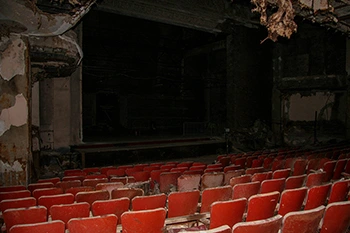 The Sun Theater in Saint Louis was built just prior to WWI in 1913 as the Victoria Theater. It has undergone several name-changes throughout the years, becoming a Jazz club and even an X-rated movie theater, until eventually obtaining its current designation as the Sun. It has been abandoned since its last occupants, the Faith Tabernacle, left in 1981.
The Sun Theater in Saint Louis was built just prior to WWI in 1913 as the Victoria Theater. It has undergone several name-changes throughout the years, becoming a Jazz club and even an X-rated movie theater, until eventually obtaining its current designation as the Sun. It has been abandoned since its last occupants, the Faith Tabernacle, left in 1981.
The Majestic Theater opened in 1928 in East Saint Louis and was known as a movie palace. It was notable for being the first theater in the city to feature modern air conditioning. The first shows here were "Spotlight" starring Esther Ralston and "Sporting Goods" starring Richard Dix. After installing a new "vitaphone" system, the Majestic theater became the first theater in southern Illinois to show motion pictures with synchronized dialogue and the first film shown here which took advantage of this system was "Warming Up" starring Richard Dix. This is actually the second Majestic Theater at this location. The first one opened in 1909 but burned to the ground in 1927. The new Majestic theater closed in the 1960s. And now, inside it is pitch black and mostly gutted, the only light inside comes from the roof behind the stage. This makes photography challenging. For this reason, I had to resort to using HDR with multiple exposures stacked on each other. I'm not a fan of HDR but in this case I had no other choice.
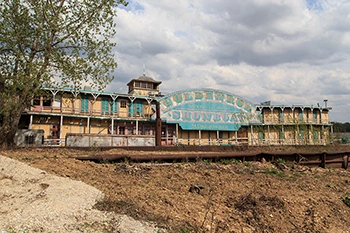
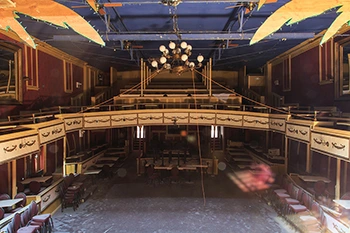 "The Goldenrod Showboat was built in 1909 by the Pope Dock Company of Parkersburg West Virginia at a cost of $75,000. 200 feet long and 45 feet wide with an auditorium of 162 feet long, it had a seating capacity of 1,400. In 1910, 22 showboats visited 15 states as part of their regular route along the Mississippi. By 1938, only four remained in operation and by 1943 the Goldenrod was the last of its kind still touring. Goldenrod was the last showboat operational on the Mississippi. Under Capt Bill Menke, she was moored at the Saint Louis riverfront in 1937. In 1947, the original wooden hull was placed into a steel barge by the Saint Louis Shipbuilding & Steel company. By 1950, she had been partially sunk and salvaged twice. On June 1, 1962, a disastrous fire all but destroyed the superstructure of the autitorium and caused severe damage to the entire structure. The Goldenrod was then purchased by a group of Saint Louis businessmen and was subsequently restored to her original glory. Many of the new furnishings came from old Saint Louis mansions that were being demolished. When the $300,000 renovation was completed, Goldenrod had her Grand Re-Opening in May, 1965. In 1967, she was registered as a National Historic Landmark. Eventually, the city of Saint Charles purchased the Goldenrod and she was subsequently moved there. In 2001, she was run aground and closed due to repairs. She was eventually moved to Kampsville, Illinois and was eventually sold for $5,000. After changing hands several times through various circumstances, she was ultimately destroyed by issues related to mooring and finally the destructive fire which brought about her demise."
"The Goldenrod Showboat was built in 1909 by the Pope Dock Company of Parkersburg West Virginia at a cost of $75,000. 200 feet long and 45 feet wide with an auditorium of 162 feet long, it had a seating capacity of 1,400. In 1910, 22 showboats visited 15 states as part of their regular route along the Mississippi. By 1938, only four remained in operation and by 1943 the Goldenrod was the last of its kind still touring. Goldenrod was the last showboat operational on the Mississippi. Under Capt Bill Menke, she was moored at the Saint Louis riverfront in 1937. In 1947, the original wooden hull was placed into a steel barge by the Saint Louis Shipbuilding & Steel company. By 1950, she had been partially sunk and salvaged twice. On June 1, 1962, a disastrous fire all but destroyed the superstructure of the autitorium and caused severe damage to the entire structure. The Goldenrod was then purchased by a group of Saint Louis businessmen and was subsequently restored to her original glory. Many of the new furnishings came from old Saint Louis mansions that were being demolished. When the $300,000 renovation was completed, Goldenrod had her Grand Re-Opening in May, 1965. In 1967, she was registered as a National Historic Landmark. Eventually, the city of Saint Charles purchased the Goldenrod and she was subsequently moved there. In 2001, she was run aground and closed due to repairs. She was eventually moved to Kampsville, Illinois and was eventually sold for $5,000. After changing hands several times through various circumstances, she was ultimately destroyed by issues related to mooring and finally the destructive fire which brought about her demise."

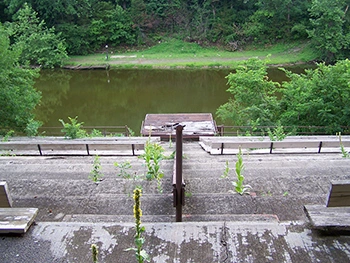 I went camping this weekend and was surprised to find this abandoned outdoor theater. The seats are on one side of the lake and the stage is on the opposite side, thus utilizing the geography as a natural amphitheater. Apparently there used to be several prop buildings on the stage side and even a riverboat at one time.
I went camping this weekend and was surprised to find this abandoned outdoor theater. The seats are on one side of the lake and the stage is on the opposite side, thus utilizing the geography as a natural amphitheater. Apparently there used to be several prop buildings on the stage side and even a riverboat at one time.
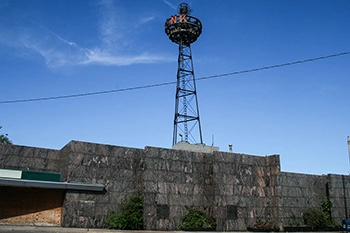
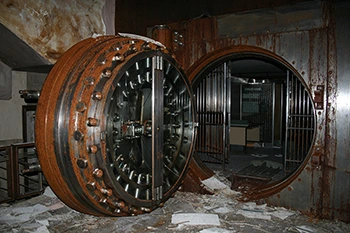 The Sky Bank and Trust, aka State Bank or Wellston Bank was built in the 1940's and saw use as late as 2006 when it last functioned as a Regions Bank. It's hard to imagine it was being used that recently, however, considering that the decor appears potentially original and the basement is completely flooded. The overall condition suggests it had been vacant for much longer. Inside it is very dark and moldy. The floors are buckling from the humidity of a basement full of murky water and the giant steel safe doors are beginning to rust away.
The Sky Bank and Trust, aka State Bank or Wellston Bank was built in the 1940's and saw use as late as 2006 when it last functioned as a Regions Bank. It's hard to imagine it was being used that recently, however, considering that the decor appears potentially original and the basement is completely flooded. The overall condition suggests it had been vacant for much longer. Inside it is very dark and moldy. The floors are buckling from the humidity of a basement full of murky water and the giant steel safe doors are beginning to rust away.
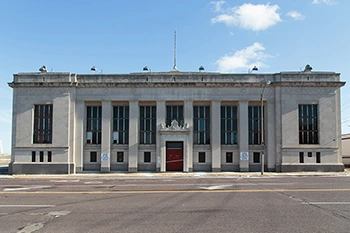
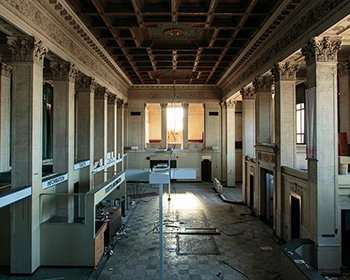 The Cass Bank and Trust Building was constructed in 1927, the same year the Ford Model A was introduced. This was a tumultuous time for transportation in general which meant that customer traffic was going to be evolving rapidly and Cass Bank would need to change along with it in order to survive. Over the subsequent years, they did just that as they worked to continually tailor products and services to meet their customer's needs. For example, when a new highway was constructed in the 1950s which divided the neighborhood and brought increasingly concentrated industrial facilities and truck terminals into the area, Cass Bank constructed a drive up facility in 1957 on the east side of the bank along with walk up teller windows to serve these clients and in so doing boasted that they were the first of their kind. Ten years later, in 1967, they were one of the first banks in the nation to utilize electronic computers to process payroll. Cass Bank eventually vacated this building in 1988 and it sat vacant until 1991 when it became a Greyhound Bus Station. Greyhound remained at this location for 17 years until ultimately moving to another location in 2008. It has been vacant since Greyhound left and has been in a steady decline since then. There were talks of converting this property into a Veterans Center, a role that would be beneficial in this area, but as of 2016 this project still hasn't come together.
The Cass Bank and Trust Building was constructed in 1927, the same year the Ford Model A was introduced. This was a tumultuous time for transportation in general which meant that customer traffic was going to be evolving rapidly and Cass Bank would need to change along with it in order to survive. Over the subsequent years, they did just that as they worked to continually tailor products and services to meet their customer's needs. For example, when a new highway was constructed in the 1950s which divided the neighborhood and brought increasingly concentrated industrial facilities and truck terminals into the area, Cass Bank constructed a drive up facility in 1957 on the east side of the bank along with walk up teller windows to serve these clients and in so doing boasted that they were the first of their kind. Ten years later, in 1967, they were one of the first banks in the nation to utilize electronic computers to process payroll. Cass Bank eventually vacated this building in 1988 and it sat vacant until 1991 when it became a Greyhound Bus Station. Greyhound remained at this location for 17 years until ultimately moving to another location in 2008. It has been vacant since Greyhound left and has been in a steady decline since then. There were talks of converting this property into a Veterans Center, a role that would be beneficial in this area, but as of 2016 this project still hasn't come together.
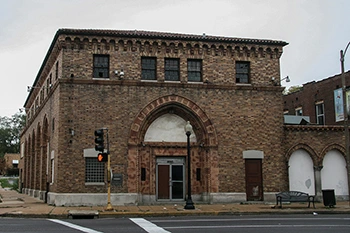
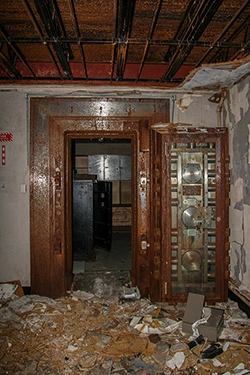 Boatmen's Bank was founded in Saint Louis in 1847 and claimed to be the oldest bank west of the Mississippi. George Knight Budd started Boatmen's Savings Institution to serve the working class and named the company for those "Boatmen" who worked on riverboats on the Mississippi.
Boatmen's Bank was founded in Saint Louis in 1847 and claimed to be the oldest bank west of the Mississippi. George Knight Budd started Boatmen's Savings Institution to serve the working class and named the company for those "Boatmen" who worked on riverboats on the Mississippi.
On April 5, 1854, a robbery occurred in which "the bank's secretary Joseph Thornton was implicated because the vault had been opened at night with a bank key. Testifying against him was Joseph Charless, president of the Bank of Missouri, who had received for deposit water and mud-soaked notes from Thornton. Thornton was acquitted but was to shoot and kill Charless on the street afterwards. Thornton was nearly lynched, and later hanged following a trial." -Wikipedia. Boatmen's would become the largest bank in Missouri in the 1980's. By the time of its acquisition by Nations Bank in 1996, it was one of the 30 largest Bank Holding Companies in the United States. I'm not sure of the exact date of closure on this branch but I would guess that it didn't last very long, if at all, after the company's acquisition.
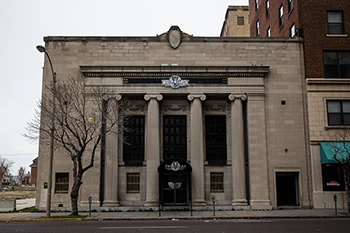
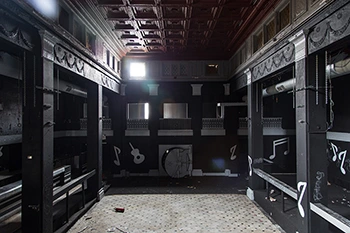 Here, we found ourselves inside an unusual bank-turned-nightclub somehwere in Saint Louis.
Here, we found ourselves inside an unusual bank-turned-nightclub somehwere in Saint Louis.
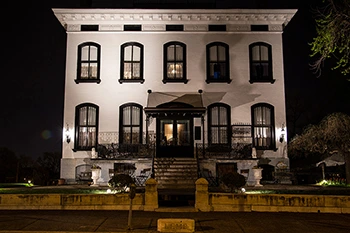
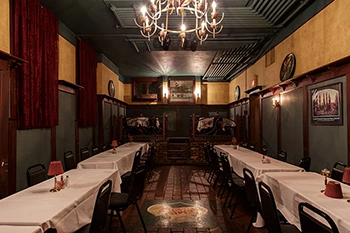 "The Lemp Mansion is the site of three suicides by Lemp family members after the death of the son Frederick Lemp, whose William J. Lemp Brewing Co. dominated the St. Louis beer market before Prohibition with its Falstaff beer brand. The mansion is said to be haunted by members of the Lemp family. The house was built in 1868 by St. Louisian Jacob Feickert. William J. Lemp and his wife, Julia, moved into the mansion in 1876. In 1911, the house underwent major renovations including conversion of some space into offices for the Lemp Brewery. The Lemps lived in the house until 1949 when Charles Lemp committed suicide."
"The Lemp Mansion is the site of three suicides by Lemp family members after the death of the son Frederick Lemp, whose William J. Lemp Brewing Co. dominated the St. Louis beer market before Prohibition with its Falstaff beer brand. The mansion is said to be haunted by members of the Lemp family. The house was built in 1868 by St. Louisian Jacob Feickert. William J. Lemp and his wife, Julia, moved into the mansion in 1876. In 1911, the house underwent major renovations including conversion of some space into offices for the Lemp Brewery. The Lemps lived in the house until 1949 when Charles Lemp committed suicide."
"In 1950, the mansion became a boarding house. The construction of Interstate 55 during the 1960s led to the destruction of much of the grounds and one of the carriage houses."
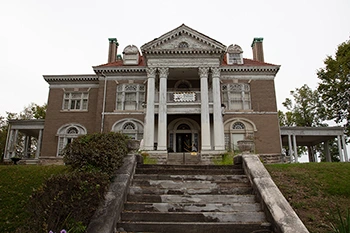
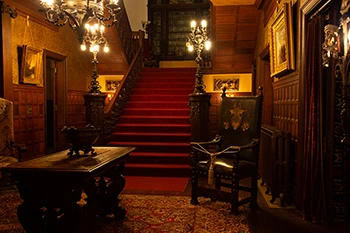 Rockcliffe Mansion was constructed from 1898 to 1900 in Hannibal, Missouri for the wealthy lumber baron John J. Cruikshank, Jr. The mansion is a large 2 1/2 story double-brick house with white trim situated at the top of a large hill in the center of town with a commanding view of the area. The front of the house features a two story portico of paired Corinthian columns with a second floor balcony. The East side of the house features an expansive single story "porte cochere" with Tuscan columns. Originally the porches were connected but a fire destroyed that portion. Inside, there are more than 30 rooms and 10 unique ornate fireplaces. The interior is detailed in rich Mahogany and Quarter Sawn Oak in the Late Victorian and Art Nouveau styles. The main staircase rises to a large Tiffany stained glass window on the north facade and from there it splits into two rounded staircases to the second floor. The light fixtures throughout are an unusual dual purpose gas/electric type. The hall and reception room are oak while the library and dining room are mahogany. The "Moorish Room" features scalloped horseshoe and ogee arches on Corinthian columns and the room has its own custom Tiffany stained glass windows on the east wall. It is said that Louis Tiffany himself designed the entirety of the Moorish Room. Throughout the rest of the house, you will find the highest quality down to the smallest detail; all plumbing fixtures by J.L. Mott Iron Works and hardware by Yale and Towne. Most of the furnishings and fixtures in the house today are the antique originals despite the house being abandoned for 43 years.
Rockcliffe Mansion was constructed from 1898 to 1900 in Hannibal, Missouri for the wealthy lumber baron John J. Cruikshank, Jr. The mansion is a large 2 1/2 story double-brick house with white trim situated at the top of a large hill in the center of town with a commanding view of the area. The front of the house features a two story portico of paired Corinthian columns with a second floor balcony. The East side of the house features an expansive single story "porte cochere" with Tuscan columns. Originally the porches were connected but a fire destroyed that portion. Inside, there are more than 30 rooms and 10 unique ornate fireplaces. The interior is detailed in rich Mahogany and Quarter Sawn Oak in the Late Victorian and Art Nouveau styles. The main staircase rises to a large Tiffany stained glass window on the north facade and from there it splits into two rounded staircases to the second floor. The light fixtures throughout are an unusual dual purpose gas/electric type. The hall and reception room are oak while the library and dining room are mahogany. The "Moorish Room" features scalloped horseshoe and ogee arches on Corinthian columns and the room has its own custom Tiffany stained glass windows on the east wall. It is said that Louis Tiffany himself designed the entirety of the Moorish Room. Throughout the rest of the house, you will find the highest quality down to the smallest detail; all plumbing fixtures by J.L. Mott Iron Works and hardware by Yale and Towne. Most of the furnishings and fixtures in the house today are the antique originals despite the house being abandoned for 43 years.
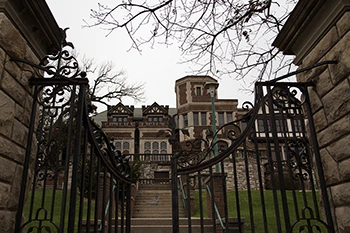
 This house was constructed in the early 1900's as a private residence for a wealthy local businessman. He died only a few years after completion of the house. Since then, the house has become infamous for reported hauntings and was even featured on Unsolved Mysteries as one of the "most haunted" locations. Supposedly, even the businessman himself haunts the building and turns off light-switches (presumably to save on energy costs-you know how stingy wealthy people can be) and engages in other spiritual shenanigans. Unfortunately, we had no spooky encounters during our lengthy exploration of this site and no ghosts were harmed in the making of this post.
This house was constructed in the early 1900's as a private residence for a wealthy local businessman. He died only a few years after completion of the house. Since then, the house has become infamous for reported hauntings and was even featured on Unsolved Mysteries as one of the "most haunted" locations. Supposedly, even the businessman himself haunts the building and turns off light-switches (presumably to save on energy costs-you know how stingy wealthy people can be) and engages in other spiritual shenanigans. Unfortunately, we had no spooky encounters during our lengthy exploration of this site and no ghosts were harmed in the making of this post.
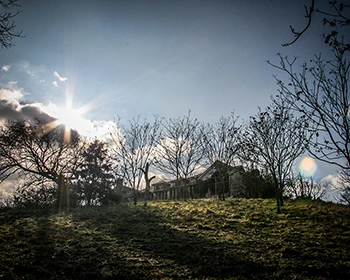
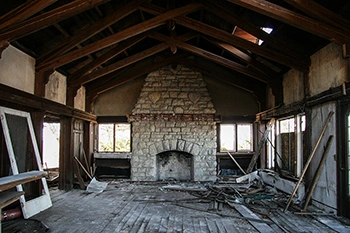 This mansion was built in 1915 by a family that was to be an integral part of Saint Louis industry well into the 20th century. Mark Kerckhoff was a German immigrant who started a butter route to Saint Louis in 1887, to which he would later add milk.. and with that, Pevely Dairy was born. Their big break came when they won the dairy concession at the 1904 World's Fair in Saint louis from which point the business took off. Sometime around 1915, they began construction on the famous Pevely Dairy Plant with the iconic sign that stood for nearly 100 years on Chouteau avenue. The massive Pevely Dairy Farm stood on the same property as this mansion, just a short walk away.
This mansion was built in 1915 by a family that was to be an integral part of Saint Louis industry well into the 20th century. Mark Kerckhoff was a German immigrant who started a butter route to Saint Louis in 1887, to which he would later add milk.. and with that, Pevely Dairy was born. Their big break came when they won the dairy concession at the 1904 World's Fair in Saint louis from which point the business took off. Sometime around 1915, they began construction on the famous Pevely Dairy Plant with the iconic sign that stood for nearly 100 years on Chouteau avenue. The massive Pevely Dairy Farm stood on the same property as this mansion, just a short walk away.
The reign of Pevely as the king of Saint Louis dairy products would end, however when the business was bought out and the original location shut down. Everything that once bore the Pevely Dairy name is now demolished which means this blog is now the only place you'll see all of these locations.
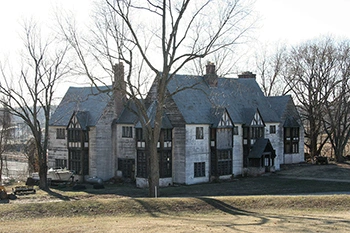
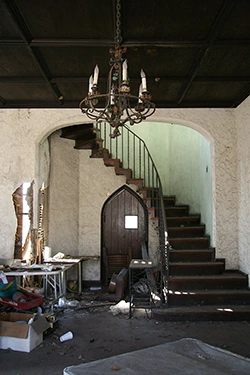 This house was built in the early 1900s by a prominent Saint Louisan George F. Wood-Smith who is mostly remembered for the unfinished castle he was building nearby.
This house was built in the early 1900s by a prominent Saint Louisan George F. Wood-Smith who is mostly remembered for the unfinished castle he was building nearby.
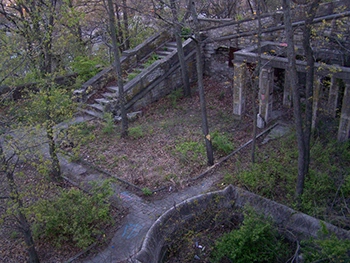
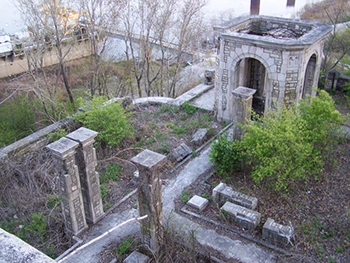 Wood-Smith Castle was constructed in 1914, but the site was left abandoned and unfinished by 1920.
Wood-Smith Castle was constructed in 1914, but the site was left abandoned and unfinished by 1920.
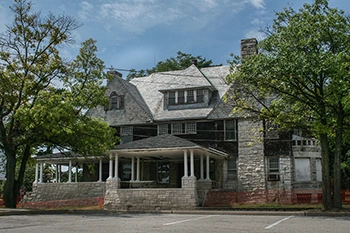
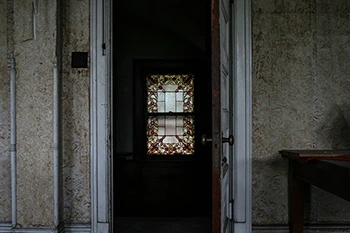 The Brownhurst Mansion was built in approximately 1892 for Daniel Sidney Brown, son of the founder of the Pioneer Steam Keg Works (later the Pioneer Cooperage Company). Brown, an avid horticulturalist, was known for cultivating rare orchids and other species of plants on his once vast estate. The mansion has been owned by the Society of Mary since 1918. It has been sitting vacant since 1989. Despite the fact that this historic building is in good shape overall, the current owners want it demolished and soon, it will be.
The Brownhurst Mansion was built in approximately 1892 for Daniel Sidney Brown, son of the founder of the Pioneer Steam Keg Works (later the Pioneer Cooperage Company). Brown, an avid horticulturalist, was known for cultivating rare orchids and other species of plants on his once vast estate. The mansion has been owned by the Society of Mary since 1918. It has been sitting vacant since 1989. Despite the fact that this historic building is in good shape overall, the current owners want it demolished and soon, it will be.
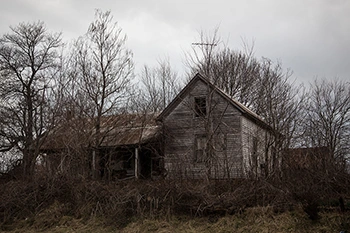
This is a very old farmhouse which started out as a log cabin.
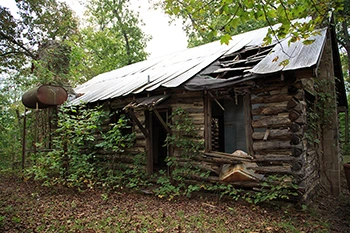
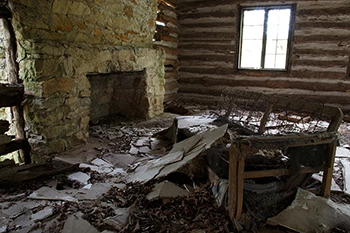 While out looking for a new kayaking spot along the river we stumbled across a log cabin crumbling away in the woods. It's definitely old, but probably not as old as it looks; Based on my limited knowledge of such things I'd place it around 1940's construction because of the wiring, plumbing and other details. I could be wrong, though. I haven't been able to find any history on it yet. This cabin wasn't the only interesting find. Just down a short path from the cabin sits a secluded lake. Then, further into the woods from the lake are several very old barns and another old house with a cellar. I didn't go inside the second house because the window frame would have probably broken off under my weight but it looked totally empty inside, aside from some old patio furniture that had been used to furnish the house as a hunter's lodge but which likely hadn't been used in a couple decades. Lastly, not far from here is a bridge which hasn't seen traffic in quite some time.
While out looking for a new kayaking spot along the river we stumbled across a log cabin crumbling away in the woods. It's definitely old, but probably not as old as it looks; Based on my limited knowledge of such things I'd place it around 1940's construction because of the wiring, plumbing and other details. I could be wrong, though. I haven't been able to find any history on it yet. This cabin wasn't the only interesting find. Just down a short path from the cabin sits a secluded lake. Then, further into the woods from the lake are several very old barns and another old house with a cellar. I didn't go inside the second house because the window frame would have probably broken off under my weight but it looked totally empty inside, aside from some old patio furniture that had been used to furnish the house as a hunter's lodge but which likely hadn't been used in a couple decades. Lastly, not far from here is a bridge which hasn't seen traffic in quite some time.
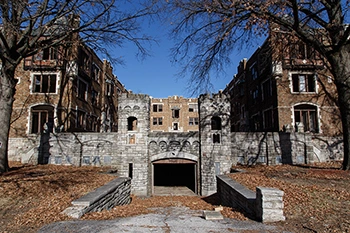
 The Castle Apartment Building was built in 1925. It is currently on the market awaiting an investor.
The Castle Apartment Building was built in 1925. It is currently on the market awaiting an investor.